


www.caferacermag.com
This issue is possible thanks to the hard work, diligence and motorcycling experience of these folks who started off riding on these machines:
Editor and Publisher, Mike Seate: Yamaha XS650
Kim Love, Managing Editor: Suzuki GS450E
Matt Wiley, Tech Editor: Suzuki GT185
Simon Everett, Chief Photographer: BSA Bantam
Contributors Likely Learning to Ride Aboard Sears Mopeds
Blair Powell: Honda C90
Nick Coumos: Norton Dominator 99
Jose Gallina: Ducati 175 Sport
Paul D. Stanstead: Rudge Ulster
Gary Hallobeck: Honda CB350
Mark Mederski: Honda SL350
Manny Pandya: Kawasaki W650
Jay LaRossa: Honda Aero 50
Renee Rosensteel: Bus Pass
Advertising Sales: Ann Curtis can be reached at adsales@caferacermag.com or (412) 463-5559

Customer Service issues? Reach out to the unflappable George Krisher via support@caferacermag.com or give him a bell at (412) 627-4104.
Magazine layout and graphics done to dazzling perfection by Cindy Segrest
Web design by Christy Sparks who rides a mean Suzuki Savage 650.
Staging a classic, custom or cafe-themed event? Keep us in the loop by emailing us your press releases, flyers, posters and general information to rockersrule@caferacermag.com. Make sure the documents and images are high-resolution for possible reproduction in this here print magazine and give us some lead time; we can’t publicize an event happening the same week that the message arrives.
Cafe Racer magazine is published six times yearly by the staff, friends and fellow riders here at Beaverbrook Publications LLC. We’re stoked to be in the midst of preparing for our annual Readers Ride-In Custom Show, a mad-hectic weekend that stretches our small-butdedicated staff to its physical limits all in the service of giving our fellow speed freaks a glorious day to celebrate the pure, unfettered adrenaline rush of low bars and high performance. Each year we hear from folks who couldn’t make it to Western Pennsylvania for the event but had built incredible machines they’d hoped to show off. Not to worry, we’re seriously considering staging a West Coast event in 2024...stay tuned.
CONTENTS
Café Racer Magazine
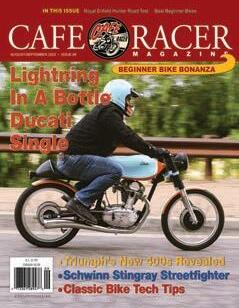
AUGUST/SEPTEMBER 2023 • Issue #88
On The Cover: Our So Cal shooter Jose Gallina brings us this classic Ducati Sport 175 single, a rare Italian thumper featuring some outstanding mods and performance upgrades the folks back in Bologna never dreamed of. Dig it the most on page 46. The small-bore beauty is all part of our special, Beginner Bike Bonanza section aimed at helping new and re-emerging riders find the right machines.
See the regular goings-on of your favorite CRM staffers via the Instagram feeds of editor Mike Seate via @mikeseate and managing editor Kim Love via @love2ride650. Photographer Jose Gallina’s twowheeled world awaits @josegallina.
FEATURES
Best Beginner Bikes 40 Starter Wheels for Everybody
Book Review 44
The Craft and Art of Motorcycling
Lightning In A Bottle Ducati 46 Vineyard Special
COLUMNS
Open Mike 6 The New Frontier
REGULAR SECTIONS
Fastlane News 12
Triumph’s New 400 Singles
First Ride 14
Royal Enfield Hunter 350
First Ride 20
Triumph Trident 660
The Paddock 26 Motorcycle News and New Bikes
TECH SECTION
Honda CB450 78
Top Tips for Classic Bikes 80
Fat Featherbed Triton 84
Gauging The Speed
Made To Order Triumph 56
A Speed Triple Like No Other
The Stingray 64
Schwinn Meets XS650
Staff Rides 76
Blair’s Enfield GT
Random Ramblings 8 One Size Does Not Fit All
The Master Class 10 Are You a Good Motorcycle Steward?
Top Gear 34
The Latest Kit for Rider and Bike
Curbside Customs 36
Home-brewed Specials
The Market 54
Motorcycle Sales Scams
Stylin’ 70
When Ugly Rules
Custom Scene 72 Valhalla 2023
Moto Guzzi V9 Bobber Sport 86
New Shock Install

Combination Commando 88 Drawn Back to the Dommie
Workshop Files 90 Mechanical Problems Sorted

Open Mike
The New Frontier
By Editor and Publisher Mike Seate
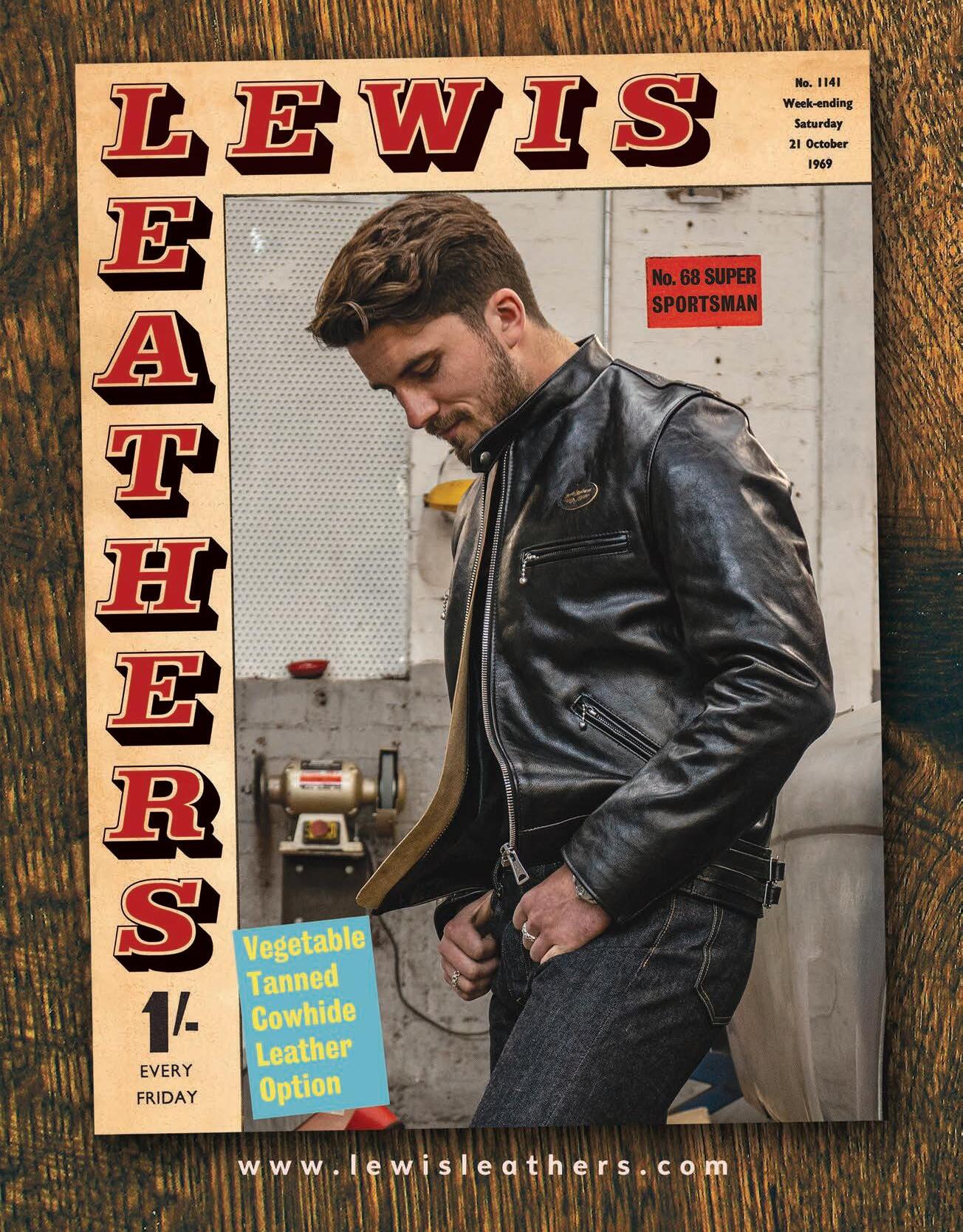

While attending the recent AIMExpo motorcycle industry event in Las Vegas, I was struck by many strange and unusual things. No, I’m not referring to the casino hotel minifridge, equipped with electronic sensors that would alert security if I placed my own beverages or food inside (and assessed a $50 fee, no less) and no, it wasn’t just the absurdity of paying $12 for a slice of pizza. It was the expo itself, which represents the current motorcycle industry from OEM bikes to aftermarket suppliers, and the plethora of Chinese motorcycle manufacturers on hand.
I’d been hearing much about the advent of the Chinese streetbike market in the past months, and we even got a chance to road test a Benelli 500c scrambler a few issues back.
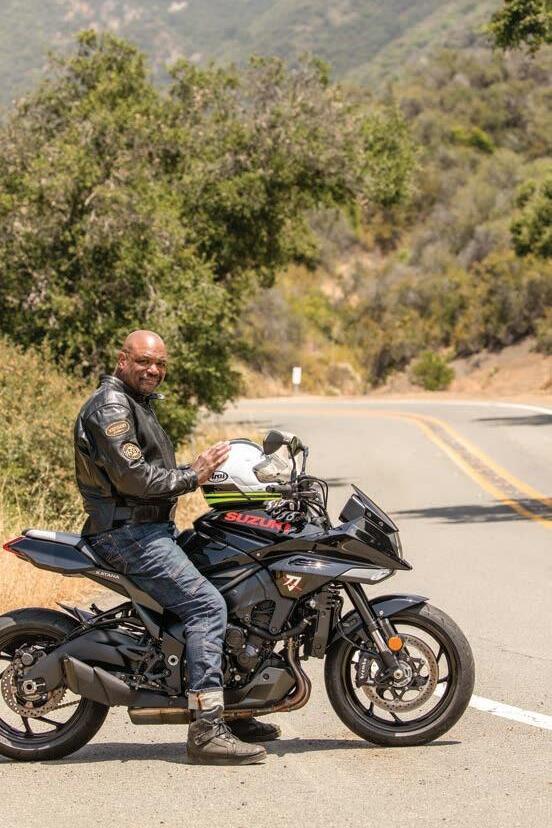
The Benelli pretty much summed up the radically different approach the newcomers bring to the American motorcycle market in that the engine – like many aspects of the Chinese motorcycle game – is not unique to the Benelli name. Instead I noticed no fewer than four different brands of motorcycle utilizing the same 50 horsepower parallel twin engine, which was odd to say the least.
Copyright law is a non-starter in Chinese industry, one insider explained to me after reading the clearly puzzled expression on my face. “Engineering and manufacturing firms will develop a certain powerplant and sell it to whomever wants it,“ he explained.
Like nearly all Asian-market streetbikes, the models on display at AIMExpo tended to be small-displacement machines aimed at commuters. I noticed that every bike, regardless of brand name, was limited to around 48 horsepower, as this makes for both a beginner-friendly motorcycle and one that suits most of the world’s streetbike licensing laws.
The prices tend to be much lower than what their Western competition is asking, but people earn less in China than we Americans do, so this only makes sense.
Benelli, for those who’ve done their homework, is an Italian motorcycle brand that’s been in and out of business more times than a your local all-night liquor store. Some 15 years back, they entered the US market selling a line of sleek and very capable 900cc triples. When that didn’t pan out, the brand merged with Chinese firm Qianjiang Motors. Today, Benelli motorcycles are apparently designed in Italy, but built in Chinese factories, which isn’t unusual in today’s global market.
Near Benelli’s well-appointed display was the Moto Morini area. They’re another classic Italian bike brand who’ve followed the design in Italy, build in China template. Their booth was very impressive with their line
of high-tech 650cc V-twins looking as solidly engineered as anything from Aprilia or Ducati. There was even a display of hip, branded riding gear that’s for sale at Moto Morini’s growing list of US dealers.
I’m among the CRM staffers eager to get some road miles on one of Moto Morini’s new mounts, as they look promising and well-built. From the two machines featured in this issue’s First Ride features, you’ll notice the days of manufacturers placing all their chips on a high-performance, large-displacement superbike seem to be fading. It’s these accessible, affordable middleweights that promise to dominate the future. Compared to other industrialized nations, Americans don’t ride motorcycles nearly as much as folks do overseas. I’d bet offering entrylevel machines at lower prices just might change all that.
The emergence of new brands and motorcycles into the game also means more options for customers, lower insurance costs for riders and, hopefully, more Americans utilizing their two-wheelers for transportation, which can only benefit all riders in the long run. The show was not without its skeptics, though. I had lunch with several other veteran journalists, some of whom doubted the long-term veracity of Chinese-made streetbikes, while others derided them as “disposable, low-quality toys for kids and college students.”
Funny thing is, some 60 years back, people said much the same about Japanese bikes and history proved them very, very wrong. So it’s too early to tell what the future holds for our newest streetbike makers. I, for one, am eager to find out. CR
6 www.caferacermag.com

One Size Does Not Fit All
By Managing Editor Kim Love
Choosing your first bike can be exciting – and a bit intimidating. Pick a small, entry-level motorcycle, one you feel comfortable on immediately, and you might outgrow it quickly. Buy a bigger bike, one that will suit your needs for the long run, and it can be challenging to ride at first, just when you want to build confidence. In my 20+ years in motorcycle dealerships I saw a lot of people make this important decision, most with great results, but some, well, not so much.
When a young girl, all of 16 years old, came into the Honda dealership with her dad, I was surprised they were looking at a bike for her. As the daughter sat on a Honda Rebel 250, I chatted with dad. “Heckuva 16th birthday gift,” I said. “She loves to ride with me,” he replied. “And now that she has her license, she really wants her own bike. It’s worth every penny to have my 16-year-old daughter spend time with me.” A few years later they returned to trade the Rebel in on a Shadow 750. They were still riding together. Smart dad.
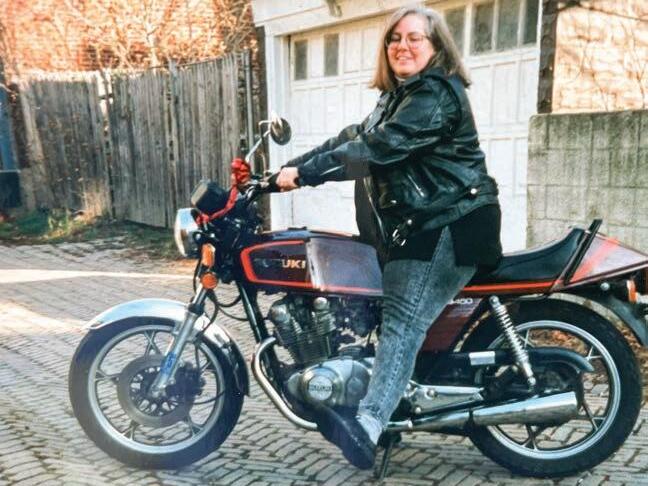
From my office, off the showroom floor, I heard the couple before I saw them. “Just sit on it!” he bellowed. “I don’t want to,” she said, quietly. I walked over, hoping to broker a peace agreement. “Hey, how are we today?” I asked. The husband smiled, and said they were looking for a bike for his wife. “This is perfect,” he said, pointing at a Honda VTX1300. “I don’t want a bike that big,” said the wife, “and I don’t want a cruiser.” She walked over to a red CBR500R and threw a leg over. “This is the bike I told you about,” she said to her husband. “No, no, no,” he said. “Part of what’s cool about you getting a bike is that I’ll have a second bike to ride, and I’m not riding a crotch rocket.” She looked at me, then back at him. “This is the bike I want, and this is the bike I’m getting,” she said with conviction. They left an hour later with the CBR. I hope she loved it. I also hope she never let him ride it.
Sometimes you just know things aren’t going to end well. Two guys came into a multi-line dealership, looking for matching bikes. They had no idea what they wanted, except that they wanted “the best.” When they saw the exorbitant price tags on a pair of shiny red Ducati 996s they were sold. The salesperson suggested more reason-
able first bikes; they shut him down. “Do you want to take our money or not?” one asked with a sneer. Paperwork done, the salesperson offered to deliver. “We want to ride them home,” was the response. It was below 50 degrees, and both men were dressed in khakis and loafers. Delivery is free, the salesperson said. You can ride around in your neighborhood, get used to the bikes before you ride on the highway, he continued. They declined, slipped on white leather golf gloves and rode out of the service department together. I didn’t wish it to happen, but I didn’t feel bad when one crashed before they’d made it a block. The crashed bike was repaired, and then both were delivered a few days later. I don’t know what happened to those two guys, but I bet the bikes were listed in the Cycle Trader before it got warm enough to ride.
So how do you pick a first bike? There’s no one right answer. If you didn’t grow up riding in the dirt, maybe start with a used bike. If you take good care of it, when you’re ready to move to something bigger, faster or newer, you’ll always get your money back. If you prefer new, go sit on some bikes on the showroom floor. Maybe you’re tall enough for a 32” seat height; maybe a smaller cruiser with a 29” seat will better fit you. Talk to other people who ride. Ask their advice, and then take it. Or talk to a salesperson. They want your repeat business, so most won’t steer you wrong. But remember, no one is an expert at buying their first bike. We all only do it once, right?
I’m a big fan of doing research, and reading everything I can find before making any major purchase. I won’t say I overthink it, but a spreadsheet is sometimes employed. I’d like to say I followed my own advice when I got my first bike, and that I ended up with my 1980 Suzuki GS450E after lots of research. But my first bike was a Christmas gift, no spreadsheet necessary. CR
Random Ramblings
8 www.caferacermag.com
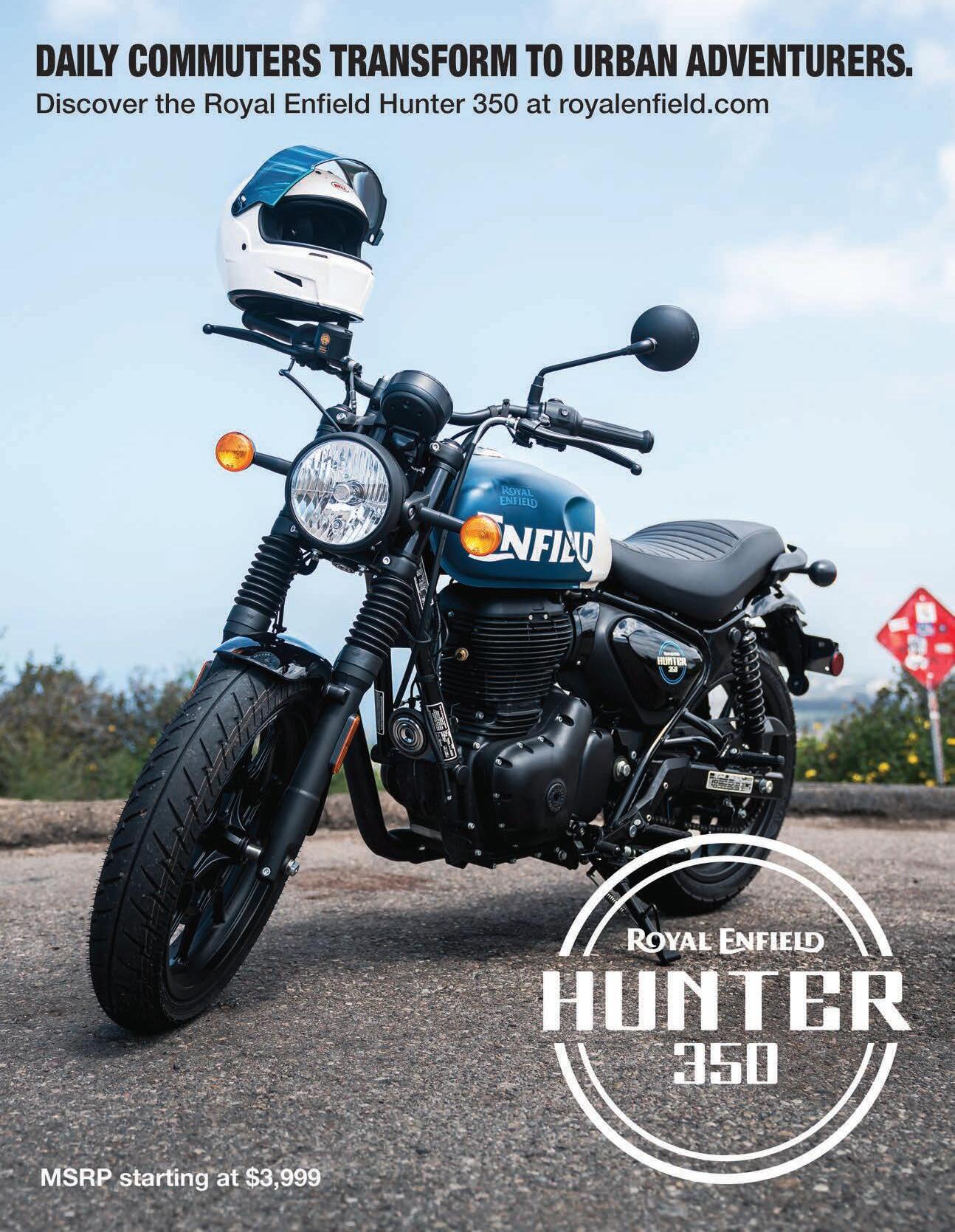
THE MASTER CLASS
Are You a Good Motorcycle Steward?

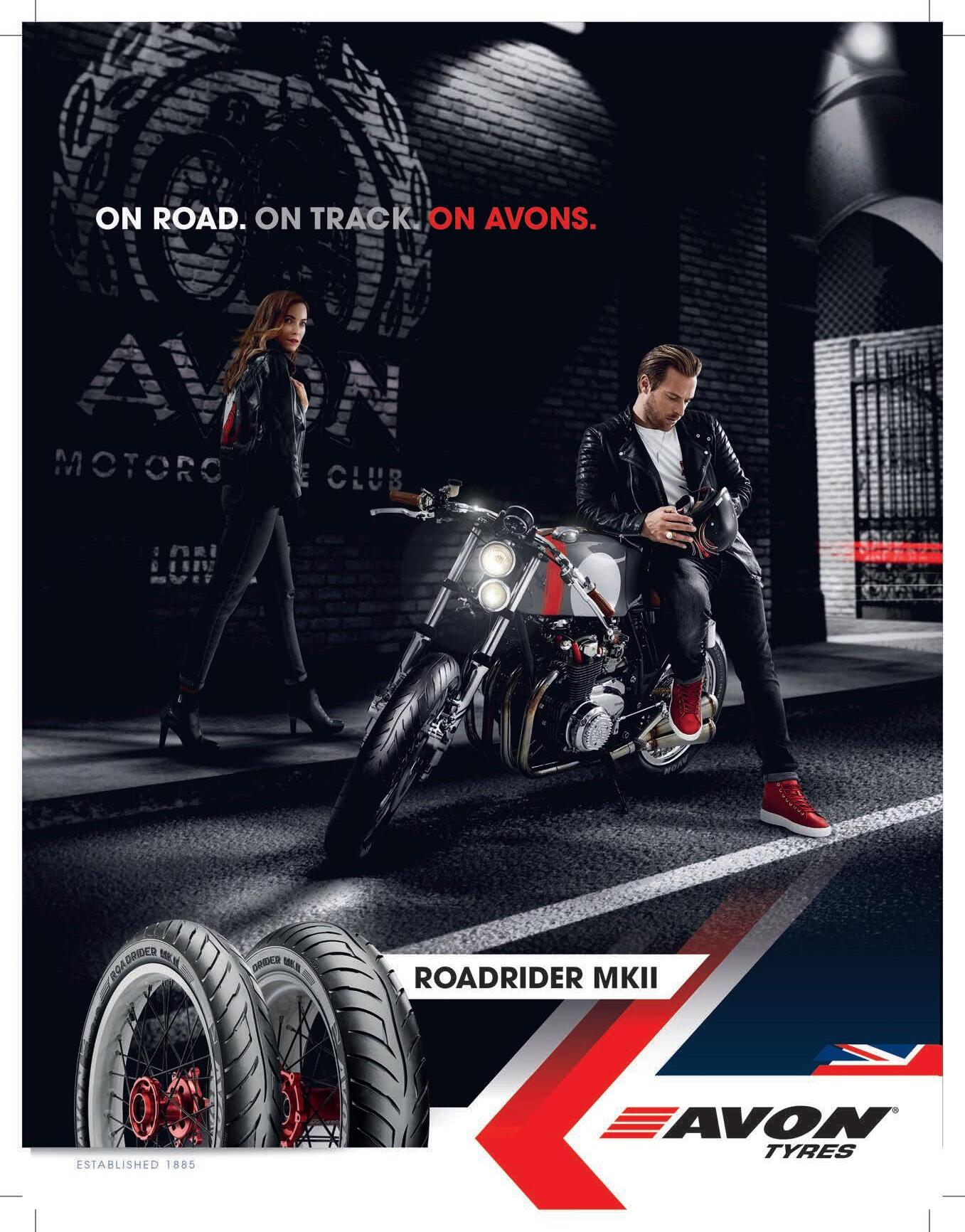 By Mark Mederski
By Mark Mederski
As you survey your bikes and your stash of precious parts, got anything made from magnesium? I’ve always been in awe of this metal, still have the Honda CB750K0 dual disc setup with a magnesium caliper mount. Feels odd to pick it up; so light. But like that most attractive cheerleader in high school, it may have some invisible problems only time will expose. Magnesium, like pot metal, seems to rot from the inside. Some 40- to 60-yearold parts get all crusty and just crumble now. Often, even the rarest of Vincent or Manx Norton parts are unusable and will not stand any forces. Did you know similar silent decay could be at work in your bike collection?
Well, I guess I’m starting down an extremist path on how those bikes in your garage, hopefully not in your damp basement, are at once your responsibility, but will go straight to hell and become worthless unless you correctly care for them. In some cases, like old magnesium, there’s nothing even The Henry Ford (museum) could do to stop their demise.
What I’m getting at is that you’re the steward of what you own. It’s your responsibility to carry it through the 20 or 30 years that you care about it, then hand it off to another collector for their stewardship. I chose this fancy word the late Peter Simeone deals with in his big book, The Stewardship of Historically Important Automobiles. And as I age, I’m getting a dose of reality telling me maybe I have more projects than I can ever complete, and the museum-quality maintenance work is not a lot of fun. Maybe finding a new home for a bike or two is good. Face it, we all refocus as we learn about best cafe racer build approaches or which old bikes most trip our triggers.
I live in the city. My garage, to fit my lot and city codes, is a new-ish two story and about 1,800 square feet total. An electric one ton chain hoist gets big stuff to the upper level. It’s heavily insulated, including the doors, is absolutely devoid of any leaks, has no varmints except spiders.* This past week, I hoisted some bikes upstairs to my sweeter, drywalled, track-lit and white oak floored shop. Uncovering all my bikes downstairs, seeing who would make the cut to the upstairs, I was surprised at how dusty these mothballed bikes had become in a few years. The overhead doors are opened for only a few minutes a couple of times a week, and no salt dog cars ever get in. Plus, a couple of bikes had some mildew on
rubber and vinyl parts. Ugly, smelly, greenish crap, and probably communicable, like Covid.
So for 40 years I’ve collected old bikes that are important to me, and for 50 years I’ve worked for and around museums, listening to many experts pontificate on collection care. And so within limits, and finances, I kind of know better. I know everything should be clean and dust-free as dust breeds corrosion and holds moisture. No grinding or sanding allowed. I know to keep rubber and leather, even paint, out of the sun. I’ve learned that LED lamps produce no ultraviolet light (that damages paint) and though expensive to buy, they use less electricity and last longer.
I can also share that storage of old batteries, garden supplies (like spray dope and fertilizer) are bad for chrome, aluminum and those old cadmium-plated parts on classic bikes. Nickel is also fragile. On cooling systems, the latest is to drain them completely, leaving hoses and plugs loose to ensure they’re dried out. After stopping the fuel supply, drain the carbs or run them dry. Spray inside the tank and down the fuel lines with oil, preferably LPS3. Don’t coat the tires with anything unless you can take the time to brush on a nice coat microcrystalline wax, the pure, pH neutral conservator grade. Cover your bikes with breathable cotton cloth. No battery, of course.
The bad news is you can’t insure against general degradation of your bikes and parts. It’s up to you to use the right corrosion proofers for long term storage, because it’s not just about the money. If you’re not a good steward, you’re doing a disservice to motorcycle history.
So as I head for the AMCA swap meet in Wauseon, Ohio, I’m taking one bike to sell, a bunch of NOS race tires and a few tubs of parts. Pretty lame that I didn’t shed more of my bikes and parts, finding new homes for them. Maybe next year I’ll pass more of them along to a new steward because responsibly caring for a collection is time consuming and is the stuff I worry about at 4:00 am.
*Mark did find three mice in his garage traps later this spring. CR
10 www.caferacermag.com

Introducing Triumph’s New 400 Singles
An intense, five-year research and development project between Triumph Motorcycles, LTD. and India’s Bajaj Auto, the 400 singles were designed at the company’s headquarters in Hinckley, England and are being built in Triumph factories located in Thailand, India and Brazil. Those markets are very important to the future of Triumph’s first smalldisplacement motorcycles in over five decades as the burgeoning Asian market is clamoring for more high-quality, mid-sized streetbikes.
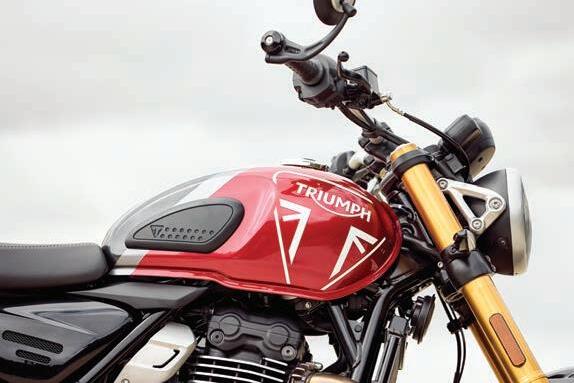
“Our mission is very simple: to give a whole new generation of riders the opportunity to ride Triumphs,” said Alastair Fairgrieve, Triumph’s Global Product Marketing Manager. The Scrambler 400X and the Speed 400 are both built upon a 398cc water-cooled single-cylinder engine parked in a newly designed chassis. During the global press briefing, Triumph’s team explained how well the full-bore Bonneville Scrambler and Speed Twin (upon which the new bikes are inspired) have sold in recent years.
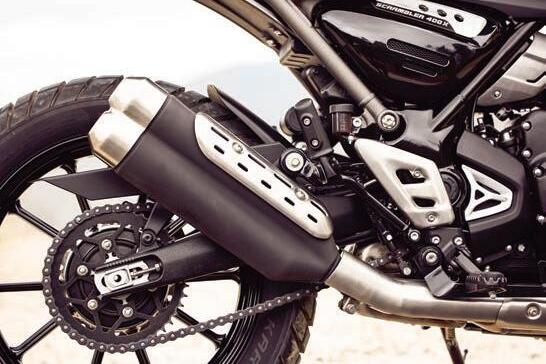

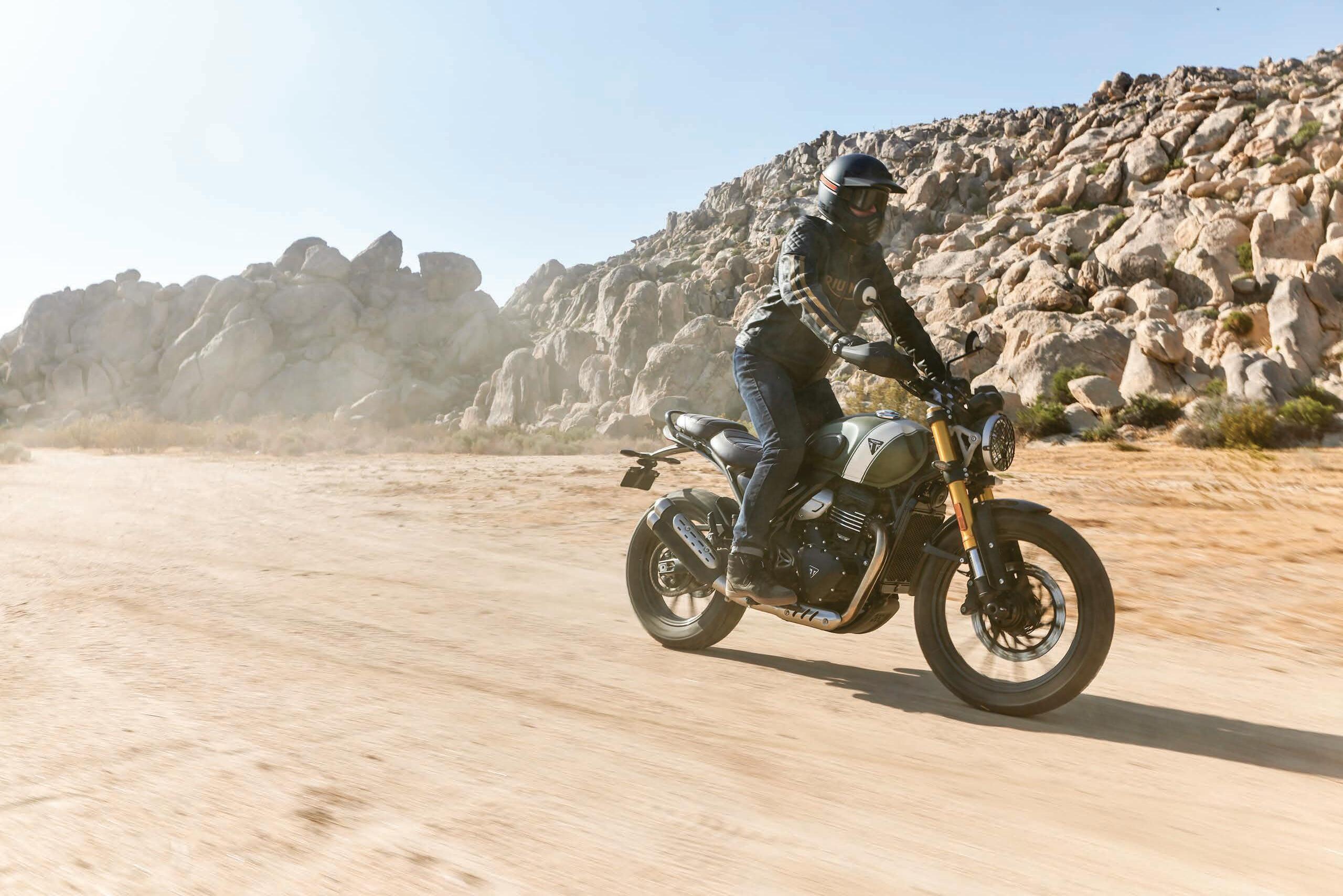
The 900cc and 1200cc Speed Twins are the firm’s most popular classics with over 40,000 units sold worldwide since 2018, while some 15,000 of the powerful Bonneville Scrambler 1200s have found new buyers since 2019. With a striking visual and mechanical similarity to the rest of the modern classics lineup, the 400s should be welcomed by riders not interested in a large-capacity motorcycle, Fairgrieve said.
Triumph hasn’t denied the new bikes any of the top-flight quality and modern technology known throughout their current line-up as both machines are equipped with traction control, six-speed gearboxes and a very learner-friendly 31” seat height. The new engines were engineered from the crank up and feature double overhead cams, electronic fuel injection, ride-by-wire throttle and produce a very
fastlane NEWS
12 www.caferacermag.com
An accessible 39 horsepower and a 31” seat height makes the Speed 400 perfect for smaller riders.
The smart Union Jack motif on the Speed 400s fuel tank should please Anglophiles the world over.
Dual upswept exhausts, plenty of scuff-resistant black powdercoat and knobby tires on the Scrambler 400X.
impressive 39 horsepower. The four-valveper-cylinder design churns out 27 foot-pounds of torque which should be enough to keep things interesting on backroads and in traffic. Six speed transmissions with torque-assist clutches and generous 13 liter (or 3.43 gallon) fuel tanks should last a good 280 miles with an advertised 80 MPG fuel economy. Known as the TR
series, the finishes, as you can see here, are typical Triumph with the Speed 400 featuring two-tone paint and a classic Bonneville profile fuel tank while the Scrambler follows in the dual sport tracks of the very popular 1200cc version with a slightly longer wheelbase, steel

bash plate, lever guards, longer-travel suspension and a 19” wheel as opposed to the Speed 400’s 18 incher.

Both bikes have cast aluminum swingarms and 43mm inverted forks that are preload adjustable. Overall handling is engineered to deliver a light, agile feel. The single front brake caliper is a four-piston caliper with 300mm disc equipped with Bosch ABS. Service intervals are every 10,000 miles and a two-year unlimited mileage warranty with free roadside assistance is standard.
And who are the intended customers for the new Triumphs? According to Fairgrieve, they’re aimed at selling to both new riders and older riders while emphasis is on the Asian market where 400cc is seen as a big bike, he said. “It’s for current riders looking for a fun, second motorcycle and we’re going for easy maneuverability and ease of use, light weight and an unintimidating-but-fun motorcycle,” Fairgrieve said. CR

Cafe Racer • AUGUST/SEPTEMBER 2023 13
Compact gauge covers everything riders will need on the go.
Street or dirt, the world is the Scrambler’s playground.
Royal Enfield Hunter 350
India’s Latest Neo-Retro Single
Story by Mike Seate
Photos Courtesy Royal Enfield North America

Like any moto journalist, I jump at the chance to test ride new motorcycles. This generally involves free travel, meals and accommodation in some faraway, sunny locale, and plentiful time aboard a factoryfresh machine. However, when said invite entails riding a small-displacement commuter bike, one’s expectations are somewhat
diminished. Single-cylinder 350s are not expected to be particularly fast, exotic or all that enthralling on the road. These were among my preconceptions before the first few miles aboard Royal Enfield’s Hunter 350. Styled with elements from classic British singles and imbued with plenty of modernity, the lowslung Hunter – like the Triumph trident tested on page 20 – is proof that streetbikes can still be fun without copious cubic centimeters.
14 www.caferacermag.com FIRST RIDE
The Hunter’s thumping single overhead cam 350 is derived from the motor powering the Classic 350, which outpaces its 500cc predecessor with a host of modern technological upgrades. Gone is the rattling, kit-bike feel affecting Enfields of yore, replaced by a steadily thrumming powerplant that neither shakes nor rattles as it rolls along. A primary balancer shaft smooths out rough edges and a fivespeed constant-mesh gearbox helps stretch the attendant 20 horsepower a long way, making the engine feel much bigger than it seems. Attribute that to a flat torque curve that allows the Hunter to spread its 19 foot-

pounds out evenly through the first four gears with the fifth cog acting as an overdrive.
The stiff new chassis was designed in RE’s British R&D center, run by legendary frame makers Harris Design, and it shows. In dense San Diego city traffic it flicks easily around trolley tracks and poorly parked Amazon vans while on backroads it’s surprisingly agile, even when pushed (far too) hard. My fears of a 350 test ride being boring were proven unfounded by the first long, curvy stretch of backroads we encountered. Our group of eight journalists included a few amateur roadracers, all of whom
were determined to prove their speediness at every opportunity. That turned an otherwise relaxing 120mile jaunt into a virtual Journalist’s GP with every bend, hillcrest and stoplight a battle for first place. Much to my surprise, the Hunter’s twinshock chassis never felt overwhelmed by these ego-driven antics, the single Bybre 300mm front brake and matching 270mm rear always up to the task of slowing all 400 pounds of motorcycle in a hurry.
Stopping for lunch, we could appreciate the Hunter’s details more fully. A broad range of bold, two-tone and solid color schemes
Cafe Racer • AUGUST/SEPTEMBER 2023 15
FIRST RIDE Royal Enfield Hunter 350
are designed to appease most tastes and the 17” mag wheels and very BSA A10 gas tank were particularly nice touches. The single gauge is digital but analog-looking while the bi-level seat is designed to make pillions happy. Though at 6’4” and 250 pounds and with several clicks of extra preload dialed into the twin shocks, I can’t imagine riders my size carrying a passenger. Still, the low 31” seat height never felt like the Hunter’s engineers had it in for my knees – well, at

least until the last 30 miles or so.
Among the advantages for buyers seeking an all-around ride are incredible 88 MPH fuel economy, an accessible USB charging port and plentiful accessories capable of making the Hunter into a touring mount, cruiser, you name it. With a chrome pipe, rearsets and new bodywork, this baby could make such a convincing BSA Rocket Gold Star replica, I can nearly taste it. But that’s another story.
The launch ride included some of the engineers who designed the Hunter, among them the jovial Mark Wells, Royal Enfield’s chief design engineer. Wells said the Hunter came about because “we knew we wanted to do a bike that would change direction real quick and be the perfect bike for an urban environment. We wanted to take a bike that combined the tractable engine from the Classic and the Meteor and make it a true roadster.” This meant sharpening up the
16 www.caferacermag.com
The twin shock Harris Performance chassis is more than up to the job. 270mm rear brake and matching front are from Bybre, a Brembo subsidiary.
steering head angle for the sort of quicker turning needed to navigate urban environments. This the Hunter does with the ease of a Razor scooter.
Wells admitted the 350s retro styling – from the rubber fork gaiters to the oil tank-shaped sidecovers – was indeed meant to be evocative of 1950s British bikes. “The looks should appeal to a global audience that appreciates a bike that looks great, is good for short-of-stature riders and is easy and fun to ride because of its low center of gravity while still feeling substantial like a full-sized, fourstroke motorcycle.”

True to form, the Hunter punches well above its weight as it combined small bike conveniences (featherweight handling, light throttle feel and feet-down comfort) with the big bike advantages of accessible torque that helps the Hunter keep pace with rapid So Cal traffic (up to a point). It’s worth noting that my top speed fell somewhere in the high 70s even when pressed flat on the fuel tank like Reggie from “The Leatherboys.” Some of the smaller testers were pacing me by a good half mile, their lesser heft affording them an additional five or ten MPH at flat-out speed.

But that sort of riding isn’t what the Hunter is designed for. Daily commuters facing relentless urban obstacles, weekend joy-riders searching for backroads serenity and cornering thrills at legal speeds are the Hunter’s prime audience. There are millions of them just waiting for a bike like this. CR
2024 Royal Enfield Hunter 350

MSRP: $3,999 ($4,199 two-tone colors)
Engine: SOHC air-cooled two-valve single
Transmission: Five-speed, constant mesh
Brakes: Single 300mm Bybre front with twopiston caliper; 270mm single disc with twopiston caliper.
Wheels: 17”x140 rear; 17”x110 front
Suspension: 41: RWU forks with 5.1” travel; twin emulsion shocks with six-way preload adjustment 4.8” travel
Power: 20 BHP at 6,100 RPM: 19 foot-pounds of torque at 4,400RPM
Fuel Capacity/Economy: 3.43 Gallons, 88MPG
Electronics: Dual channel ABS
Service Intervals: Every 12 months
We Dig: The torque and low center of gravity
We’d Ditch: Pillion seat for a flat or cafe saddle. And some low-bars, please.
Cafe Racer • AUGUST/SEPTEMBER 2023 17
A bevy of paint schemes makes the $4,000 Hunter an attractive buy.
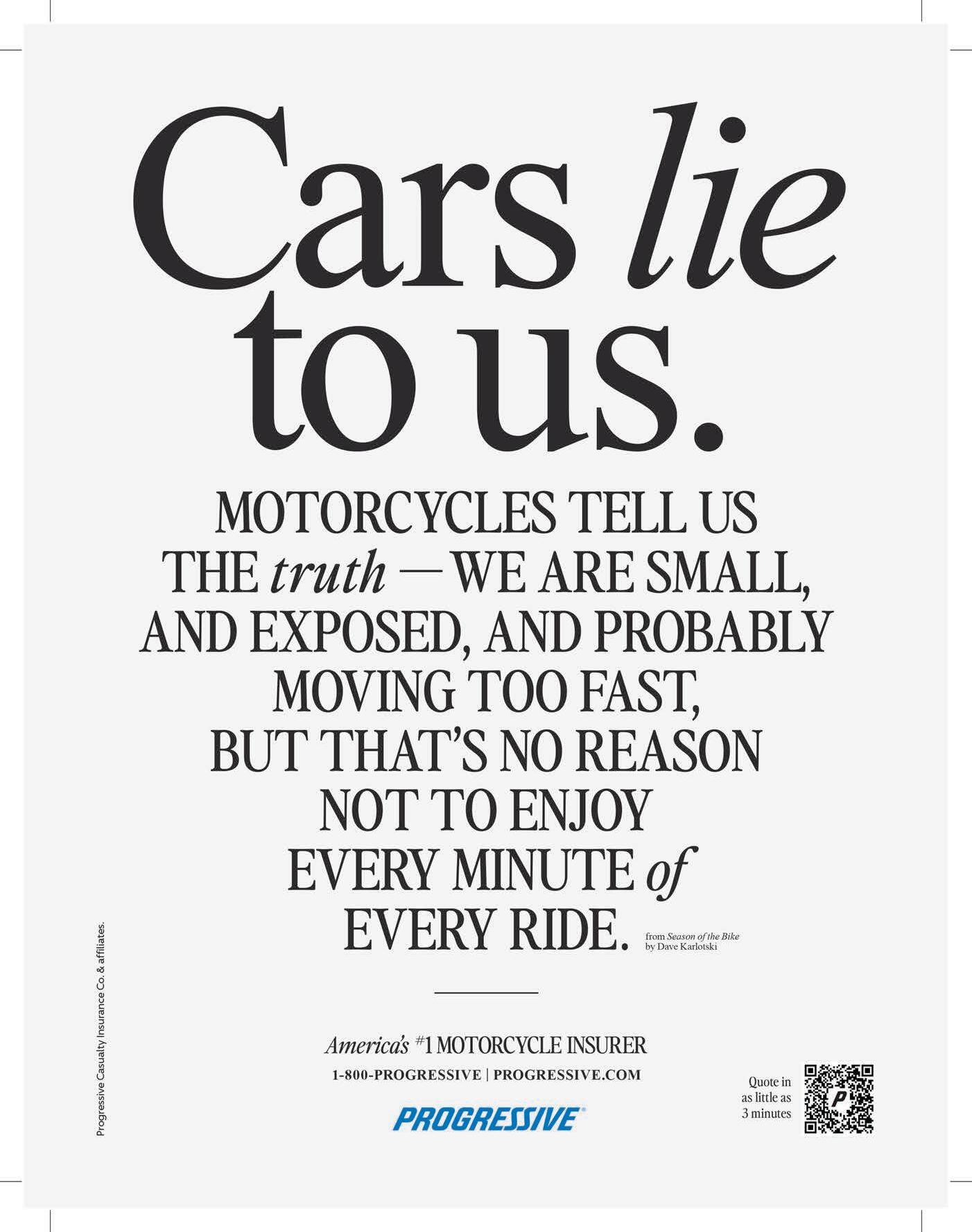



The Everyday, Everybody Triumph Triple
 Story by Jay LaRossa and Mike Seate
Photos by Jose Gallina
Story by Jay LaRossa and Mike Seate
Photos by Jose Gallina
Jay has just stepped off the 660cc Triumph Trident after a spirited 45-mile ride through the foothills of Southern California’s Santa Monica Mountains. It’s nearing dusk and even though the temperature is unusually cool for this time of year, he encountered several other quick motorcycle riders with intimate knowledge of these twisty, high desert roads. The Trident isn’t bristling with the race-derived tech or horsepower figures that would impress a Motoamerica racer, but there’s a broad grin stretching from ear-to-ear when Jay unstraps his helmet.
“Did you see me keeping pace with all those sportbikes back there?” he asks eagerly. The Trident has that effect on people as it fulfills its understated role as Triumph’s true sleeper in a vast lineup. There are far faster Triumphs and yes, there are models that wax the Trident’s unassuming style in the look-at-me department. But for a budget-priced middleweight, the Trident has the ability to make riding a genuine joy. “It’s very comfortable with a good seat that’s padded well, and the clutch is nice and buttery and it handles good and stops good,” were among Jay’s praises. “It’s a six speed, but for some weird reason it feels like it needs another gear at high speed. I’d use a bike like this for commuting, mostly, and you’re not really going to do much riding above say, 80 miles an hour, but it gets a little out of breath at the top end.”
“I think it’s great for just an all-around bike,” he continued after another 30 miles up and down some of the region’s steeper canyons. “It’s got plenty of power and it’s so smooth my hands aren’t stinging at all like they usually do on smaller bikes. I’m so spoiled with quickshifters so it would be nice to have that, but it’s a very nice everyday riding bike even without it.”
Jay found the Trident’s non-adjustable 41mm Showa forks capable and smooth, even after encountering a few pavement bumps. We didn’t dial in much extra preload for the rear shock, but Jay’s on the lighter side of our test crew, weighing less than 200 pounds even with a belly full of burritos and beer. “In the twisties, when I was throwing it around a bit, the bike never felt like you were taxing the suspension or tires more than they can handle,” he observed. “Comfortwise it’s an A+. I like the riding position because I’m through with bikes with clip-ons that make you hunch over to ride them. This is the way to go unless you’re 23 years old or a yoga master,” he said.
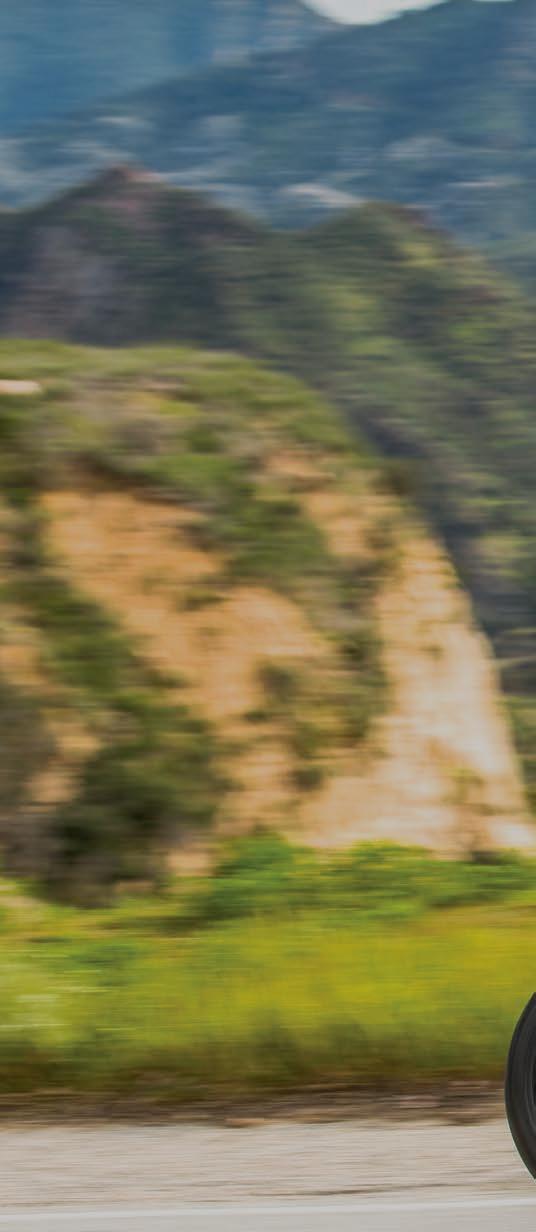
20 www.caferacermag.com
??? FIRST RIDE 2023 Triumph Trident 660


Cafe Racer • AUGUST/SEPTEMBER 2023 21
FIRST RIDE 2023 Triumph Trident 660


orange paint. “I’m not an orange paint person, but I think it looks good in a sort of retro kind of way. The sculpted tank has knee indentations and it has a good shape and it’s not just a boring blob like you see on some budget bikes. One thing I don’t like is the extended rear fender that works awesome, but looks-wise I don’t dig ‘em. The mirrors work really well and you can see cars behind you pretty well, unlike on the Indian FTR I just rode that only shows off your shoulders.”
As a club racer who campaigns an MV Agusta, Jay found the Trident’s everyman’s approach to motorcycling a real pleasure. “There’s so much hype about these big, crazy 180-horsepower race replicas these days that everybody forgets – at least some of the guys I know that ride – that you can have just as much fun on a bike like the
22 www.caferacermag.com
Jay is no fan of the extended rear mud guard but it actually helps keep the rear end clean.
Trident that has average power and average speed. You always ride better when your body is comfortable and you aren’t riding some crazy, track-based beast of a motorcycle that makes you feel like you wasted your money if you’re not riding at 100+ all the time. This is a full-on modern Triumph, but it really does take things back to the basics a little bit where you just have enough engine, good handling and good brakes so you can focus on fun,” he said.
In the unprecedented arms race to make motorcycles ever-more technologically complex for the generation raised with Play Station controllers permanently glued to their palms, it’s easy to forget how less can sometimes be more. Not that the Trident is a basic motorcycle. Not by any microprocessor it isn’t. The triple is equipped with a stiff, steel perimeter frame, 41mm Showa inverted forks, cast aluminum wheels, two separate riding modes, switchable traction control and anti-lock brakes (which are required by law these days). The 12-valve water-cooled motor is connected to the right twistgrip via ride-bywire throttle and smoothly pulses out 81 crank horses at 10,250 revs. There’s 47 footpounds of torque on tap at a very accessible 6,500 RPM which means the Trident happily sails along in third or fourth gear like nobody’s business.
There’s no need for radial brakes up front –the pair of two-pot Nissin calipers do a fine job of slowing the Trident’s 417 pounds in all conditions. Worth noting is that this has to be the slickest-shifting new Triumph we’ve yet tested. Most times, there’s a slight clunky feel to their gearboxes that takes a
few thousand miles to work its way free. There’s even a slipper clutch aboard to assist newbies downshifting too many gears at once. Reassuring. A true petrol miser, we got around 50 MPG from the triple even when revving it harder than traffic laws allow. That means the bulbous 3.7 gallon tank will provide you with 150 miles of entertainment before the need to look at your phone for a gas station.
Practical yes, but how does it measure up among its peers? When parked up among the rows of tall-barred Harleys at Neptune’s Net, the popular rider’s roost on the Pacific Coast Highway, even the Sons of Anarchy wannabees in identical flannels and Vans smiled at the Trident’s curvaceous, compact lines. Riders old enough to remember kickstarters also had nice comments, with one in particular acknowledging how far better-looking this version is than the early 1990s Trident. They dug the stubby canister muffler that emits a mild-mannered whirr that was barely audible among the unmuffled masses, but adding an aftermarket pipe with some three-cylinder growl would really help the Triumph make its mark.
So where, in between Triumph’s retro Modern Classics and sporty supernakeds does the Trident fit in? Quite nicely, we’d say. The bike has some sporting capabilities in its DNA and it’s nimble and maneuverable (not to mention light) enough to make a great first big bike for someone graduating from, say, a 300cc machine. The riding position is comfortable enough that all you’d need is a backpack for a 500-mile weekend jaunt and for those whose aching joints (that would be half our
2023 Triumph
Trident 660cc
MSRP: $8,595
Engine: 12-valve, water-cooled in-line triple
Transmission: Six-speed
Brakes: Twin two-piston Nissin front calipers with 310mm rotors; single Nissin caliper rear with 255mm rotor
Wheels: Cast aluminum five-spoke 17x3.5” front; 17x5.5” rear
Tires: Michelin Road radials
Suspension: 41mm inverted Showa forks, non-adjustable with 4.7” travel: Showa monoshock preload adjustable
Power: 81 horsepower @10,250 RPM; 47 foot-pounds torque at 6,500 RPM
Fuel Capacity/Economy: 3.7 US gallons/50 MPG average
Electronics: Two riding modes (rain and road) ABS
Service Intervals: 10,000 miles
We Dig: The ease of use, smooth power, smooth shifting and featherweight handling
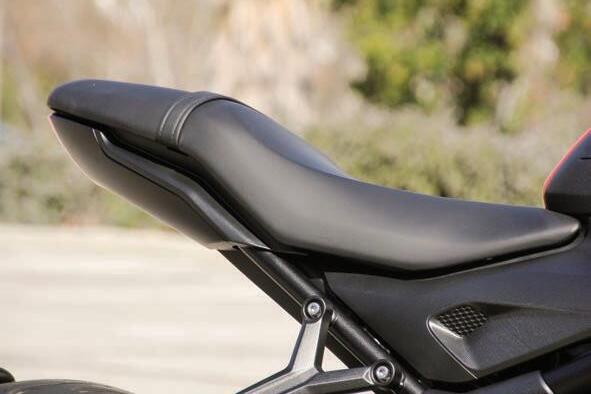
We’d Ditch: Besides the too-quiet muffler, the Trident 660 is spot-on
staff) preclude hopping aboard racier mounts, the Trident is that rare modern bike that’s kind to aging knees and backs. Not that we’d know. CR

Cafe Racer • AUGUST/SEPTEMBER 2023 23
Round single gauge features an arcing tachometer display and digital speedometer.
A sturdy steel subframe and stepped seat make riding two-up a breeze.

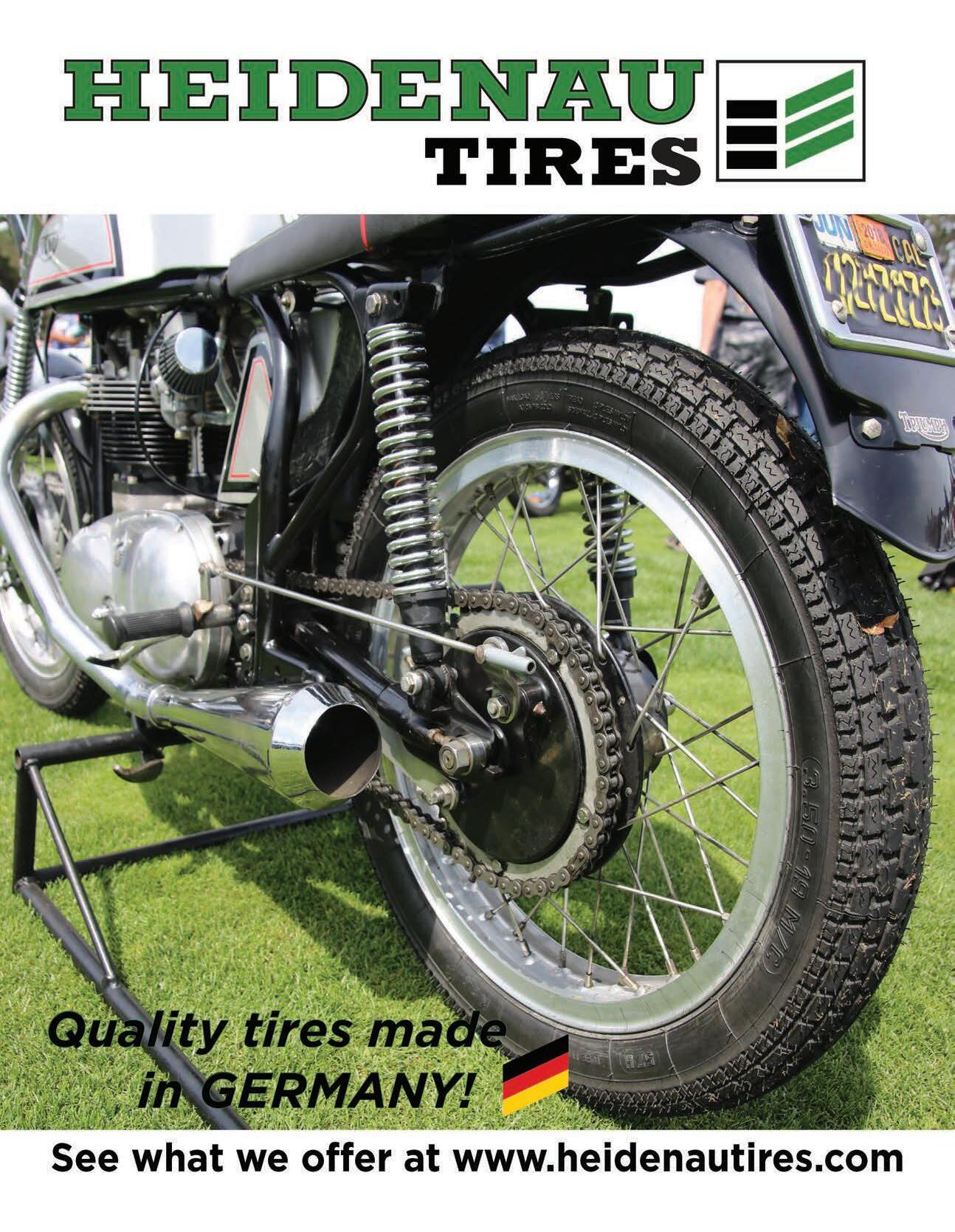


The Paddock
Erik Buell Designs Electric Bike



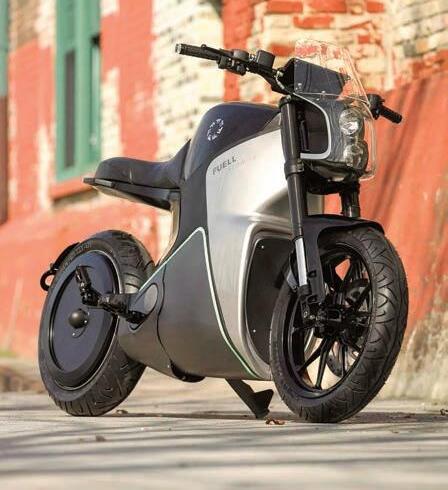
American motorcycling’s best-known iconoclast is back at his well-respected drafting table, creating a futuristic electric roadster that’s clearly infused with Buell DNA. The curvaceous and sporty Fllow (pronounced Flow) is the most motorcycle-like of Buell’s new Fuell line of E-bikes, running on a pair of 17” mag wheels with inverted Showa forks. The rear wheel is actually the power unit on a machine being billed as “combining the luggage capacity of a large scooter with the feel of a mid-sized motorcycle.” The silent running Fllow can buzz through city streets (its intended environment) for 150 miles between 30-minute charges. There’s even ABS, front and rear cameras and traction control on the 47 horsepower bike. Deposits are being taken now on fall deliveries at www.fuell.us
Forty Years of Fantastic Fiberglass


Vista’s Airtech Streamlining is celebrating their fourth decade designing highquality fiberglass bodywork for classic, competition and custom motorcycles, which is quite a feat. Owner Kent Riches started out sculpting parts for himself and then a few friends, eventually becoming the world’s top supplier of fairings, bodywork and hard-to-find reproduction parts for hundreds of motorcycles –including several built in the pages of CRM. Top job, Airtech!
Valhalla King Crowned





The second annual Valhalla Custom Builder’s Showcase went down at late June’s Motoblot street festival in Chicago with so many choice custom rides entered into the International competition, awarding the top prize of $10,000 cash became impossible. Instead of selecting a single winner, the judges split the pot between three motorcycles with the overall champ honors falling to Kully Millage for his radical, street tracker Harley-Davidson Sportster 900. Look for complete coverage on page 72.
Must Hear Music The Kat Men

A mix of pounding rhythms, haunting vocals and the rollicking piano work of Jools Holland make the Kat Men one of the true modern rockabilly supergroups. Led by veteran singer/guitarist Darrel Higham, the quartet sounds as authentically groovy as Gene and Eddie did back in the day.
Solid drumming by Stray Cat Slim Jim Phantom makes their import-only disc “The Kat Men Cometh” well worth a look and listen.
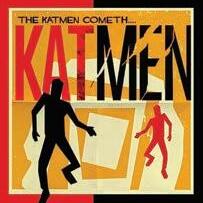

First 120 MPH TT Sidecar Lap
The groundhugging threewheeled sidecar rigs racing at the Isle of Man TT are second cousins to the more popular solo bikes, but this year, the first 120MPH lap of the 37.75-mile Mountain Course brought the sidecars into a new light. The allconquering team of brothers Ben and Tom Birchall reached an unprecedented 120.357 MPH average speed during the opening lap of this year’s first sidecar race which the pair went on to win quite handily. The solo machines also hit record-breaking speeds during the twoweek race event with Peter Hickman reaching 136.35p MPH during the first Superstock race. Astounding doesn’t even begin to cover it.
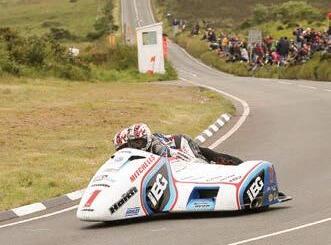
28 www.caferacermag.com A World of Custom Motorcycle News
BMW 100th Anniversary Celebration at Barber
Germany’s biggest and best motorcycle brand has been leading the way in technology and design for 100 years, and they’re celebrating this milestone of continuous production with a big shindig at this October’s Barber Vintage Festival. The weekend-long BMW Motorrad Festival will feature displays of historic and classic BMWs, a fan zone, special BMW parts swap meet, demo rides, live music and other activities for fans of the iconic brand. You can pre-register by pointing that cursor at the events page at www.bmwmotorcycles.com.
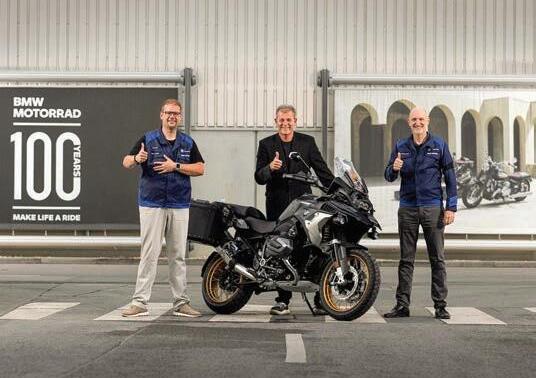
Big Numbered Beemer
BMW has another reason to celebrate as this summer marks the production of the 1 millionth (that’s a one and six zeroes) aircooled Boxer twinengined motorcycle to emerge from their Berlin assembly plant. The air- and-oil-cooled shaft-drive twins have been a staple of BMW’s vast line-up since pints of pilsner cost a nickel. And despite tightening global emissions laws, the venerable powerplant has a bright future ahead, says BMW’s Sepp Miritsch, head of Air-Cooled Boxer Series development. “There is no fear for the air-cooled boxer engines. Our R nineT and R28 motors currently meet Euro 5 (emissions regulations) quite easily and we’ll be able to meet the next regulations and keep the same power output.” Roll on, Boxers.
The Last of the Mods and Rockers Shows

Not long ago weekend mods and rockers festivals were as common as oil leaks under a classic BSA. They’ve mostly faded from view with the exception of Pittsburgh’s Steel City Mods vs Rockers which revs up on Saturday. Aug 26th at the Paradise Bowling Lanes in the city’s Neville Island section. Grease up that quiff and fire up your Lambrettas for a day of music, machines and fun. A pre-party is scheduled for Friday night at the fabled Duquesne Incline atop scenic Mount Washington. Learn more at their Facebook page.
5 Cafe Racers For Sale at Mecum’s Upcoming National Motorcycle Museum

Auction


website for online bidding come September 6 to 9, and one of these can be yours.
Log onto








Triton Special: Powered by a Triumph 650 engine, estimated sale between $6K and $7,500.
1975 KZ1000D Turbo: 1015cc monster street racer should sell for under $18K.
1966 Honda CB450: Original Black Bomber with clubman bars going at no reserve.

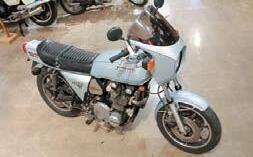
1956 BSA DB34 Gold Star 500: Can be yours for under $20K.

2000 Ducati Mike Hailwood Replica: A bid in the neighborhood of $14,000 will do it.


Our Favorite Jokes–A man and his wife traveled to the Holy Lands with her mother in tow, who unexpectedly dies during the vacation. A local mortician tells the man, “I can bury her here for $150 or you can ship her body home for burial, which will cost $5000.” The man thinks for a second and says, “Let’s definitely ship her home.” The mortician, astounded, asks the man why he’d rather spend the extra money? “A fella died here some 2,000 years ago and after a few days, he rose from the dead. I’m not taking any chances.”
 Mecum’s
Mecum’s
Cafe Racer • AUGUST/SEPTEMBER 2023 27
The Paddock New Bikes 2023
Norton V4CR We previewed the anticipated arrival of Norton’s revolutionary V4 Cafe Racer a while back, and after two years of teases, the 185 horsepower hypernaked machine is ready for the road. Unveiled at the recent Bike Shed Custom Show in London, the sleek, silver V4 is even better looking than the prototype drawings promised. The polished alloy perimeter frame, racing-level suspension and brakes and silver or carbon fiber body-
work present a new face for Norton who have struggled to bring any new bikes to market after being purchased by Indian transportation giant TVS back in 2020. Only 200 of the exclusive factory cafes will be offered to an eager public, and Norton’s boss Robert Hentschel says the rather steep $59,000 asking price shouldn’t affect sales. Honestly. If you’ve got a cool 60 grand burning a hole in your leathers, www.nortonmotorcycles.com is the place for you.

Husqvarna Vitpilen 401
One of our favorite factory cafe racers just got hit with the industry’s shrink-ray as the popular Husqvarna Vitpilen (of White Arrow) is now a 401cc instead of a 700. The Scandinavian single still rides on 17” spoked wheels and the same sure-footed steel trellis chassis with top-grade WP suspension front (inverted) and back (fully adjustable) while the divisive, futuristic styling remains the same. Power output in the six-speed mill has been scaled back to just under 50 horses which seems to be the target measure for manufacturers seeking a global ridership. It’s a lot of very agile, fun motorcycle for just $5,699.
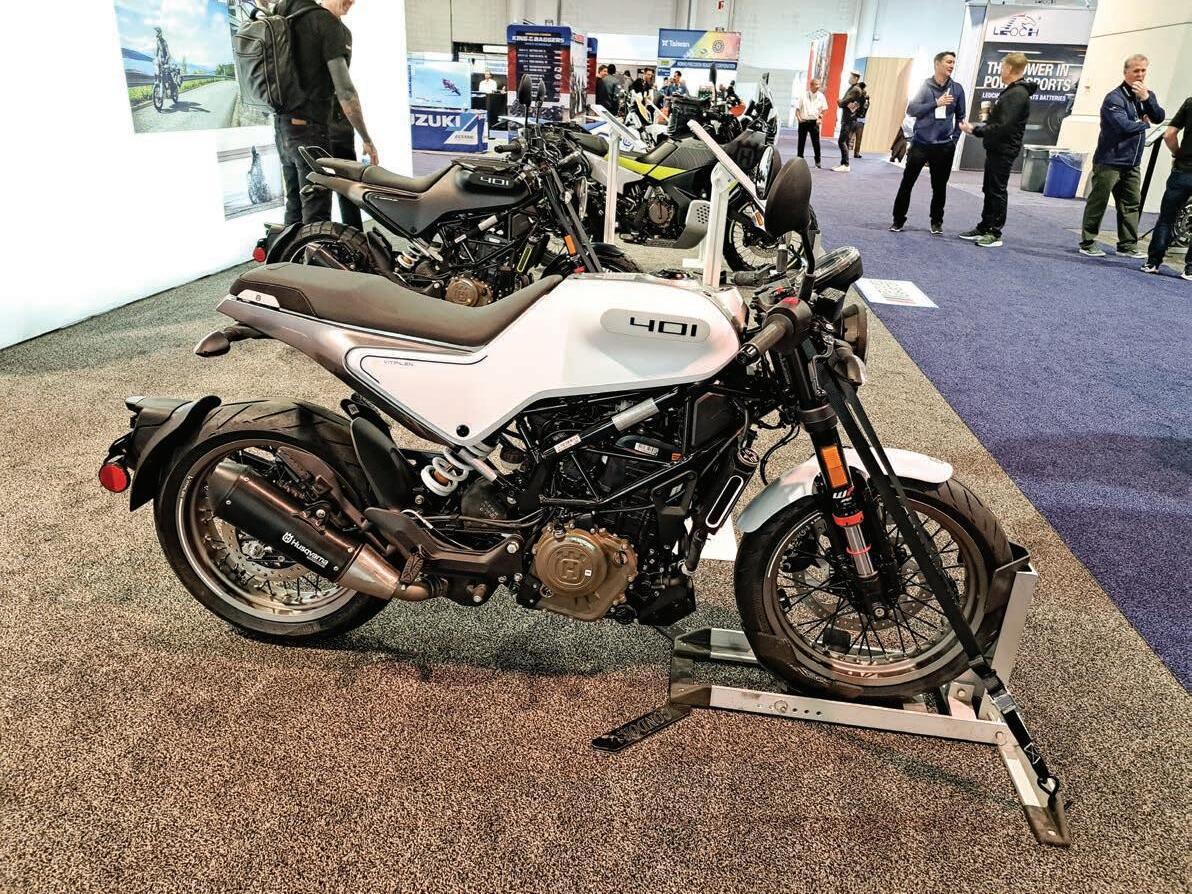

The Paddock New

Honda SCL500
The street scrambler genre has been going like gangbusters for more than a decade which makes Honda’s late entry into the trendy, popular market segment all the more interesting. Big Red have basically taken the watercooled powerplant from their top-selling Rebel 500 and restyled the new bike to reflect what marketing types call “hearkening back to the early ‘60s, when simple, strippeddown motorcycles like Honda’s CL72 came on the scene.” Honda’s all-new SCL500 is, like many 2023 streetbikes, built to be light, maneuverable in city traffic and easy for beginners to ride and own. The five-speed machine combines a high-mounted exhaust, a light-action clutch and colors straight out of Barbie’s Dream House including Candy Orange and a shade called Mattel Laurel Green Metallic. We didn’t make that up. $6,799 is the base price and loads of accessories will be available.
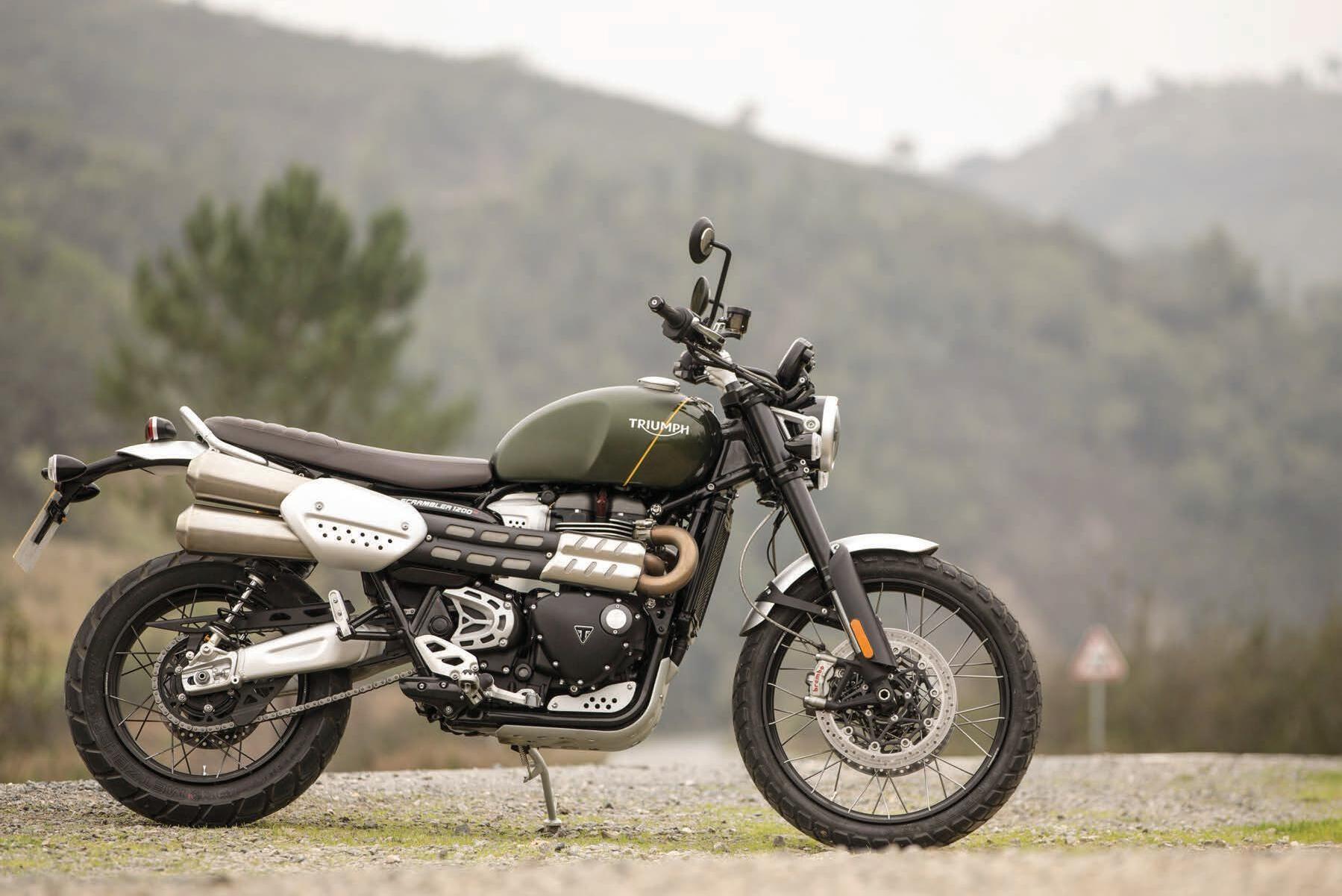
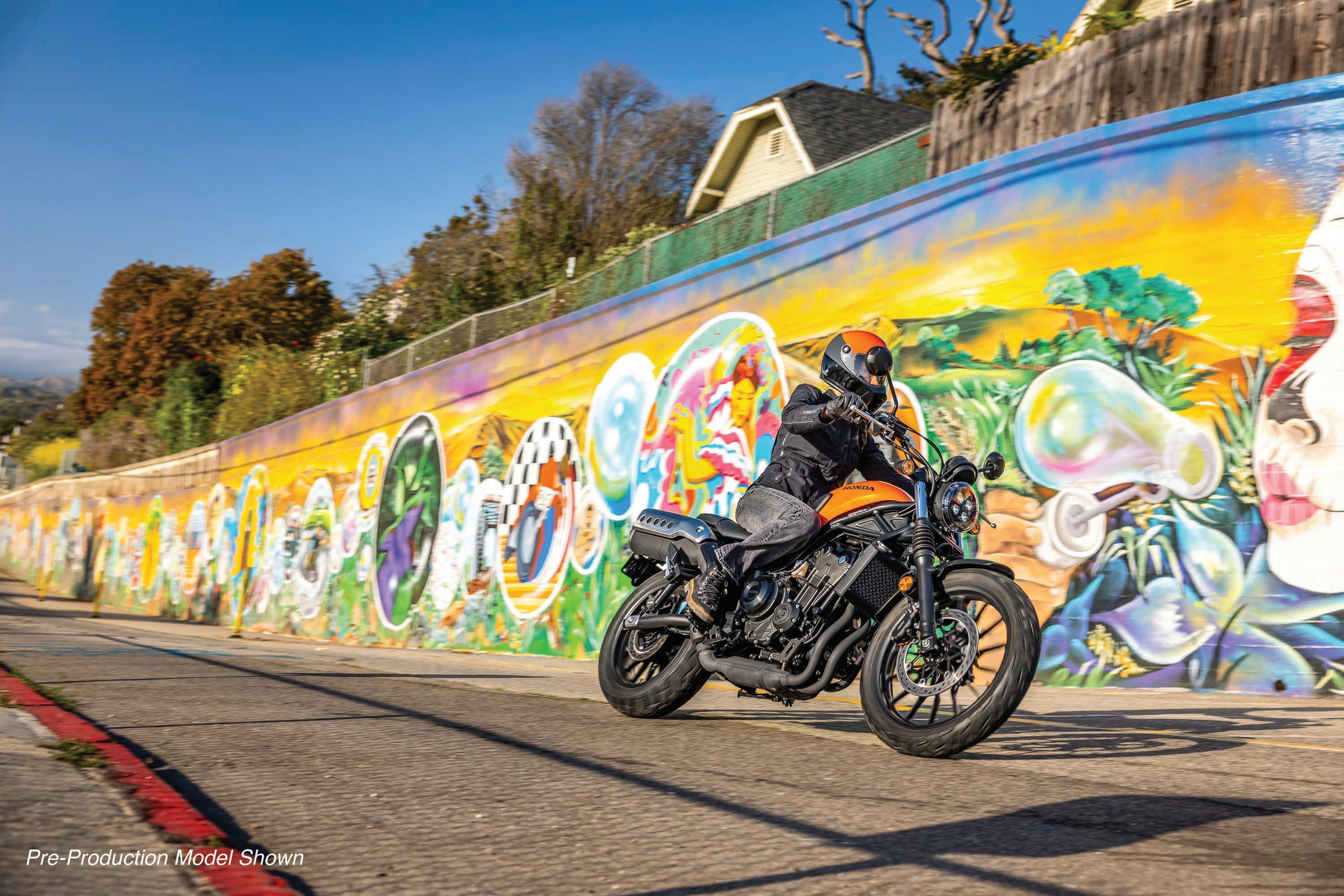
Bikes 2023
Triumph Bonneville Scrambler 1200 XE and XC
The proven and quite impressive 1200cc water-cooled, six-speed Triumph Bonneville line has been installed in the Scrambler version since 2019, combining wads of accessible torque with the sturdy, dual-purpose design of the Scrambler line. More than just a styling exercise, the 2023 1200 SC bikes feature bespoke frames, tall-travel Ohlins rear suspension and Showa inverted forks that can bound sand dunes, curbs and rocks with aplomb. A steel bash plate mounted to the front frame rails keeps the sump intact while the
sporty styling is pure Steve McQueen (the racer and actor, not the trendy British director). Seriously capable Scorpion Rally tires grace the 21” front and 17” rear wire wheels, while an impressive electronics package includes six-level traction control, a turn-by-turn onboard navigation system and, on the more expensive XE bike, you get heated grips, adjustable foot controls and gold nitrated forks. The XC runs $14,795 while you’ll fork over $16,195 for the XE.



Those Were The Days
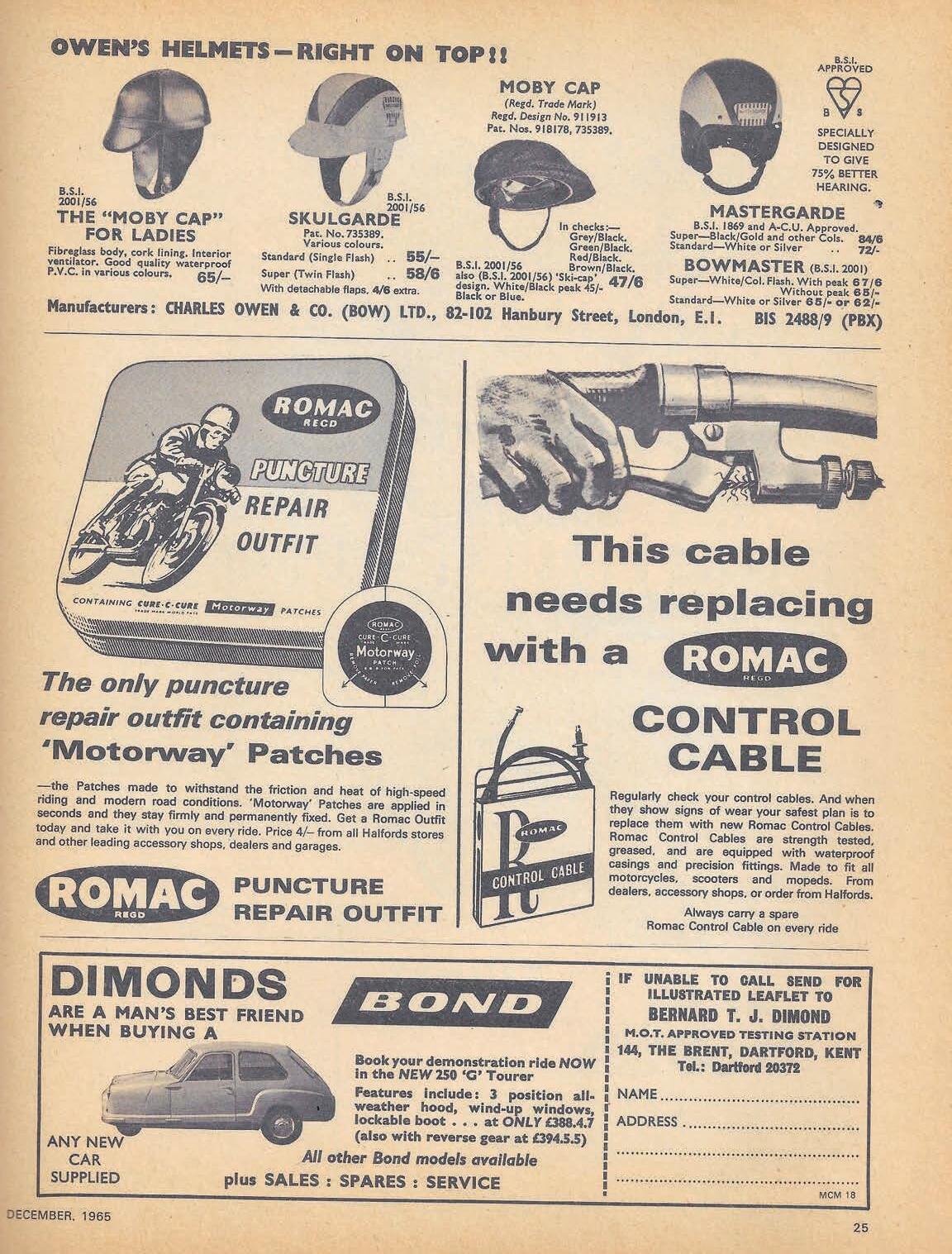
Top Gear
All the Latest Kit to Improve Your Riding Experience
FEATURED PRODUCT
1971 TT Photos Booklet
Though we were expecting a full-sized book when ordering this collection of photos from acclaimed photo-journalist Chris Killip, the publication we received was just 24 pages thick and in a digestsized, 5.5”x8” format. However, the brilliant black and white portraits of motorcycle racers and riders attending the 1971 Isle of Man TT Festival offer an intriguing historical look at radically changing fashions among both riders and bikes. The influence of American chopper movies was in full swing in the UK by ‘71, reflected in the rickety, bodged-together bikes and long-haired, grungy riders. The racing scene is covered in candid, unflinching work, making the tiny book well worth the $9 asking price.

Honda Brake Shoes

Fancy front disc brakes may get all the attention, but your classic Honda’s rear stopper is equally important. Whether negotiating low-speed turns or slowing your CB or CL from speed, the importance of decent deceleration at both ends can’t be ignored. Out in So Cal, classic Honda experts Charlie’s Place have replacement rear brake shoes in stock for all sorts of vintage Hondas, plus front drum shoes for CL Scrambler models. A worthy investment at just $33 to $45, the kits even include retainer springs. Www.charliesplace.com or call (818) 550-0600.
New Cafe Racer Shirt
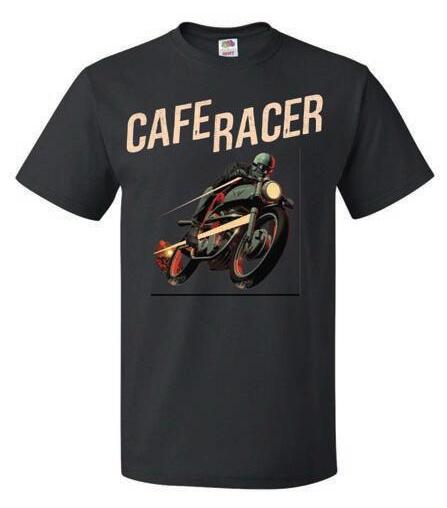
Our never-ending quest to keep you done-up in groovy ton-up gear continues with our latest bold, colorful short sleeved T-shirt that sums up the excitement and skill of fast riding while telling the world what type of motorcyclist you are. Plus, you gotta admit it looks pretty groovy in dark gray.
Made from a cotton/poly blend so it won’t shrink or fade in the washer. From www.caferacermag.com for $19.99 in Med, Large, XL and XXL.
34 www.caferacermag.com
Solder Heat Sleeves



There’s a debate in the CRM workshop between old school techs like Nick and Paul who prefer using hot solder to join lengths of electrical wire, and time-conscious (relative) youngsters who favor solder heat sleeves. We convinced Nick to test out the latter recently, and he grudgingly admitted these newfangled devices to be great time-savers. Made in China and available on the web (like practically everything else) these small plastic tubes are embedded with a ring of solder that melts with the application of direct heat. Just insert one of the wires through the tube, twist the wires together and aim a heat gun (or hair dryer if you’ve still got curls on your melon) and the job is done. Waterproof and color-coded to fit different diameter wires, they’re cheap at around $7.95 for 100 from your local auto parts or hardware store.
Classic British Donor Engines
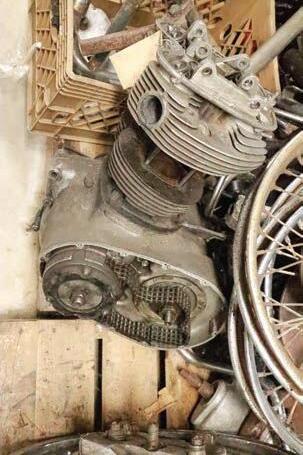
Every vintage motorcycle restoration or custom cafe racer begins with the core components and British Cycle Supply has them to spare. Spare engines, that is. Their vast warehouse has turned up a cache of 1960s British parallel twins that are now for sale. There’s a BSA A10 that needs parts such as bearings, pistons, rings, valves, guides, gaskets, seals, primary chain, bushings as well as some hardware and other small parts, priced at $1,500. They also have a Triumph T100 Daytona 500 bottom end on offer for $1,300 and a BSA A50 of 1970 vintage in need of a thorough rebuild. Perfect for the at-home mechanic looking for a viable, long-term project. Call (201) 880-0366 for more details.
Guardsman Leather Wipes

Despite having been removed from the cows and horses from whence they came, leather motorcycle gear can dry out and become brittle, making it less effective and comfortable. We came across these handy, effective Clean and Renew leather wipes in a discount store recently and they’re really up to the job of keeping jackets, boots and trousers clean and supple. A couple will be enough to bring shine and flexibility back to your well-worn riding gear and at just $10 for a pack of 50, you’ll be covered for months. On sale at most auto parts stores and websites.
Triumph Ignition Coil Shirt
Ever since Lee Marvin’s drunken, grease-encrusted Chino stole Brando’s thunder in “The Wild One,” riding shirts with striped sleeves have been the epitome of cool. Now you can fly the rebel flag with one of Triumph’s long-sleeved, Ignition Coil shirts. Made from durable 100% cotton, they come in black and yellow (just like Marvin’s) or blue and white in most sizes from your local Triumph Motorcycles dealer for a mere $75.99. Beer stains and engine grease sold separately...

Cafe Racer • AUGUST/SEPTEMBER 2023 35
Your Bikes, Done Your Way



Monterey Class Commando

Jeff Duval sent this smokin’, competition-ready custom our way from his shop Jets Forever, over in Poole, England. The glistening, big bore Norton Commando is designed to “be built halfway between circuit racers and standing quarter types,” Duval says. Local legendary frame maker John Parry engineered a stretched and lowered chassis using 7/8” chromoly tubing with 37-degree rake and a 5” stretch for a look made famous for a 1970s West Coast (US, that is) racing competition known as Monterey
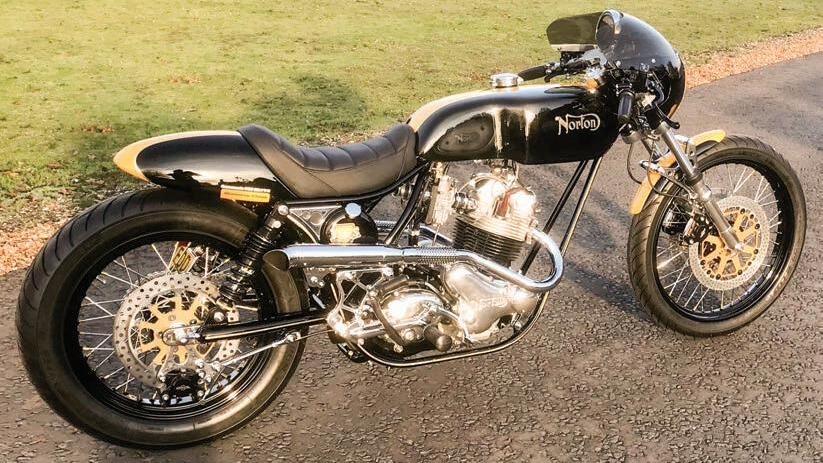
Class. The Norton’s 58-odd ponies have been upgraded with a 900cc MkIV-R motor that was commissioned and entirely rebuilt from scratch by Norton performance specialist Pete Lovell. His hot-rod tricks include a gas flowed head, a lightened crank and rockers and a Mikuni 34mm carb. The kicked-out front end is a classic Ceriani racing fork fitted with billet bracing and a 19” front wheel fitted with Beringer calipers and floating rotors. We dig the custom tubular swingarm and rear disc set-up and the stretched fuel tank that lends the whole bike a very So Cal street dragger feel. Most excellent!
Rare Suzuki Rotary
We were visiting the So Cal custom motorcycle Mecca known as The Rock Store when Dan Cregan of nearby Santa Monica buzzed in on his 1976 Suzuki RE5. Rotary bikes are a rare sight in emissions-conscious Cali, so catching sight of a Suzuki RE is fairly amazing. “It’s a 500cc but goes like a 750,” Dan bragged of the bike that sports 1970s Lester mag wheels and a rare, original exhaust system. Jeff says the Wankel-powered Suzook is a great highway bike. “I could ride to New York from So Cal, easily because it puts out around 60 horsepower and similar torque, but it’s a steady delivery and very smooth,” he said
A crowd soon gathered to check out the only bike in the lot featuring silver metaflake paint, chrome crash bars (which were big in the day) and extra-long exhausts to help burn all the gasses from the rotary engine. Suzuki had commissioned Italian industrial designer Giorgetto Giugiaro for the RE5’s unique styling, Dan says, and Suzuki’s was so confident in their Rotary powerplant, they offered buyers a full replacement warranty on engines if anything went wrong in the first 12 months. “Obviously, it’s lasted a lot longer than that,” he said.

Compiled by The Staff
36 www.caferacermag.com
Down South Suzuki



Down in Stone Gap, Virginia amateur custom builder Tim Lawson made good on something many have threatened to do: customize one of Suzuki’s underappreciated TU250 singles. The lightweight commuter bikes have a certain 1950s British thumper vibe, and their air-cooled engines and timeless steel cradle frames make them ripe for cafe racer conversions. Tim replaced the stock exhaust with a GP-style megaphone, added Ohlins adjustable shocks, a cafe seat, custom paint and ditched the bulbous side covers and very unattractive stock fuel tank and fenders. He explained the process as such: “I’ve worked every night on the bike after getting home from work. The guy I bought it from didn’t want it but he didn’t have the mental vision of what it could be. But that’s the fun of building a cafe racer – you make your own and no one has the same bike. I love the looks I get when passing by because it catches your eye very easily,” he said.
Bonnie Beauty
Just a few miles from the Rock Store lies Neptune’s Net, a fun, funky motorcycle hangout on the Pacific Coast Highway in Malibu. There, parked among the Hogs and sportbikes was Vincent Scarelli’s pristine 1970 Triumph Bonneville. Vince has owned the 650cc Triumph since 1981 and restored it to its current showroom state three years later.
“I completely disassembled it, rebuilt the engine and transmission, made my own wiring harness, and stripped and painted the frame, tank and

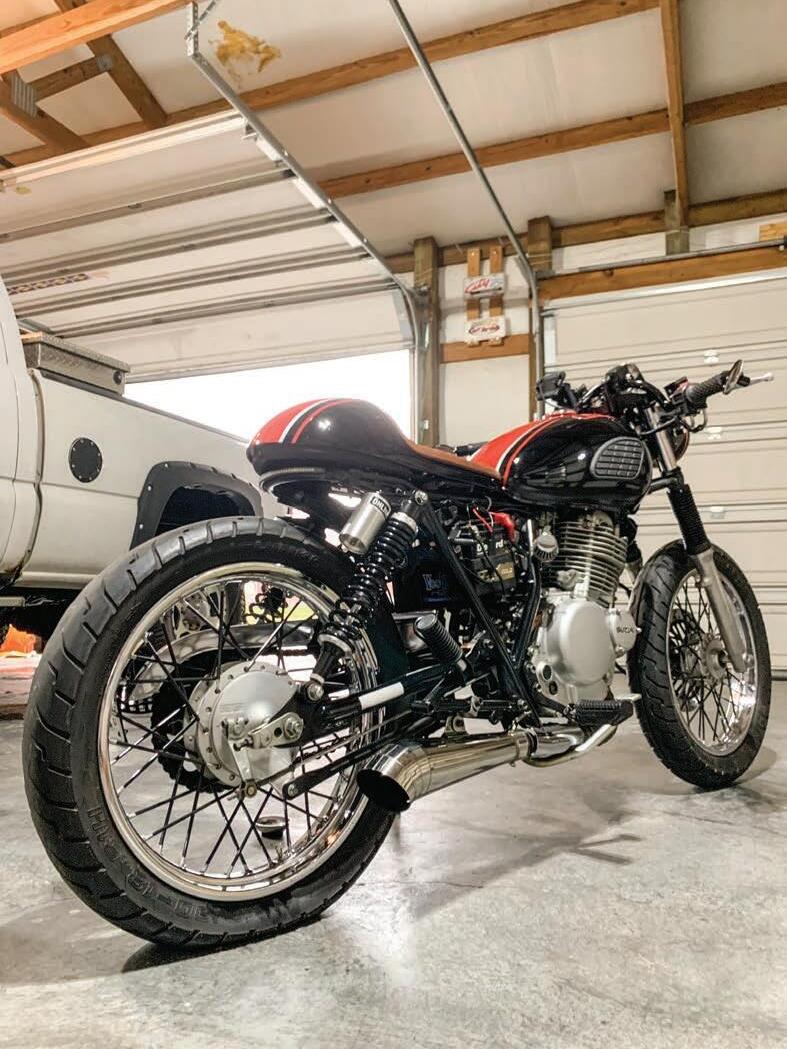

 The things I changed were these: electronic ignition, a balanced crank, a front brake drum painted black to contrast with the stainless steel spokes on the Akront shouldered rims.” Oddly, the paint isn’t original, but a different shade of red, which appealed to Vincent’s tastes.
The things I changed were these: electronic ignition, a balanced crank, a front brake drum painted black to contrast with the stainless steel spokes on the Akront shouldered rims.” Oddly, the paint isn’t original, but a different shade of red, which appealed to Vincent’s tastes.
Cafe Racer • AUGUST/SEPTEMBER 2023 37

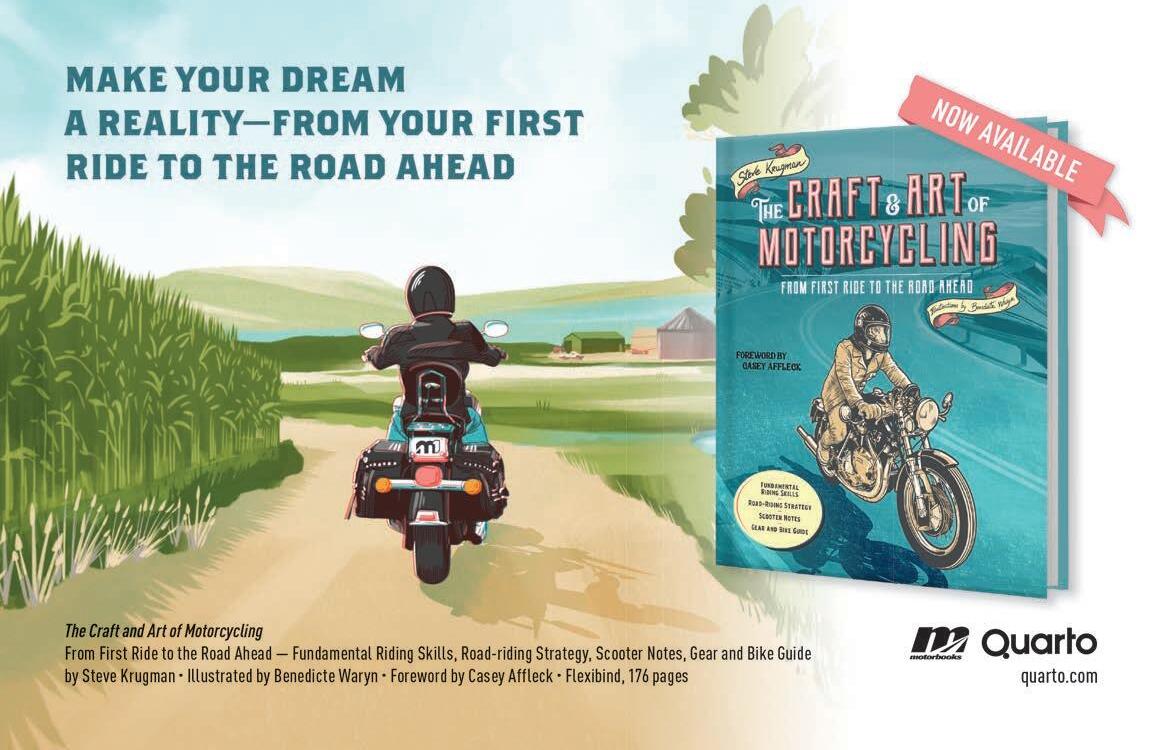


BEST BEGINNER
Compiled by The Staff
With the emergence of the Chinese streetbike market (see Open Mike Pg.6), and both Triumph and Royal Enfield launching all-new beginner-friendly machines, 2023 is looking like an optimum time to be a newbie rider. Nearly every motorcycle showroom is stocked with easy-to-master machines engineered with riderfriendly hardware specifically targeted to learners. Amenities like slip-assist clutches, low seat heights, manageable powerbands, glitch-free throttle responses and anti-lock brakes make for machines that ease the way into riding. Just think, a couple of decades back, there were few such options, leaving new riders struggling to adapt existing machines to suit their needs. No more worries about lowering rear shocks or struggling to learn proficient riding aboard an 800-pound bike designed for a grizzled veteran. It’s now a far easier ride today, thanks to manufacturers with an ear towards what new riders want and expect for their money. Here are a few of our staff favorites.
ROYAL ENFIELD METEOR 350
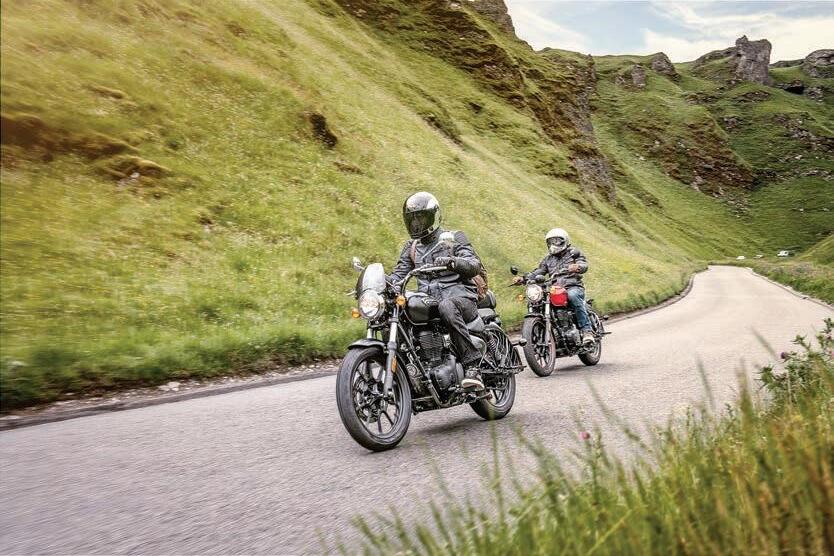
The Little Cruiser That Could has become a global sales force all its own due to an inseam-friendly 30inch seat height and a lithe 421-pound curb weight. The Indian-made single may boast only 20 horsepower, but the flat torque curve makes the Meteor perfectly capable on all but the fastest roads. The twin-shock rear suspension is basic-level stuff but the stout 41mm forks work fine. A thick accessory catalog means the 350 can be altered to suit most tastes and riding styles. Prices start at $4,199.
TRIUMPH TRIDENT
While an eager riding public awaits the arrival of the British firm’s much-anticipated 400cc singles, first-time bike buyers can find plenty to dig about Triumph’s 660cc Trident. The very practical triple borrows engine technology from Triumph’s rapid Street Triple 765 while imitating its light weight, solid braking and accurate steering. The upright riding position means an easy journey for older riders, and the Trident is one of few new bikes quick enough for experts and manageable enough for starters. $8,595 in orange, black or silver.
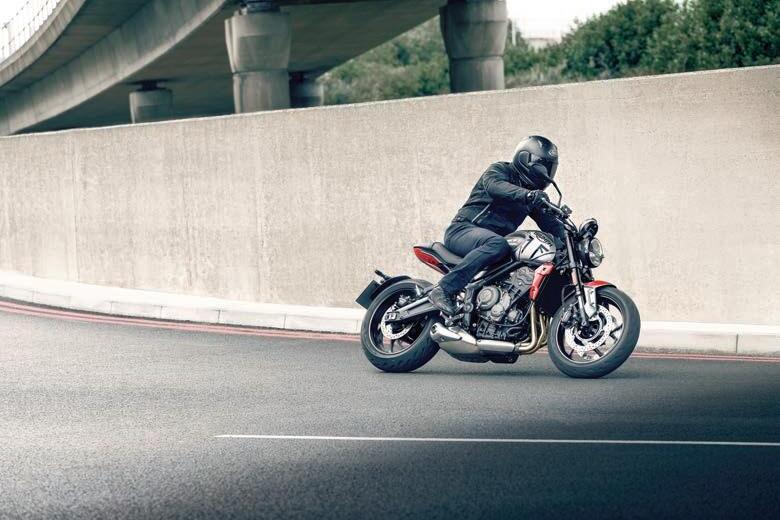
40 www.caferacermag.com
RIDES

HONDA GROM

Yes, for taller riders Honda’s globe-conquering Grom may feel a tad small, but Big Red’s mini-machine makes up for its small stature by delivering oversize fun on every journey. $3,799 gets you a street-ready bike that’s easy to park (maybe even in your office cubicle), equipped with ABS and capable of a very respectable 60-ish MPH thanks to its fuel-injected 125cc single-cylinder engine. Endless aftermarket means customization is a breeze.
YAMAHA XSR700

The smallest of the popular naked Yamaha roadsters is no pin-up queen, but the rorty, water-cooled parallel twin engine has become beloved by riders the world over. Like an XS650 for the modern age, the XSR700 combines accessible power with everyday practicality and the precise handling only a lightweight twin can provide. Not cheap at $8,999, the 700’s trellis frame and performance-oriented engineering make for a starter bike you’ll never grow out of.

KAWASAKI Z400
Team Green’s latest entry-level naked roadster is no powder puff as its steel trellis frame and zippy, easy-revving parallel twin engine thrums out a hearty 29 horses and corners like its big bore brethren. Water cooling means the baby Z will run cool even in crosstown traffic while ABS, funky, streetfighter styling and six gears means keeping up with far faster machines on a tight, twisty road. The upright riding position offers the ideal blend of comfort and performance. White is the only color option for $5,399.
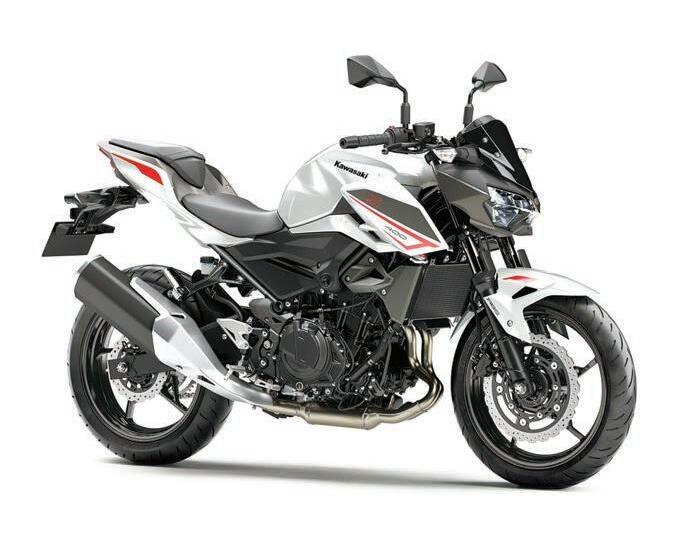
Cafe Racer • AUGUST/SEPTEMBER 2023 41
BEST BEGINNER RIDES
Looking For A Classic Starter Bike?

Consider these time-tested vintage machines. Each has garnered a decades-long fan base with enough aftermarket support to keep them rolling decades into the future. Some basic mechanical skills are necessary to keep any older motorcycle roadworthy, but the undeniable cool factor is well worth the occasional stint behind the wrenches.
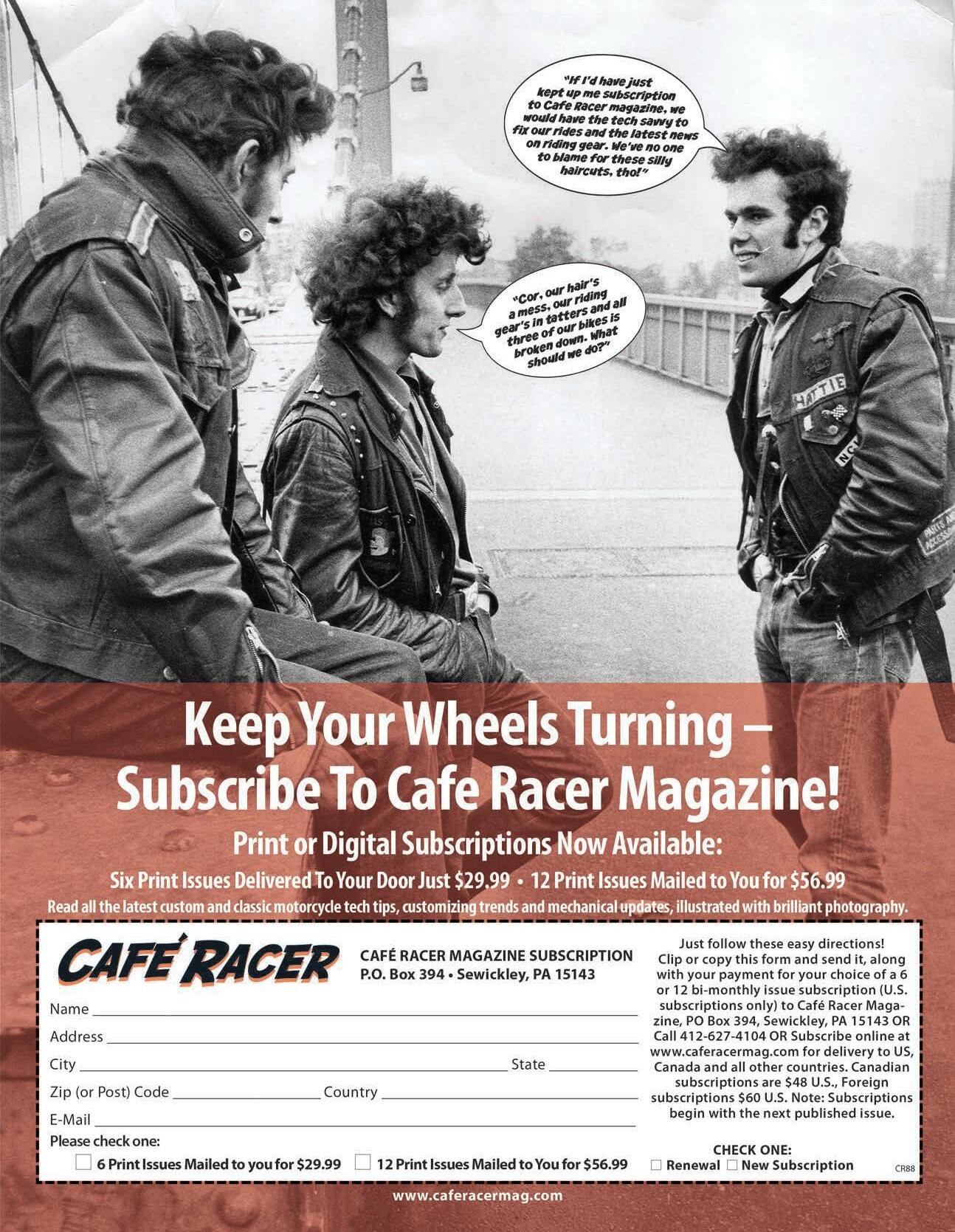
YAMAHA XS650

Billed as the Japanese answer to Triumph (and BSA and Norton) when released in the early 1970s, the bombproof XS650 has proven how well great designs endure. The power delivery is surprisingly soft by modern standards, but rev the four-valve twin hard and it’s urgency still offers surprises. And, yes, so does the vibration when broaching the XS’ 110MPH top speed thanks to its 360-degree crank. Damn near every component can be upgraded with modern amenities, including big bore kits, street tracker bodywork and track-level suspension. $3,500 and up and later models are best.
HONDA CB400F
This high-revving version of Honda’s ubiquitous 550cc and 750cc Fours was only produced for three brief years (1975-78) but has since developed an ardent cult following that’s kept prices and buyer interest high. Most 400F models have been meticulously maintained by loving owners, while the factory cafe racer looks and passing lane performance are still enviable even after 50 years. It’s tiny dime-sized pistons rev to a screaming 10,000 RPM thanks to one of the earliest six-speed gearboxes. Look for one with a clean engine, service receipts, an electronic ignition and brake upgrades and you’re destined for glory. Expect to pay around $6,000.
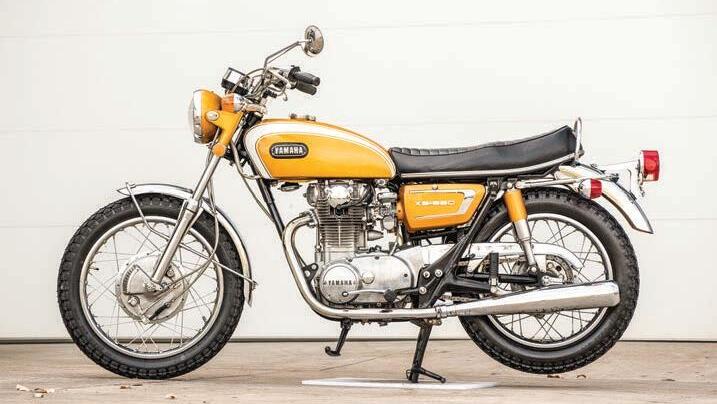
TRIUMPH T100 DAYTONA
Though sharing the larger 650cc Bonneville’s basic chassis and dimensions, Triumph’s baby parallel twin has an easier ride and far less stressful kickstarting regimen than its bigger brother. Lighter weight, bicycle-light handling and plenty of punch from the 500cc four-speed engine means backroad blasts are a breeze. Brakes are typically late ‘60s ineffective, so look for a front disc upgrade. Not for the mechanically shy, a vintage Daytona will make a technician out of anyone...if you want to ride it often, that is. $6,000 to $10,000 average.

42 www.caferacermag.com


Steve Krugman’s “The Art and Craft of Motorcycling—From First Ride to the Road Ahead”
 Story by Mike Seate Photos Courtesy Quarto Publishing
Story by Mike Seate Photos Courtesy Quarto Publishing
The delicate art of learning to ride a motorcycle has been one of the biggest challenges faced by newcomers to the sport. In recent years, professional training has become far more available with the Motorcycle Safety Foundation’s nationwide rider training courses. But for those not living in proximity to a training site or program, learning to ride is still done the time-honored way: friends, co-workers or relatives are often impromptu teachers, passing on both useful and, oftentimes, questionable advice. Author and private motorcycle riding instructor Steve Krugman has written a practical, wellresearched – and cleverly illustrated – new book aimed at removing much of the myth and mystery surrounding proficient motorcycle riding and CRM caught up with the Los Angeles resident for an indepth interview.
CRM: What prompted you to write the book?
Steve Krugman: As founder of Class: M1 Private Motorcycle Training, a 1:1 premium motorcycle and scooter school in Los Angeles, CA, a comprehensive method book was always part of the vision, if simply as a companion to training. Having put thousands of safe, happy riders on the road over a decade, I’d amassed the experience and expertise to expand the idea and add my voice in the field of rider education in a much broader way.
Our clients were constantly expressing a de-
sire for a book that addressed the fundamentals of riding and moving safely to the road that was neither over complicated nor oversimple. I recognized a definite need in the market. The Craft and Art of Motorcycling was my answer—a complete motorcycle and scooter method, written in clear, relaxed language, and fully illustrated in a way that not only bolsters understanding, but conveys the joy and fun of learning to ride!
The final result is a book we’re all very excited and proud to finally release into the world. The sincere hope is that potential, new, returning, and even seasoned roadvets will find inspiration and valuable understanding within.
CRM: Tell Cafe Racer’s readers about your
own experience with motorcycling: what was your own immersion into street riding like; did you receive any professional instruction?
S.K.: I’ve been riding for over 20 years now. Shortly following a cross-country move to Los Angeles, I was driving the Pacific Coast Highway in my car, surrounded by motorcyclists. I knew I was doing things wrong! Inspired, I soon took a three-day state-run new rider course.
Everyone’s path forward is different and very personal. For me, it was immediate neighborhood streets for a week or so and incrementally onto the mean streets of the city and beyond. So, mostly calculated and progressive, with a few unintentional leaps into the fire along the way.

I think one of the things that makes me an empathetic teacher is that I can clearly recall that early mix of excitement and anxiety as a new rider. Honestly, I’m right back in the overstuffed saddle of that red Kawasaki Vulcan 500 as I think about it!
CRM: What, in your opinion, is the most common mistake made by new riders?
S.K.: This one is a bit tricky because there’s as many formative stories as there are riders. Overall, I’d characterize over-urgency as a typical mistake of new riders. Basically, not moving progressively, incrementally and systematically forward. This might mean getting too big/heavy/powerful a machine as a first bike or introducing too many firsts too quickly. When simply riding a motorcycle or scooter is new, other firsts such as traffic, freeways, longer excursions, nighttime, rainy weather, etc. should come indi-
44 www.caferacermag.com
BOOK REVIEW
vidually and in time, as skill and confidence increase.
In fact, I’ve noticed that new riders who take a bit more time to learn and move forward, often develop stronger and more complete skill sets. Take your time and ride your ride. We all share the same roads eventually. My book is a perfect place to start.
CRM: How many hours on the bike does it normally take to become proficient?

S.K.: I prefer to discuss experience in terms of miles. In the book, I refer to the 1,000 mile rule. In the first thousand miles, a new rider begins to integrate proper skills and habits on the bike, and encounter many of the typical situations found on the road. It’s, very generally, the point where a new rider’s focus shifts from the craft of riding to the art of riding. Those 1,000 miles can come over a season or a year or even longer—again, the journey is different for everyone.
CRM: What’s your opinion of the MSF’s training program?
S.K.: I like to say that the state-sponsored multi-day group courses do the best possible job with a flawed premise: Teaching someone to ride with 11 other new riders, in a static curriculum, over a short couple days in tight confines. Those programs are thoughtfully conceived and organized, but within problematic constraints.
CRM: What role does age play in learning to ride and operate a motorcycle?



S.K.: It’s difficult to be definitive. Again, having taught thousands of riders, at this point we’ve seen a little of everything. Assuming good physical and mental health, we’ve had consistent success with riders 18 to 70 years old (and even older). Age itself is not necessarily a determinate factor. Certainly, both the energy and openness of youth and the experience and perspective of age can bring advantages. Likewise, certain limiting qualities of both youth
does demand more of us, both physically and mentally, than does driving a car, and the decision to ride, in either direction, is a personal one that requires honest self-evaluation. Ultimately, within reason, it’s never too early nor too late to learn to ride!
The Craft and Art of Motorcycling
Cafe Racer • AUGUST/SEPTEMBER 2023 45
Fun, graphic illustrations make clear what riders new and experienced need to know about motorcycling.
LI ghtnI ng IN A (WINE) BOTTLE THE MOTODOFFO DUCATI SPECIAL
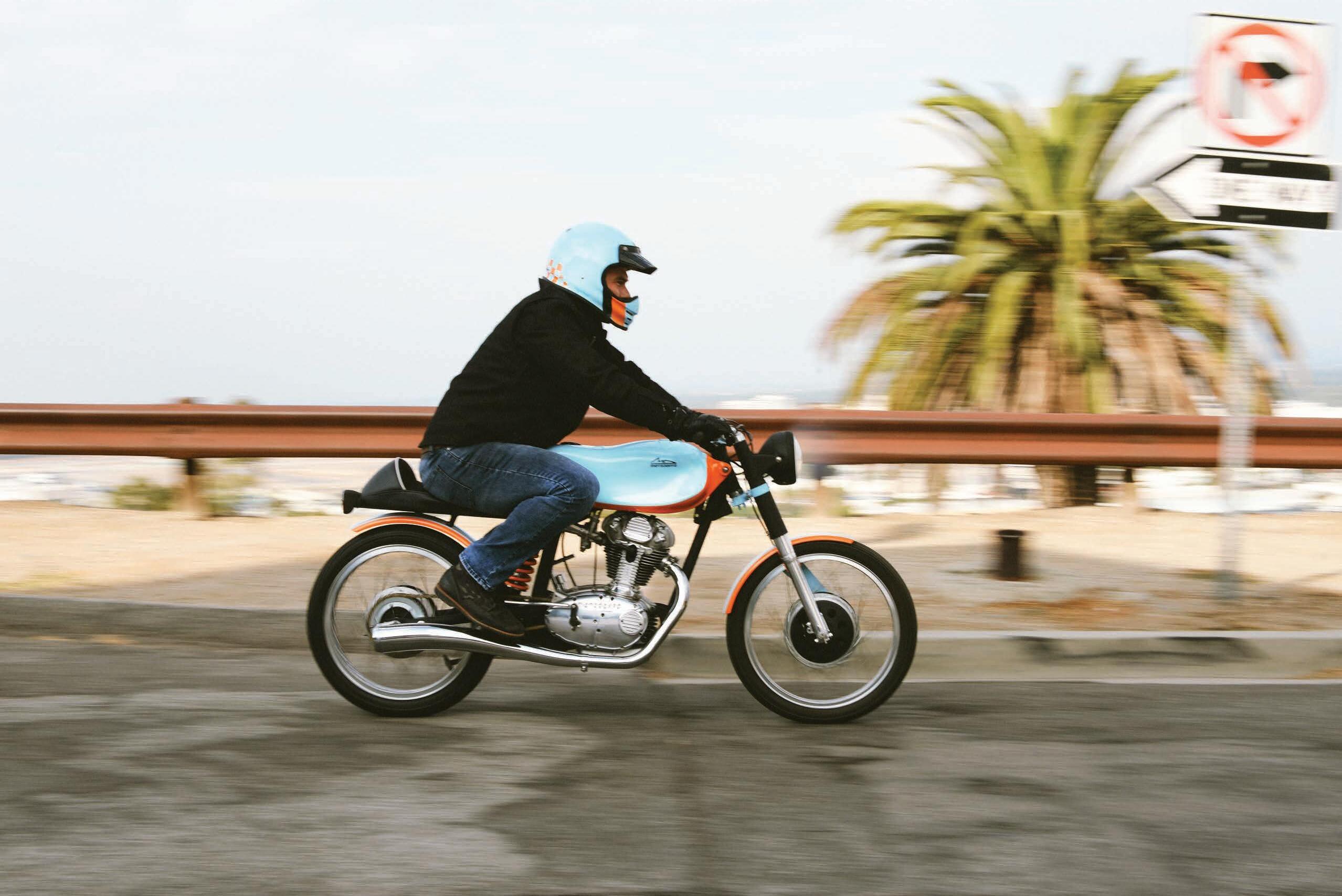
46 www.caferacermag.com
Story and Photos by Jose Gallina
Some motorcycles are unique because they’re rare, hard to find or of particular historical significance. Others are unique because they’re one-of-a-kind, built or assembled by hand to carry out some master vision. The motorcycle featured on the 2019 Super Tinto wine bottle label is a prime example of the latter. This bike, of 1959 vintage, was conceived and built by Marcelo Doffo, and there is no other like it on this planet. We caught up with Marcelo to learn more about what he calls the “MotoDoffo Monoshock 175.”

Cafe Racer • AUGUST/SEPTEMBER 2023 47
“What really inspired me to build this bike was this idea I had to change the frame into a monoshock system,” said the So Cal winemaker and vintage motorcycle enthusiast. “I was on a trip and made some drawings on my phone of how I wanted it to look. It looked like a five-year-old drew it. But to tell you the truth, it turned out pretty close to the drawing.”
An avid collector of classic European motorcycles, Marcelo grew up in Argentina and was a fan of Ducati singles since he watched them being raced on an uncle’s dirt track as a boy. Determined to own one someday, he’d been gathering parts to build his dream machine for quite some time before amassing enough bits to comprise a complete motorcycle. “I got the gas tank eight or nine years ago and knew I would eventually use it, but didn’t know what for until this project came up,” he said.
The engine is based on an old Ducati 175, but that too is one-of-a-kind, as Marcelo explained. “A few years ago I was in Arizona and saw this cylinder head, based on a Ducati 175 engine, but one like I had never seen before.” He offered the seller a reasonable price, but the owner refused because he had received it as a gift. Marcelo later saw the owner on Facebook riding a bike with that cylinder head on an engine, so he reached out to him again. This time the timing was right; he finally agreed to sell the whole engine to Marcelo.
Of all the single-cylinder Ducatis, the 175 – also known as the Sport – is among the most revered. The fourspeed machine was introduced in 1957 and threw down just 11 rear wheel horsepower, but its aerodynamics, 220-pound curb weight and racing pedigree meant it could hug corners with the best of the breed.


With the engine in hand, the project really started to come together. Marcelo replaced the bevel drive with a modern chain drive supplied by Molnar Precision, LTD. in England. He had a friend engrave the side covers with the logo from his MotoDoffo winery. Another friend down in Argentina donated a replica of an old twin leading shoe front brake system Marcelo liked. The owner took time from his busy business schedule to

48 www.caferacermag.com
With its downdraft carburetor manifold and bevel-drive tower now enclosing a unique cam chain system, the MotoDoffo 175 Sport is faster than a classic single should be.
Senor Doffo on a Ducati back in his native Argentina, home to many Italian motorcycles.

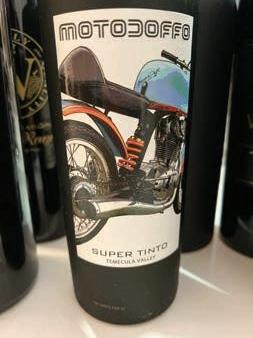

 Clockwise from top: Distinctive uneven fuel tank became known as the Jelly Mould for obvious reasons; Racing forks equipped with twin leading shoe front brakes; the Sport 175 ended up on a bottle from the owner's vineyard; the primary cover features a rare, left-side kicker.
Clockwise from top: Distinctive uneven fuel tank became known as the Jelly Mould for obvious reasons; Racing forks equipped with twin leading shoe front brakes; the Sport 175 ended up on a bottle from the owner's vineyard; the primary cover features a rare, left-side kicker.
design and build the humpback cafe seat from leather and a custom seat pan. Next came modifying the frame to accept the monoshock suspension unit. The fully-adjustable Fox Racing shock required special mounting tabs to be welded onto both the chassis and the round steel swingarm, but the steering geometry proved perfect, improving the bike’s handling to modern standards, Marcello said. While working on the fragile 1950s electrics, he decided to replace the original lighting equipment with LED lights to bring this build into the 21st century. Marcelo even ran all the wiring inside the frame tubes, giving the bike a very clean look.

“Another unique piece is the tail pipe,” Marcelo said of the exhaust that resembles an MV Agusta exhaust system from the 1960s. “I was in Italy and went to purchase a tail pipe for this bike. I wanted to take it with me in my suitcase, and was asking the people at the company how we could do this. An employee overheard us and agreed to make one for me. He didn’t finish it so I could get it chromed back home. It’s really one of the most interesting features.”
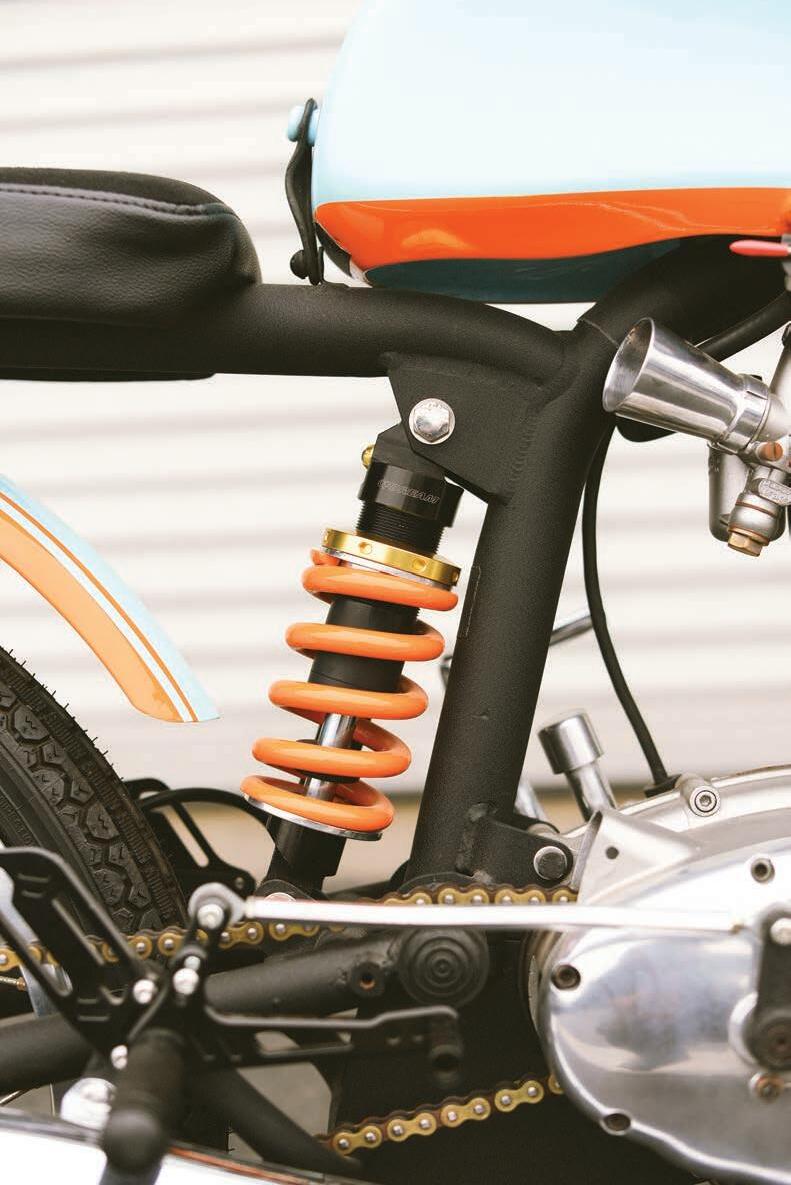
Finally it came time for the finish. “Some visitors from Italy came to the winery and gave me a helmet with these light blue and orange colors, so I decided to paint the bike to match the helmet. People have said it looks like the Gulf Porsche color scheme, but I intentionally put the stripes only on one side to differentiate it.” Marcelo assembled the bike, which made its debut at the 2019 Moto Beach Classic and again at the International Motorcycle Show in Long Beach, CA.
The MotoDoffo Monoshock 175 is now further immortalized on the 2019 Super Tinto label, with original artwork by Roland Sands. For more information on the MotoDoffo Collection and to see some of the other bikes, visit www.motodoffo.com.

50 www.caferacermag.com
To shore up the handling, the MotoDoffo team re-engineered the rear suspension, adding a Fox Racing monoshock unit.
Singing a single-note aria, the custom muffler has designed in (where else but) Italy.





The Market
Sellers beware
The Growing Threat of Motorcycle Sales Scams
 Story by Nick Coumos and Mike Seate
Story by Nick Coumos and Mike Seate
“Ihave several Nortons in my basement that I’ve had for decades and this winter I decided to sell a bunch of them off. I needed the room in my garage and they were just gathering dust, so I figured it was time to clean them up and let somebody ride them,” Nick Coumos, the magazine’s resident Norton Whisperer recently shared.
“The problem is, the only contacts that came
users, but the first guy who texted me obviously wasn’t on the level. He offered me the $4,000 asking price with absolutely no questions about the bike, it’s current condition, the title, nothing. When I called the number he had texted me from, he didn’t have any idea about Nortons or classic British bikes whatsoever. He just asked if I’d take a cashier’s check and then he’d send some guys over to pick the bike up. He kept asking me for my home address so he could arrange shipping, as if he was in a real hurry. It all seemed too simple, so I went to my bank and asked if cashier’s
to clear. By then, the thieves have picked up the bike and are long gone before you realize the check is bogus, Then you end up having to repay both the bank and the shipping company.”
Nick’s story is familiar to anyone who has recently ventured into the murky waters of online motorcycle sales. The days when sellers placed classified ads and then awaited eager customers responses are long gone, replaced by a stupefying minefield on bogus offers, texts from pirated phone numbers and com-
54 www.caferacermag.com
Remember the good old days when you only had to worry about thieves hot-wiring your motorcycle?
sales sites, my cell phone routinely buzzed with texts from clever scammers.
Most began with a rote assortment of questions that revealed their underhanded intents from the go. “Is the motorcycle still for sale?” the texts would always begin, followed by questions about the motorcycle’s condition and year, facts which were clearly stated in the online ad. The texts were written in a strange, broken English, with many common words misused or placed glaringly out of context. “Is the very fine wheels still on sale, my dears,” read one message.

To satisfy my morbid curiosity, I called the numbers as they appeared on my phone, but each resulted in an automated message stating the phone number does not exist. Others numbers belonged to unnamed caller who had no voicemail service.
Both intrigued and a little rattled by the frequency of the attempted scams – in five weeks, only two genuine inquiries came through – I phoned Cycle Trader’s fraud hotline where an employee working under the name Che explained what Nick, myself and countless other motorcycle sellers had experienced. “These are big overseas crime
organizations who send hundreds of texts to people using untraceable phone numbers,” he explained. Che was very familiar with the arcane workings of theft rings, which is why Cycle Trader advises sellers not to list their contact phone numbers in classified ads. “They’re hoping people aren’t aware of the fact that cashier’s checks can be forged,” he said.
We spoke with Pennsylvania State Trooper LT. Adam Reed, who said their department monitoring online scams has seen an “across the board uptick in scams, not just for motor vehicles.” Last year, they foiled a scam where a racehorse was stolen using a fake credit card number, and were able to track down the thief. Trooper Reed said these can become very complex investigations that require much manpower.
So how do you sell a motorcycle when thieves seem to be constantly upping their nefarious game?
“Just use common sense,” he says. “If the solicitation sounds too good to be true, it probably is. Ask to speak with the person over the phone and oftentimes you’ll see that the grammar and English is very poor, indicating it’s very likely they’re operating out of country.”
Trooper Reed also warned of the abundance of fake cashiers checks. “If anyone offers to send you a large sum via check, be leery. They’ll ask you to cash it and send back the difference or keep an overage. The vast majority of online transactions for privately sold

vehicles on Facebook Marketplace or Craigslist are big origination points for scams.”
The phrase buyer beware seems less than adequate in these circumstances, but I did manage to find a means of stopping the text messages. I sent the bogus buyer a message letting them know I was aware of their scam, which instantly ceased messages pouring in from several numbers at once. If this isn’t your cup of tea, experts suggest demanding potential buyers bring cash and ID to purchase your motorcycle and refrain from revealing the bike’s – or your own – location until absolutely necessary.
Scam Deterrents
Experts in vehicle theft scams advise buyers and sellers to use common sense when looking to purchase or sell a motorcycle. Here are a few quick rules to follow.
1. If it seems too good to be true, it is. That pristine 1966 Triumph Bonneville for $3,000? It’s as likely to exist as unicorn poop.
2. Seller or buyer unavailable for the near future? Texters claiming to be working outof-country or unable to answer phones are a serious red flag. Conversation is king.
3. Don’t fall for sob stories. Is a buyer claiming they can barely afford your bike and in need on a few grand discount? Walk away.
4. Don’t accept any “generous” overpayments.
5. Cash is king. Never accept personal checks and if handed a cashier’s check, make sure it clears your bank before signing over your bike’s title. CR
A screen shot of the final exchange between Seate and a wouldbe scammer. Once they know a seller is on to their game, most will break off contact.
Nick’s Norton, pulled from the treacherous waters of online sales sites and now on offer at a local classic British bike shop. Smart move.

Trust is a huge part of any custom motorcycle build, particularly one taking place thousands of miles away. A customer trusts several thousand dollars of their hard-earned cash to a virtual stranger who is expected to execute their vision for a dream machine based on hope, reputation and trust.
Just ask Rob Chappell of Toronto, Canada’s Origin8or Custom Cycles, who was enlisted to transform an ordinary 2008 Triumph Speed Triple 1050 into this stripped-down neo cafe racer for a builder in Wales, UK.
Chappell, who has the formidable skills to tackle some out-of-the-box customs, says the owner was visiting North America and “just dropped off an engine and frame that he placed on my fab table, describing what sort of bike he wanted. I knew right away that meant fabricating everything from the swingarm to the frame and the bodywork,” Rob said.

How’s this for a narrow, waspwaisted profile. Two frames were made before settling on the one-off chassis.
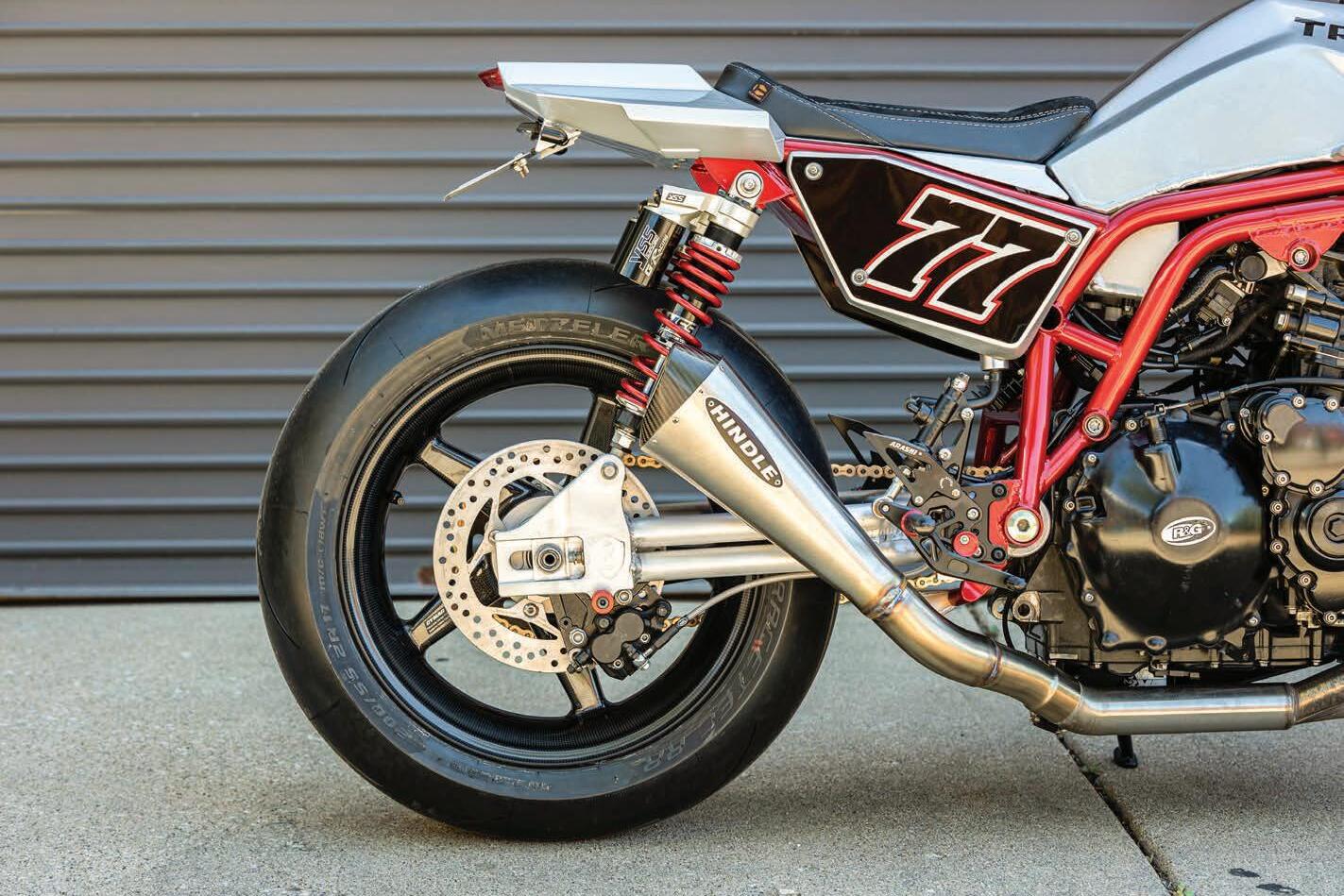

The only things remaining from the donor machine are the motor and the front forks, and due the restrictive safety requirements facing custom bike owners in the UK, Rob said one of the main goals was making the Triumph street legal. “The owner insisted he wanted to ride the bike so it had to have turn signals, mirrors, good instruments, everything,” he said. With a fairly tall budget to work with Rob set about sketching designs for an improved chassis, one that – bucking trends – would swap the Triumph’s monoshock rear damper with a pair of twin shocks.
This may appear to be a technological step backwards, but Chappell swears the machine’s handling is actually better thanks to his one-off frame design. “The adjustable YSS shocks are pretty stiff and the whole package works really well on the road,” he said.
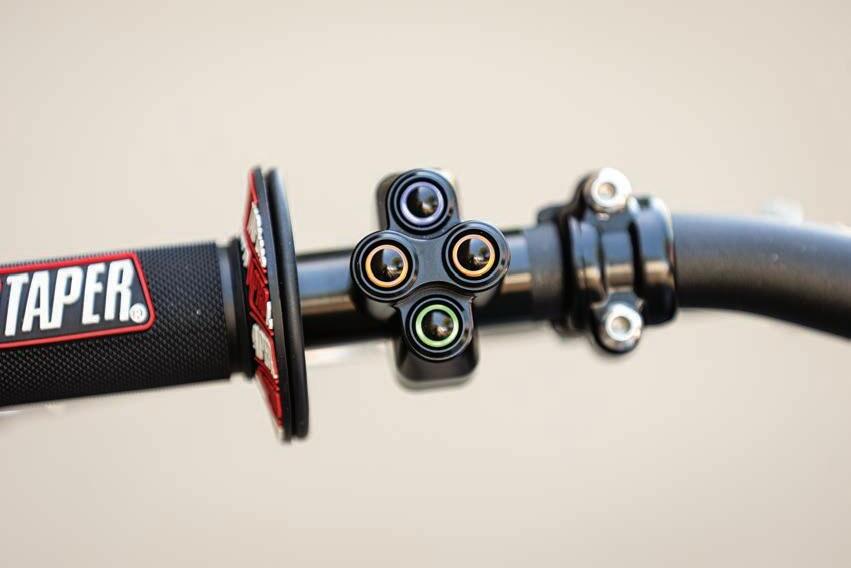
“I wanted to build a street tracker/hooligan bike more in the lines of what a strippeddown modern Triumph should be,” he said. As with classic ton-up bikes, the bodywork is all constructed from lightweight aluminum alloy. Rob invested some 3,000


bulging through its surface are actually legal for UK road use while the taillight includes a license plate illuminator as well. As the first-ever modern Triumph project for a builder more accustomed to classic Japanese machines, the Triumph’s complex wiring and fuel injection system presented special challenges, Rob admitted. “I don’t even want to count how many hours I have
It turned out the complex CAN-bus wiring system wouldn’t engage the ECU’s starting sequence without the stock gauges wired into place, so they ended up buried beneath the seat unit, believe it or not. Up front in the compact cockpit area, the Motogadget single instrument is wired through one of the German firm’s popular M-unit control modules. Mini turn signals
Cafe Racer • AUGUST/SEPTEMBER 2023 59
Twin YSS shock rear end adds a vintage touch to a fully-modern custom. Hindle muffler is fitted to an Arrow header system.
Rebelmoto push-button switches look like they’re stolen from a MotoGP racer.
(also Motogadget) and other ancillaries are operated via clusters of Rebelmoto pushbutton switches that look very MotoGP. Rob’s brother created the ribbed seat upholstery at his Tuffside shop while the flush-mounted gas cap is an Origin8or part.
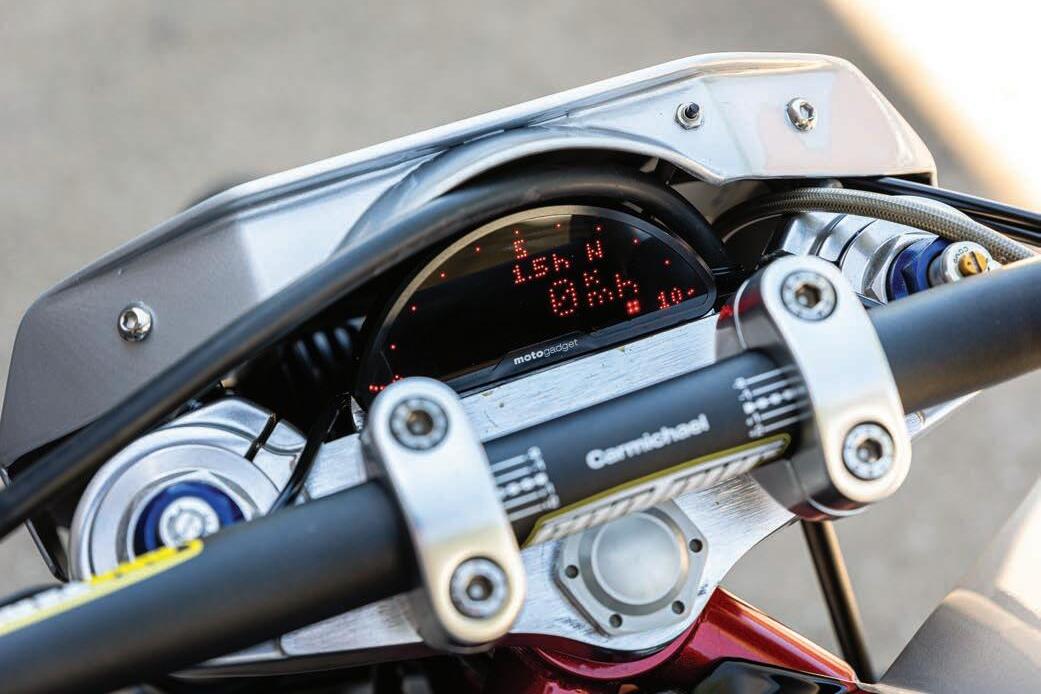
Besides the eye-catching red powdercoated chassis, the one-off swingarm is among the Triumph’s best bits. Starting with a pair of sturdy triangular aluminum shock mounts that double as axle holders, Rob enlisted the help of Joe Kaslowski at California’s Random Fabrications to weld up the swingarm from scratch. The swingarm fabrication proved a different ball of wax as the original design for a cradle frame proved too ungainly once around 90 percent complete. “Instead, I took a good look at it and decided to scrap the whole frame and start over again,” Rob said. Drawing inspiration from British streetfighter frames he’d dreamed of owning as a youngster, Rob designed an all-new chassis to resemble a classic Spondon or Martek kit bike.

Starting with a machined headstock and working his way rearwards, the frame, utilizing twin alloy rails and custom engine

60 www.caferacermag.com
Finely angled bodywork is all aluminum, including the handmade radiator shroud.
That’s a Motogadget digital gauge wired through a matching M-unit controller. High-tech electrics were the build’s biggest challenge.
engine in factory tune to keep things simple. Of course Rob couldn’t help but tear into the exhaust system, mating a set of Arrow stainless steel header pipes with a snarly Hindle canister. The resultant exhaust note is a satisfying, three-cylinder bark that’s certain to raise a few eyebrows in the Welsh countryside.

Finishing touches include a set of 17” Dymag carbon fiber wheels and the silver/red and black paint and racy numberplates and, you fans of Welsh rugby may notice, the country’s proud, fire breathing dragon motif on the fuel tank. “The owner really wanted me to incorporate the dragon because he wanted people to know who the bike was built for,” Rob said. CR


Cafe Racer • AUGUST/SEPTEMBER 2023 61

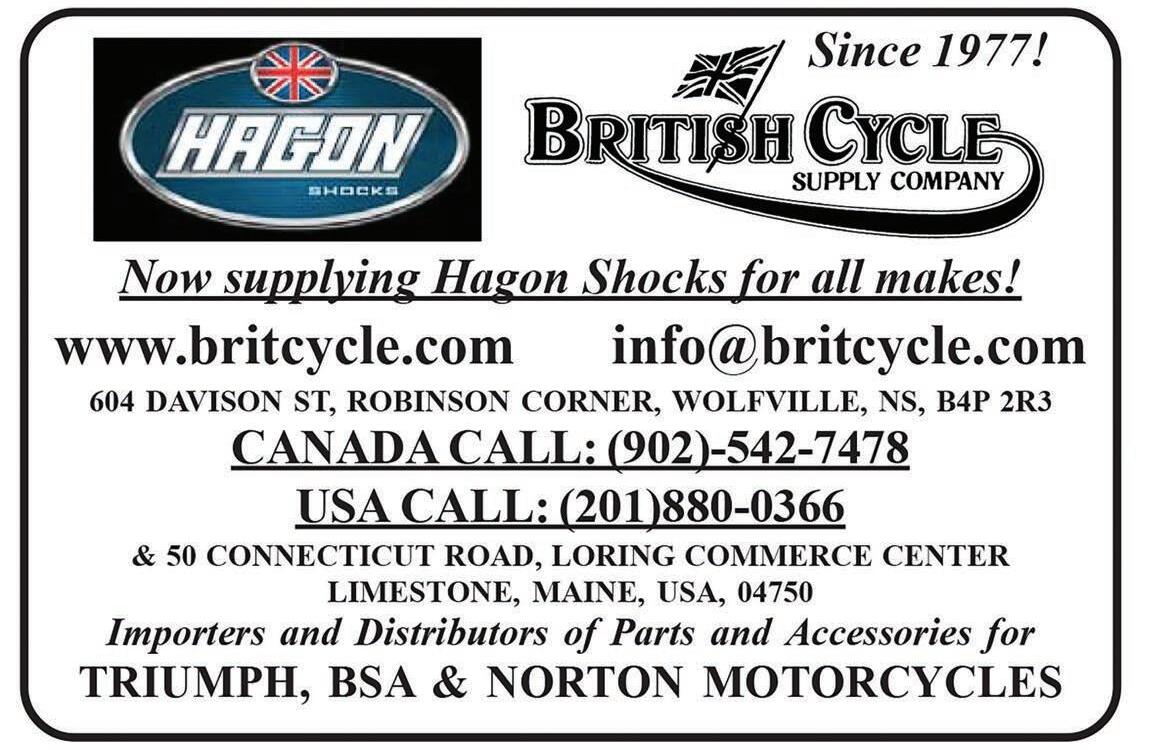

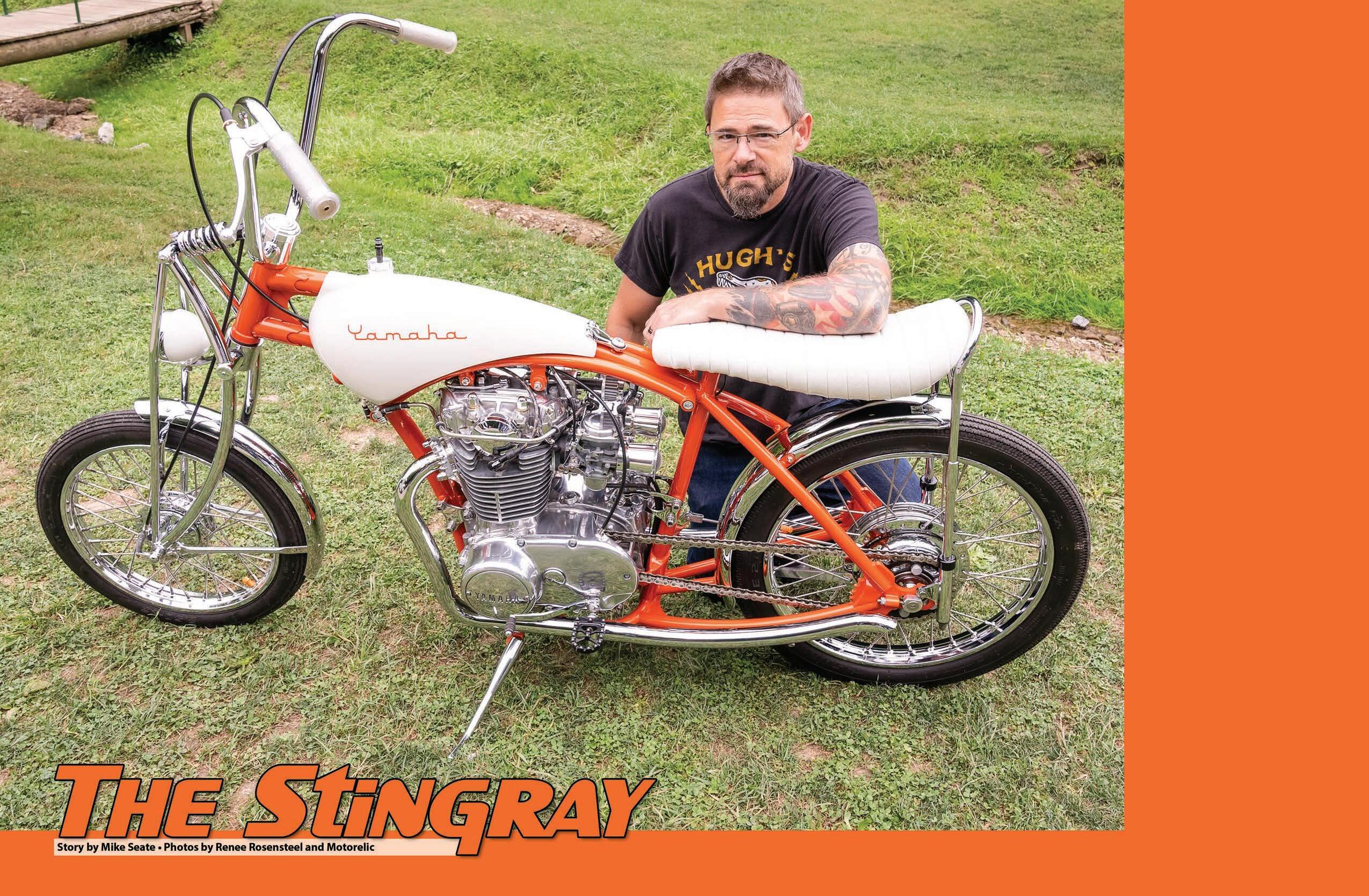
While the title on the cover of this publication pretty much spells out what sort of motorbikes we prefer, what’s one to do when a machine turns up at the annual Readers Ride-In Custom event that defies categorization? It has happened before in our 15 years of staging competitions for handbuilt streetbikes, but few have mesmerized and astounded both attendees and judges like Sean Skinner’s Schwinn Stingray replica.
For those of you who missed the 1960s, chopper motorcycles, while initially derided as toys for grungy, drugged-out outlaws, somehow worked their chrome-leaden way into middle America. Extended forks, long, narrow seats and chrome sissy bars suddenly became not only acceptable, and toymakers even made choppers seem downright adorable. Remember the Big Wheel? That noisy, pedal-powered kiddie contraption was little more than a hard plastic representation of the cobbledtogether trikes made famous by West Coast cycle gangs. Not to lose out on a the-unmentionable-is-now-cute trend, the Schwinn Bicycle Company unleashed the Stingray in 1963. The bicycle featured tall apehanger- style handlebars, a so-called banana seat and bold metalflake paint straight out of Tom Wolfe’s “KandyKolored Tangerine-Flake Streamlined Baby.”

Cafe Racer • AUGUST/SEPTEMBER 2023 65
Motorelic. Skinner’s prodigious talents have graced these pages before as his one-off cafe customs have rolled away with their share (and several someone else’s) of top prizes at our annual shows for nearly a decade. Whether focusing his multi-level metalsmithing skills on restoring a classic Japanese four or dreaming up an all new interpretation of a rare Honda or Yamaha, Skinner is a custom motorcycle builder with an eye for both function and the seriously far-out.
The Stingray – based on an air-cooled 1978 Yamaha XS650 twin – is just such a machine.

When asked how he designed this bicycle/motorcycle hybrid, Sean let out a characteristic laugh and shrugged. “This is the iconic bicycle in motorcycle form. I can’t say what really inspired me because I don’t know what goes through my head sometimes, but I just had to do it,” he said.
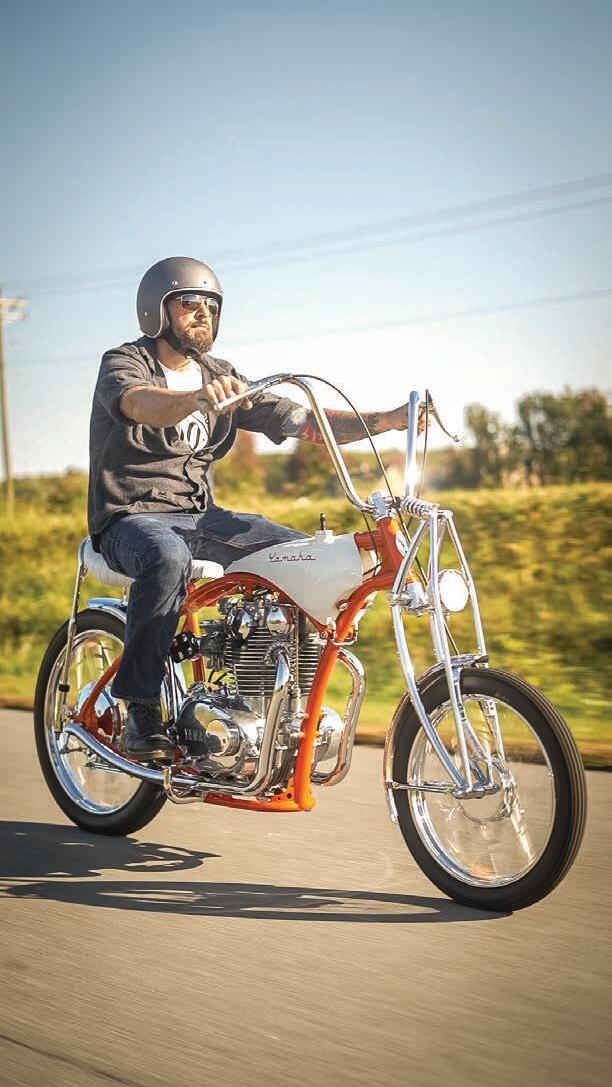
The project began with Sean cutting away the headstock from the Yamaha chassis, saving just that section to preserve the VIN. In his first-ever attempt at building a one-off chassis, he engineered a frame jig to hold the metal tubing in place where sections were slowly welded together. But first came sessions bending PCV tubing, which is far more malleable than steel used in the final construction.
Studying the swooping, gracefully arcing lines of the original bicycle chassis, Sean fabricated the lower engine cradle then engineered in the motor mounts and areas where the chromoly rails would require strengthening. Bicycles, after all, don’t have
 The 1978 Yamaha XS650 engine is well-tuned having been treated to a Hugh’s Hand Built crank conversion, big fin cylinders and open exhausts.
The 1978 Yamaha XS650 engine is well-tuned having been treated to a Hugh’s Hand Built crank conversion, big fin cylinders and open exhausts.
vibrating oil-filled internal combustion engines which have to be mounted level in their frames in order to function properly.

Then, as sometimes happens during complex custom motorcycle builds, Sean was forced to put the Stingray Yamaha on hold for several years. “I’m not sure if I lost interest or lost confidence in tackling something this complex, but I finished a couple of other customer builds before locating a perfect XS engine a friend was selling and starting over again,” he said.

That self-enforced sabbatical from this, the most challenging of Motorelic projects, permitted Sean to amass more expertise in fabrication, a skill the Stingray build required in abundance. For example, the motorcycle Stingray would need fuel for the engine to operate, but what sort of gas tank would look right? As if by providence, Sean noticed an old Yamaha Virago tank hanging on the shop wall that gave inspiration. Cut up and reconfigured, the Yamaha tank was carefully modified to sit atop the narrow twin frame rails.”
The next phases of construction came together nearly as meticulously, with the dual brain-busters of determining fork design and replicating the Schwinn’s spindly, highrider wheels just right. “To get the look of the bicycle’s comically huge rear wheel right and make the thing rideable, I had to


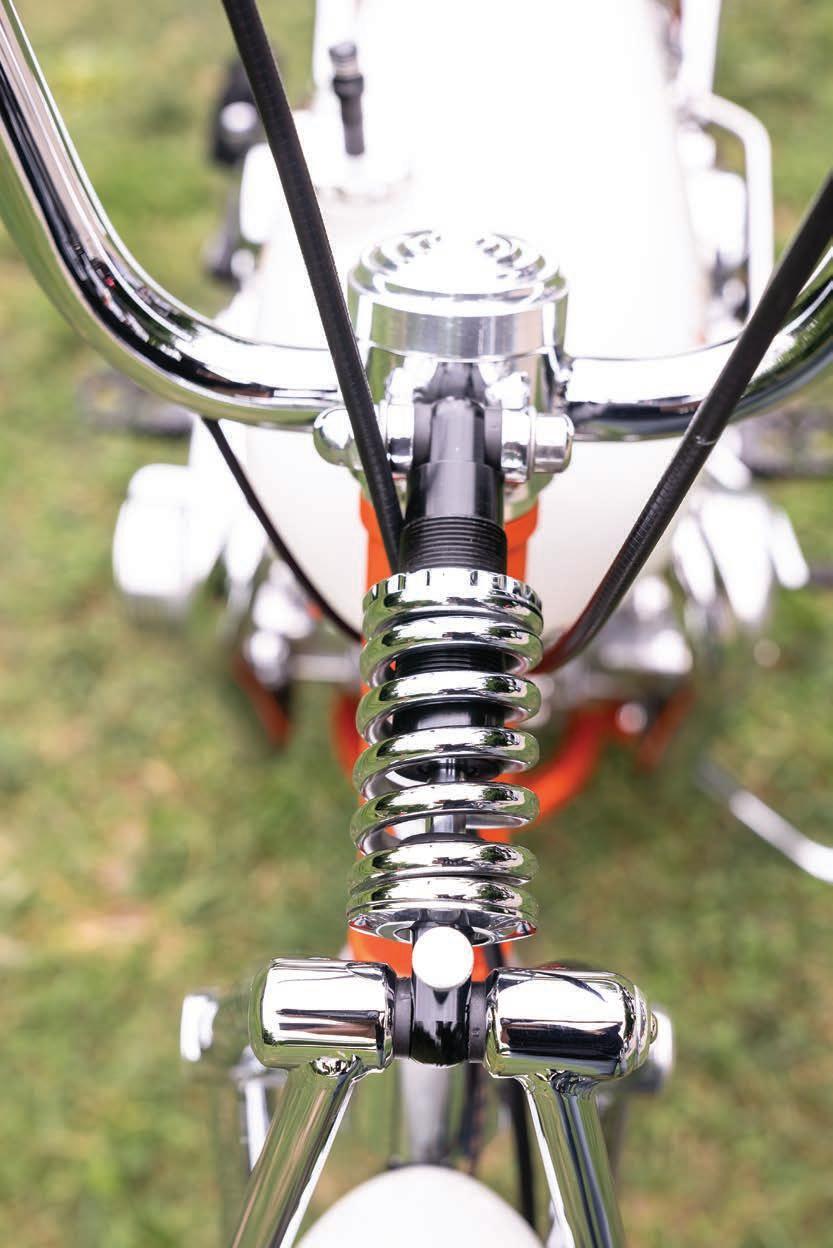 That’s a mountain bicycle’s shock absorber helping to soak up bumps from the handbuilt girder front end. Clever.
Unrecognizable today, the sleek two-gallon split fuel cell started off as a discarded Yamaha Virago tank.
That’s a mountain bicycle’s shock absorber helping to soak up bumps from the handbuilt girder front end. Clever.
Unrecognizable today, the sleek two-gallon split fuel cell started off as a discarded Yamaha Virago tank.
21” chromed rim in extra-skinny 2.25” width. And where, Sean wondered, to place the exhaust pipes, another necessity that bicycles don’t have. Eventually, he settled on a pair of very long, narrow drag pipes that run so closely to the bottom frame rails they’re hardly noticeable.


Similar conundrums presented themselves when planning out the replica girder fork. A lengthy Internet search turned up a shop specializing in fabricating custom girder
front ends for choppers, but when communications broke down, he convinced the builders to machine a custom neck stem and a tiny set of triple clamps that he’d later weld the swooping girder legs to.
The Stingray is one of those custom bikes that reveals more of itself the longer it’s stared at. A small mountain bike shock has been modified to the forks Ala Vincent Girdraulics to make the ride a bit more bearable. A pair of apehanger handlebars were

cut apart with the lower junction welded directly to the top of the front end. Best of all, to recreate the springs mounted beneath the Schwinn’s banana seat, Sean sourced a pair of springs from a mechanics’ favorite store, McMaster-Carr, which were modded to fit just right.
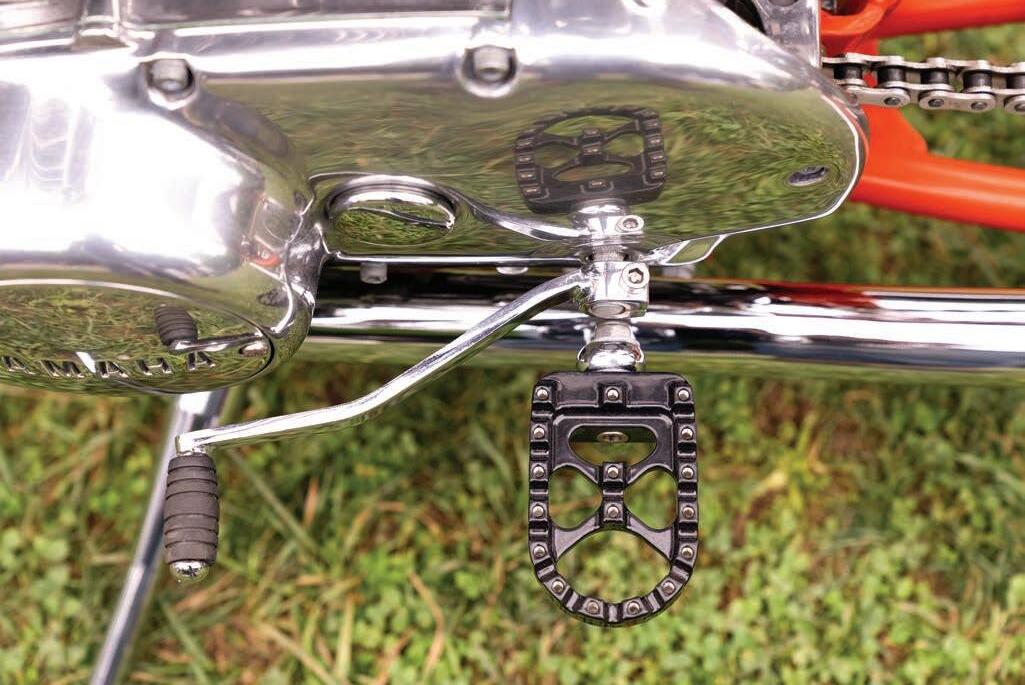
Hacking out the narrow seat pan from metal, he then sculpted the padding from foam before having it upholstered in a very 1960s white vinyl. The upholstery is even
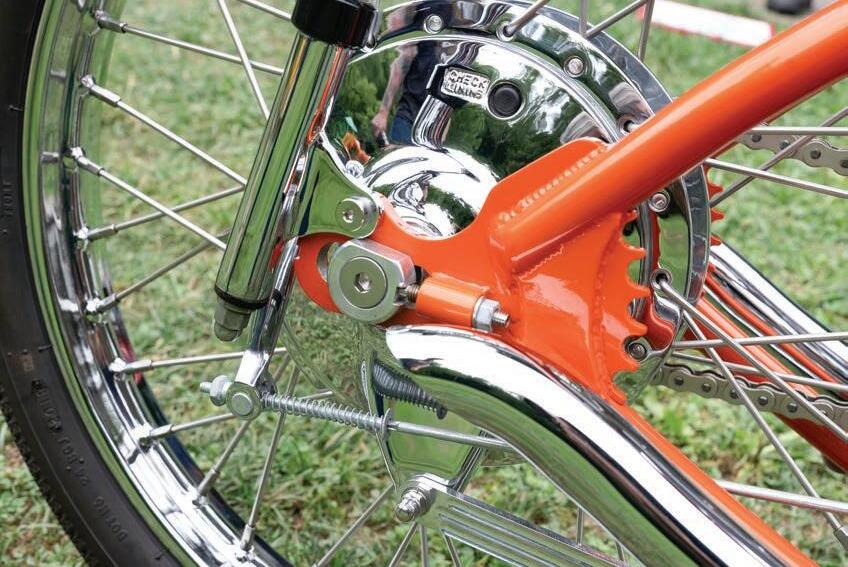
68 www.caferacermag.com
The rear chrome hub is from a Yamaha XS and is sprung just like on the bicycle. No baseball cards between the spokes just yet.
What do you expect? Choppers don’t have front brakes, do they?
ribbed, just like we remember from childhood. For whose pleasure, we wonder.
When we photographed the Stingray at last August’s bike show, Sean admitted he’d only logged a few miles on the bike, the chromed-out XS engine still plinking in the summer heat as it cooled. “I plan to get some more miles on it and I’m surprised it rides as well as it does,” he said with a laugh. He may be, but we certainly are not. CR



When Ugly Rules
Like vertical stripes down the legs of bell-bottom pants, gatefold double-album covers and Fu Manchu mustaches, motorcycles and motorcycle accessories have occasionally fallen victim to bad taste. Though period-specific icons like elaborately airbrushed conversion vans and soft rock seemed the height of trendy sophistication, looking back with the wisdom of the years proves that we motorcyclists were either devoid of good taste or smoking something mighty potent at the time. Take a gander with us at some of the more aesthetically questionable two-wheeled fashions from the past century. Feel free to grimace in embarrassment if you’re guilty of committing one or more of these visual crimes..
King and Queen Seats
What raked-out chopper or slowrevving cruiser was complete without one of these lavishly upholstered twoup saddles. Designed to place a pillion passenger loftily above the rider, these leather Barcoloungers had the same effect on motorcycle aerodynamics as a six-foot windshield.
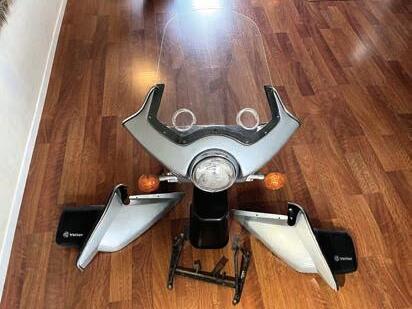
Windjammer fairings
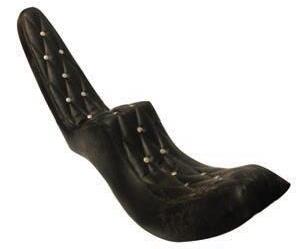
Everybody respects the brilliant work of motorcycle engineer Craig Vetter, but his massive-selling Windjammer fairing kits left a bit to be desired in the looks department. The angular fiberglass fairings now appear as dated as listening to a Captain and Tennille 8-track tape in your Chevy Vega, making one wonder: how ugly were streetbikes during the 1970s for these to be considered an improvement?
Ultra-Wide Rear Wheels
Here’s an idea: take a sportbike engineered for optimum cornering prowess and instantaneous turning capabilities and render those points entirely moot by adding a rear wheel wider than the Mighty Mississippi. Popular in the early 2000s, the result of these over-thetop modifications was a motorcycle that handled like a Roomba vacuum on a thick, shag carpet.
Early British Choppers
After watching American biker gang flicks, a generation of European riders went hog wild (no pun intended) over choppers in the late 1960s. Bereft much of a parts aftermarket, many subjected their otherwise solid Triumphs, Nortons and BSAs to a horrendous, safety-compromising series of alterations. Would Sir like a set of rickety, 20” extended forks made from porch railings and a tiny front wheel without a brake? Right this way, custom builders crowed. It’s amazing that so many riders lived to become ashamed of butchering such fine machinery.
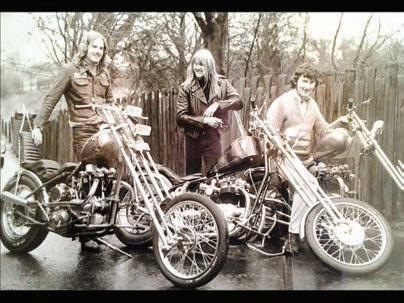
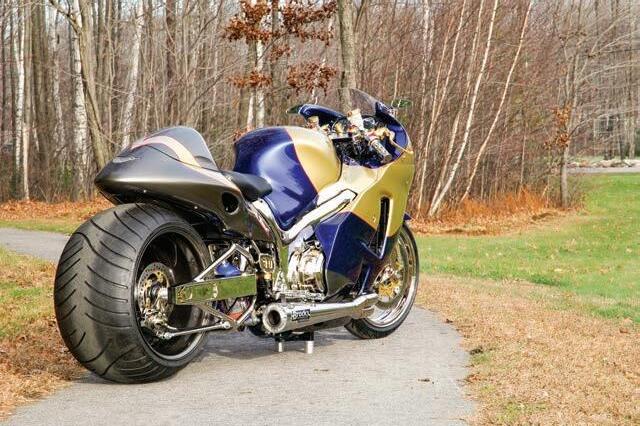
27” Front Wheels
This West Coast lowrider style has ruefully caught on with cruiser riders everywhere. Makes each corner entry, regardless of how slow, a bum-clenching, nerve-shattering experience.

70 www.caferacermag.com STYLIN’
Furred Out Sportbikes


Favored for a brief time by Ohio-based motorcycle stunt team The Starboyz, these shaggy superbikes were once a frequent site on highways where they were ridden on one wheel with the riders perched atop the gas tanks and handlebars. Historical note: though downright silly, maybe they eventually inspired today’s anthropomorphic Furry movement, for better or worse?
Sky-High Tailpipes
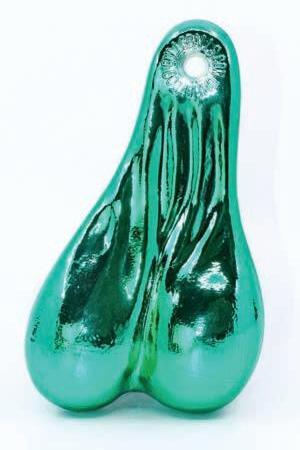

Ever wonder why so many veteran bikers wear hearing aids? Well, during the late 1960s, it was fashionable to weld together extreme lengths of exhaust pipe, some so tall that their decibel-blaring open ends sat nearly level with the ears of both rider and passenger. And if you weren’t deafened, the risk of contact burns was fairly obvious.
Stylmartin Roadracing Boots
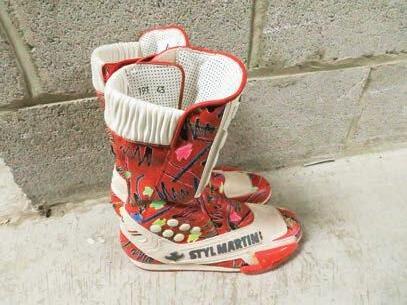

Like a bizarre cross between a disco roller skate and abstract painter Jackson Pollock’s drop cloth, the speckled, paint drip pattern riding boots offered riders both maximum protection and clown-shoe silliness at the same time. Apparently highly valued today by 1990s ironists and others too young to remember when these were on sale.
Bulls Balls
When, ahem, hung from the rear fender of a motorcycle these were designed to tell the world that, well, we’re still not sure what the intended purpose of these plastic bull testicles was, except to perhaps show the word that the motorcycle owner was in desperate need of a prostate exam.
Cafe Racer • AUGUST/SEPTEMBER 2023 71
Custom Scene

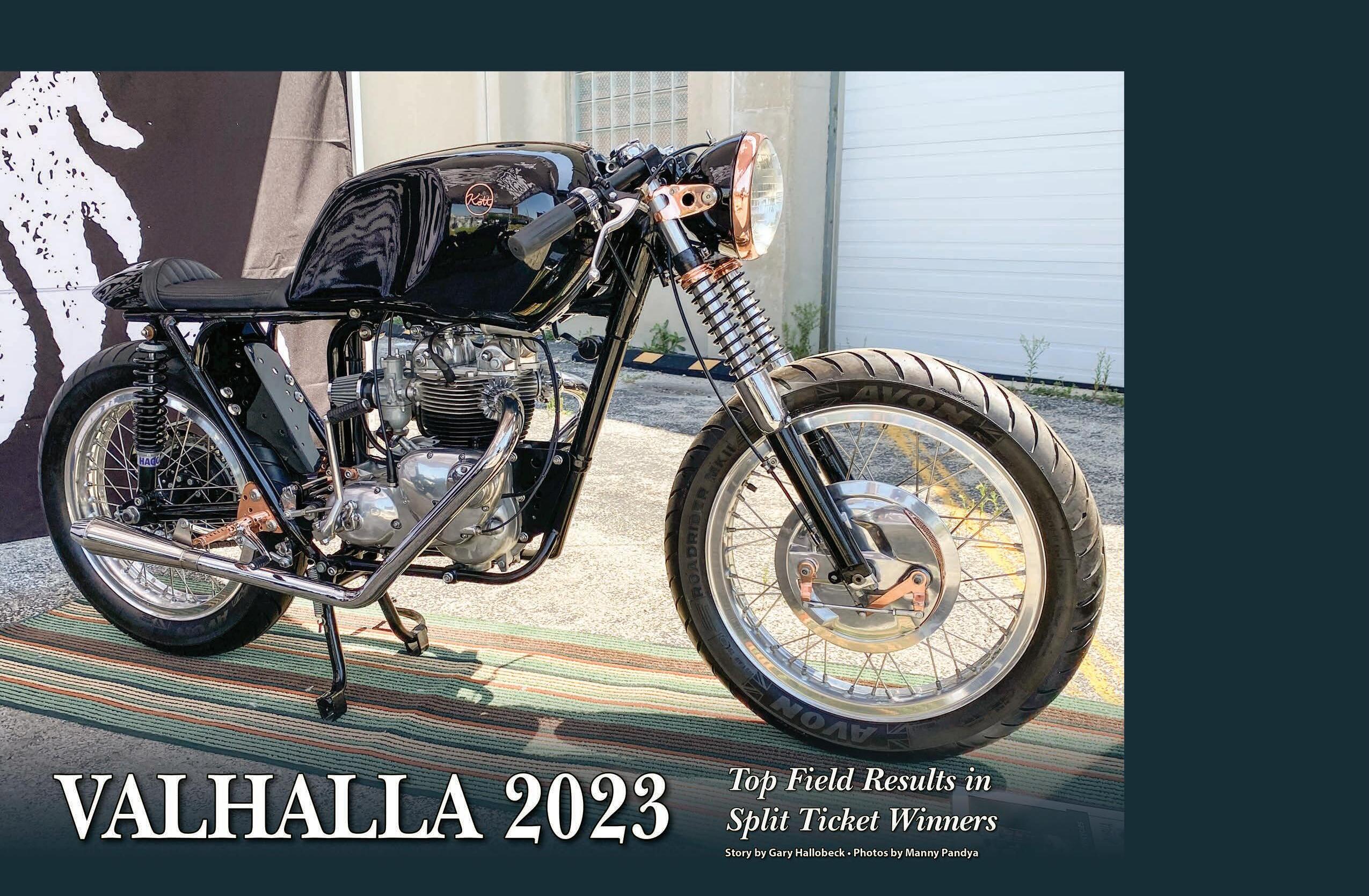 So Cal’s Dustin Kott won third place for his 1971 Triumph Daytona 650 cafe racer. Hidden oil bag and sculpted bodywork did the trick.
So Cal’s Dustin Kott won third place for his 1971 Triumph Daytona 650 cafe racer. Hidden oil bag and sculpted bodywork did the trick.
During late June’s annual Motoblot street festival in Chicago, something unexpected happened. When it came time to announce the grand prize winner of this year’s Valhalla Custom Builder’s Showcase, the judges awarded the $10,000 cash prize to not just one motorcycle builder but three equally talented co-winners. The field of handbuilt rides was so choice that show organizer and trophy presenter (and onstage emcee, and social media promoter, among other things) Kevin Dunworth said the trio of judges had a tough weekend forging a final decision on who had the best wheels.

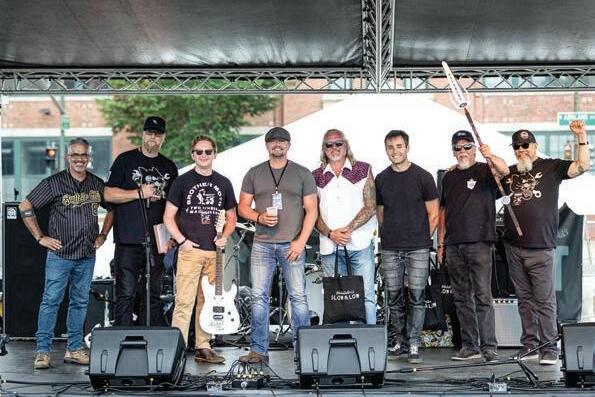

Larry Curik of Texas’ Lone Star Choppers was ahead in the points before Old Man Fate caught up with him. Turns out his the coils on his orange metalflake Harley-Davidson Shovelhead street tracker crapped out during the event’s street ride segment on Sunday afternoon. Valhalla judges the bikes not just on their looks and mechanical details but on the road-worthiness. The electrical problems automatically disqualified Curik from taking the fist-full of prize money, but as a consolation prize, he was awarded the Odin’s Gunjr spear trophy.
“It wasn’t really a disqualification but a crazy story,” Dunworth said. “We have three phase judging and one sheet is for paint, one for design and one for fabrication and then all three judges fill out all three sheets so we’re looking at the overall design.,” he said. “In order to be in the top three places, we have a shakedown ride and it’s six miles in crazy, bumper-to-bumper Chicago traffic. The first place bike broke down three blocks from the finish and he was already ahead by 60 points. For the first time ever, we had a complete tie between second and third place bikes. When Larry’s bike didn’t complete the ride, he even tried to push it to the finish line and tried to start it for 45 minutes. The poor guy was very upset and was ex-
After breakdowns, sweltering weather and much deliberation, the 2023 Valhalla winners received their due respect. Chicago hasn’t seen this much talent on one stage since Muddy and The Wolf gigged together.
Custom Scene



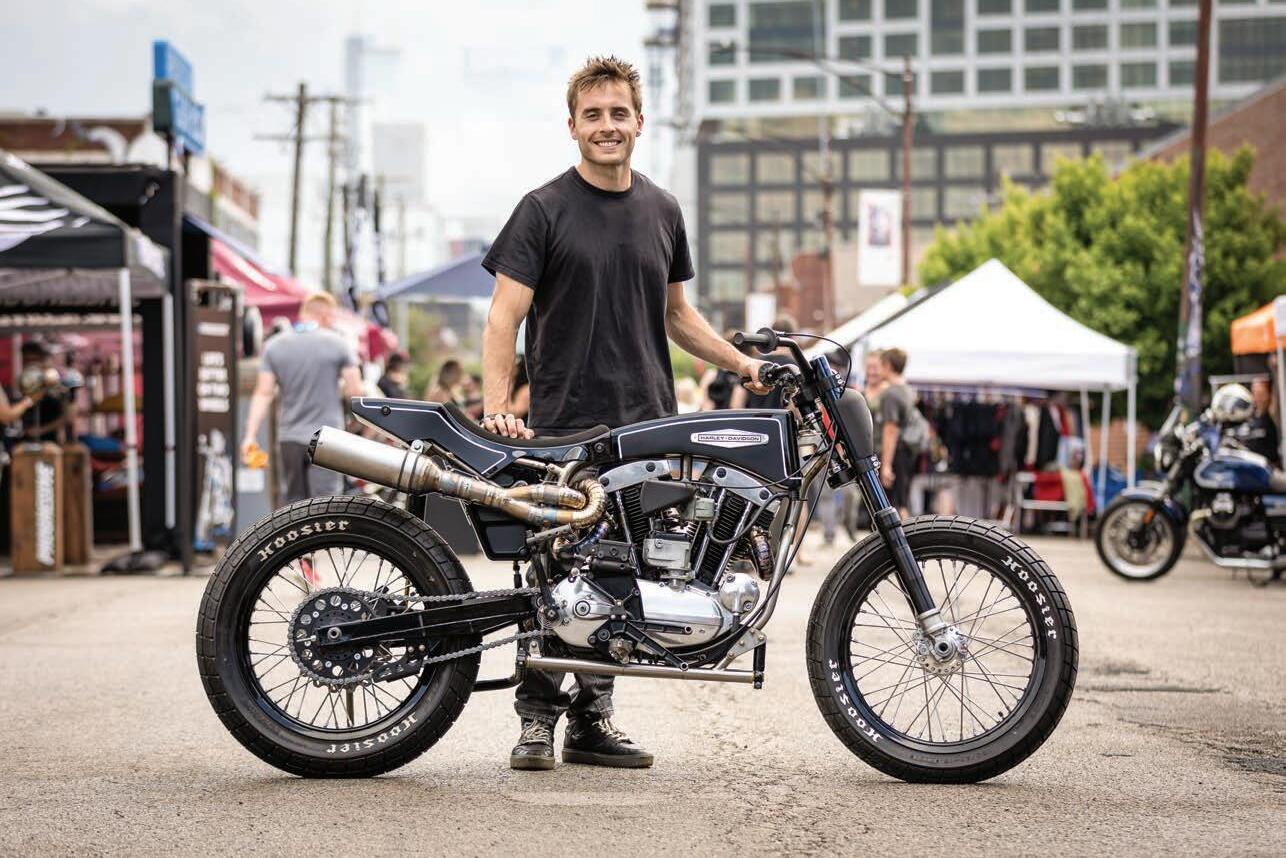 Co-winner of the first place prize at Valhalla 2023 was this crazy vintage street tracker from Tully Co,. Featuring torsion bar rear suspension and a 1960 Ironhead Sportster engine.
Bad luck ended Larry Curik’s dreams of claiming $10,000 when his Shovelhead tracker blew a coil during the test ride. He still won a Viking spear to take home.
Co-winner of the first place prize at Valhalla 2023 was this crazy vintage street tracker from Tully Co,. Featuring torsion bar rear suspension and a 1960 Ironhead Sportster engine.
Bad luck ended Larry Curik’s dreams of claiming $10,000 when his Shovelhead tracker blew a coil during the test ride. He still won a Viking spear to take home.
went ahead and declared a tie and split the prize money between first, second and third place winners,” he said.

Dunworth said the decision was a tough one for the judges because everybody felt bad for Larry but “Valhalla is a live show and you can’t plan this stuff,” he said.
For the second year running, the bike builders invited to Valhalla brought along a mix of choppers, bobbers, trackers and cafe racers. First-time invitee Del Battle of Dangerous Dezigns broke the mold with a fresh take on a 1978 Honda GL1000 Gold Wing in cafe racer trim and West Coast legend Dustin Kott was a crowd favorite for the 1971 Triumph Daytona cafe racer he towed all the way from his Newhall, California shop in the bed of his antique pick-up truck. Talk about dedication.
Kott ended up being handed a pretty cool award for his cross-country travels: $500 in cash. The slick black British 650 had been
left-hand shift and an oil tank tucked out of view and mounted under the Kott original gas tank. The DQ for Curik’s street tracker meant an awkward round of head-scratching for the judges who finally decided to give around half the pay packet to Rick Dozer for his wicked-cool Harley Panhead that he calls “Sex On Wheels.” The rigid chopper had some crazy fabbed parts like a gas tank installed in the rear fender and the overall detailing was appreciated by everyone who saw it, even if you don’t dig choppers at all.
The other big winner who split the prize pot was Kully Millage, a custom bike wizard who also dabbles in real estate investment in his spare time. When he’s not flipping houses, Millage has time to crank out custom motorcycles like a wild take on a classic street tracker built from the old bones of a 1960 XLCH Harley Sportster. A busy dude for sure, Kully has a background in flattrack racing and manu-

company Kully Co.
He claimed $4,750 for his crazy tracker, which is so stripped down, it runs torsionbar rear suspension, magneto ignition and doesn’t even run a front brake.
Other stand-out machines hailed from relative unknown builder Marvin Black from Chicago who had worked up a new take on one of Honda’s underappreciated DOHC CB750 Fours. Slammed and lowered like a pro-stock dragbike, the Black Custom Cycles entry was stealthed out in an allblack finish and ribbed classic-pattern tires. Ben Schattschneider from Neverending Cycles who also made a good showing for his shop’s 1975 SOHC CB750 cafe racer custom done up with superbike forks and radial brakes and a bitchin’ hand-welded custom exhaust.
Look for full features on several Valhalla customs in upcoming issues. CR
Cafe Racer • AUGUST/SEPTEMBER 2023 75
Black Custom Cycles owner Marvin Black dropped this sultry, stealthed-out 1978 CB750 Honda street dragger.
STAFF RIDES
Blair Powell’s Royal Enfield Continental GT 650

A WORLD OF UPGRADES: PART 1
 Blair still trying to get his head around the ease and fun of owning a modern, reliable motorcycle.
Blair still trying to get his head around the ease and fun of owning a modern, reliable motorcycle.
The powers that be at Cafe Racer Worldwide HQ asked me to give my thoughts on my ‘19 Royal Enfield Continental now that I’ve been riding it for a couple years. As soon as I got the GT it became my main ride. My previous main ride died earlier that summer, and none of my projects were close to getting on the road. This was the first new vehicle I’ve ever owned, and I gotta say having a reliable ride is a luxury I can get used to.
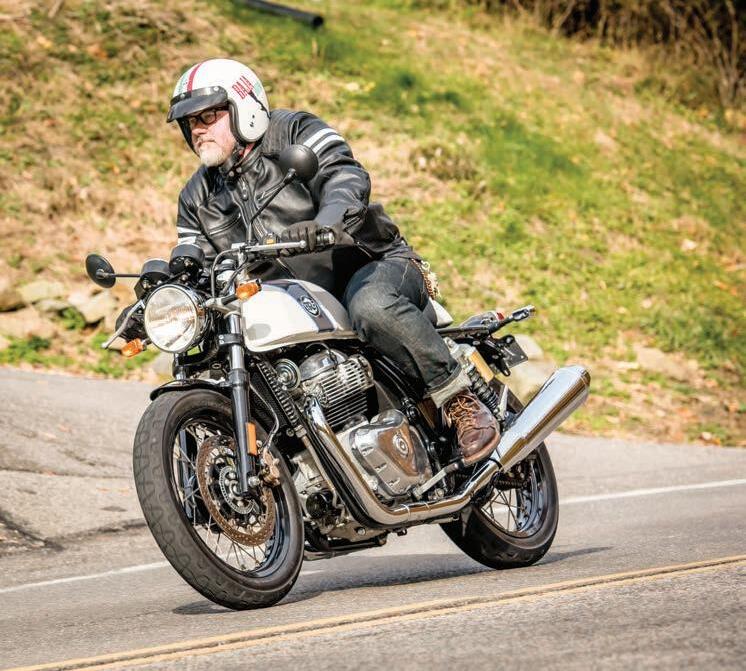

No bike is ever 100% reliable, but there’ve only been a few repairs needed. Shortly after getting the bike, the front brake switch stopped working, but it was just a loose connection in the headlight. The speedometer drive failed, and the “push” throttle cable broke – neither of those were a difficult repair. There was a recall to replace the brake calipers and the brakes were really squeaky afterwards, but a dab of disk brake grease on the back of the pads fixed that right up.


I did a few mild performance upgrades as well. I replaced the stock air filter with a K&N filter, and got a filter cover plate eliminator for extra flow. DNA and S&S both make them, but I got mine from Caffeine Racer on eBay. I put in new Iridium plugs, a set of less restrictive mufflers, and replaced the chain and tires. The stock chain kept getting surface rust when it got wet, and riding in Western PA. you see a lot of rain, so I got a new DID X-ring chain (size 525 x 100, in case you’re curious –both the user manual and the shop manual just say ‘5/8 link’ for chain size). The stock tires are Pirellis, but they never quite felt right. When they got worn, I replaced them with Pirelli Sport Demon tires, and I love them. They feel so much better and stickier in the corners.
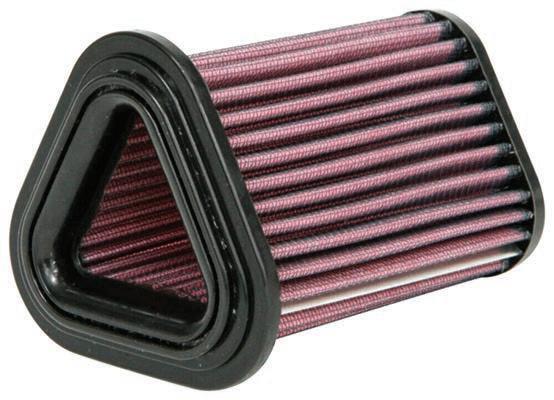
I’ve done a bunch of cosmetic upgrades too. I took the plastic fender extensions off the bike the second I got it home, put on a solo seat (the two-up seat was the only option available when I got it) and replaced the giant stock mirrors with bar-end mirrors. Like everyone else, I’ve used many sets of the cheapie, $20 per-pair eBay bar-end mirrors, but this time I decided to treat myself and get some CRG Hindsight mirrors. They were a bit pricey at around $189 per pair, but they’re great. I fold in the mirrors a lot to navigate parking in the city, and once you get the mirrors set up right they fold in and out without needing to be re-adjusted. At first I ordered the Blindsight mirrors, but felt they were too small for a daily rider, so I returned the 2” Blindsights for the 3”
a very difficult install; there’s even an auxiliary power plug inside the headlight. I just had to order a matching electrical connector. I really dig them, and they have the added advantage of being a little fatter than the stock grips, which I prefer. The heater controls are on the left grip, and the only thing I’d do differently is install them so the heater controls aren’t right next to the turn signal switch – it’s really easy to accidentally turn the heaters on and off when can-
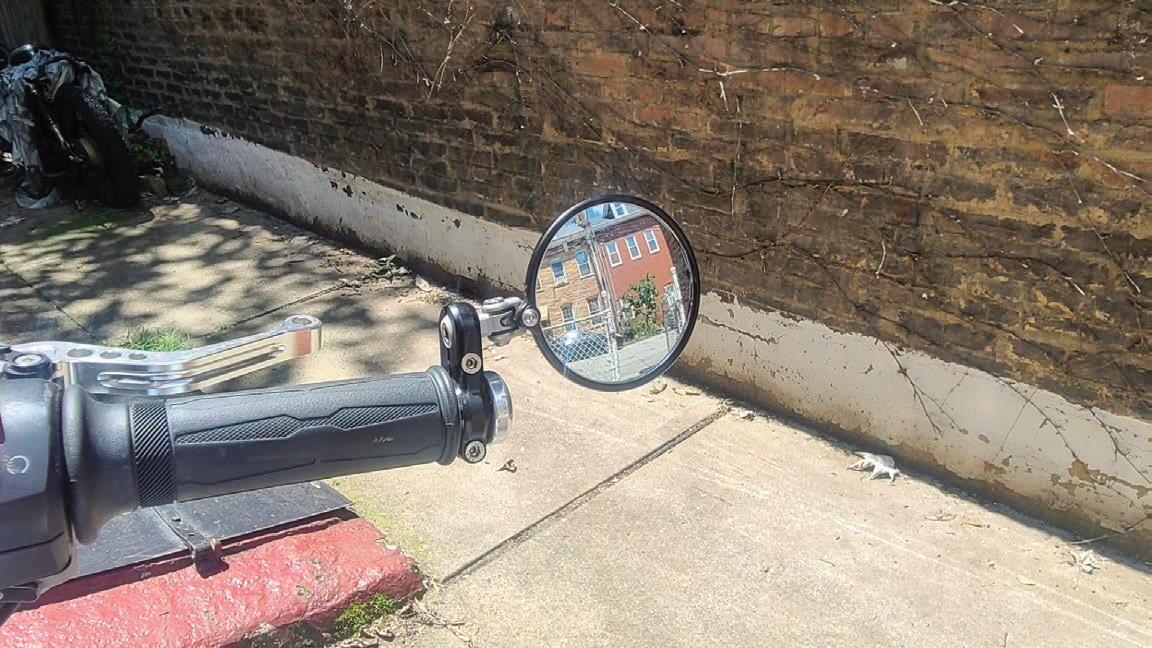
Cafe Racer • AUGUST/SEPTEMBER 2023 77
custom parts coming soon. CR
Blair added a set of Apollo heated grips and sturdy, CRG 3" bar-end mirrors; The grips are for all-weather riding and the mirrors both work and look good.
Royal Enfield's Continental GT 650 is a sharp-looker out of the crate, but it responds well to upgrades.
Freer-flowing K&N air filter along with a set of VooDoo mufflers means Blair's Continental GT picked up at least 5 additional horsepower.
CR Tech honda cb450 project
Spare Us the Cutesy
Story and Photos by Paul D. Stanstead
When customizing or restoring motorbikes, I hate cutesy concepts. Whether we’re sanding down a piece of oak to make a com pletely impractical seat or powdercoating a set of rims to match a
Case in point: the fuel system on the 1972 Honda CB450 that’s long been a part of the CRM garage fleet. When working on the initial construction of the DOHC twin a few years back, we entrusted some of the final detailing to our friends at what was then West Hills Honda. Their techs did a great job of wiring the CB which hadn’t had an elec-
grown brittle and yellowed. While attempting to remove the fuel lines for closer inspection, the plastic connector snapped as easily as a pub pretzel. Likewise, the tiny, (and yes, very cute) plastic fuel filter they’d fitted also gave up the ghost while unscrewing the hose clamps keeping it in place.
This is as ill-advised as using Hello Kitty bandages to stop an oil leak.
From years spent fettling motorcycles, I’ve learned the hard way that the only fuel lines worth their cost are the 7.5mm thick, ¼ inch diameter black rubber lines installed by OEM factories. This stuff is available for $7.95 per foot from Speed Moto Co. And while it may not match the color of your girlfriend’s eyes or coordinate with the laces in your Chuck Taylor high-tops, it will remain flexible for years, is split and crack resistant and gets the bloody job done.

And that’s what you want when dealing with your motorcycle’s fuel system, correct?
The plastic T-junctions are also a big no-no in my very weathered book. It was promptly replaced with a far more sensible brass unit that costs just $17.99 (also from Speed Moto Co.) and does the job with no complaints. We’ll be using these bits to refurbish the CB450’s fuel system before moving on with the project. Which will be

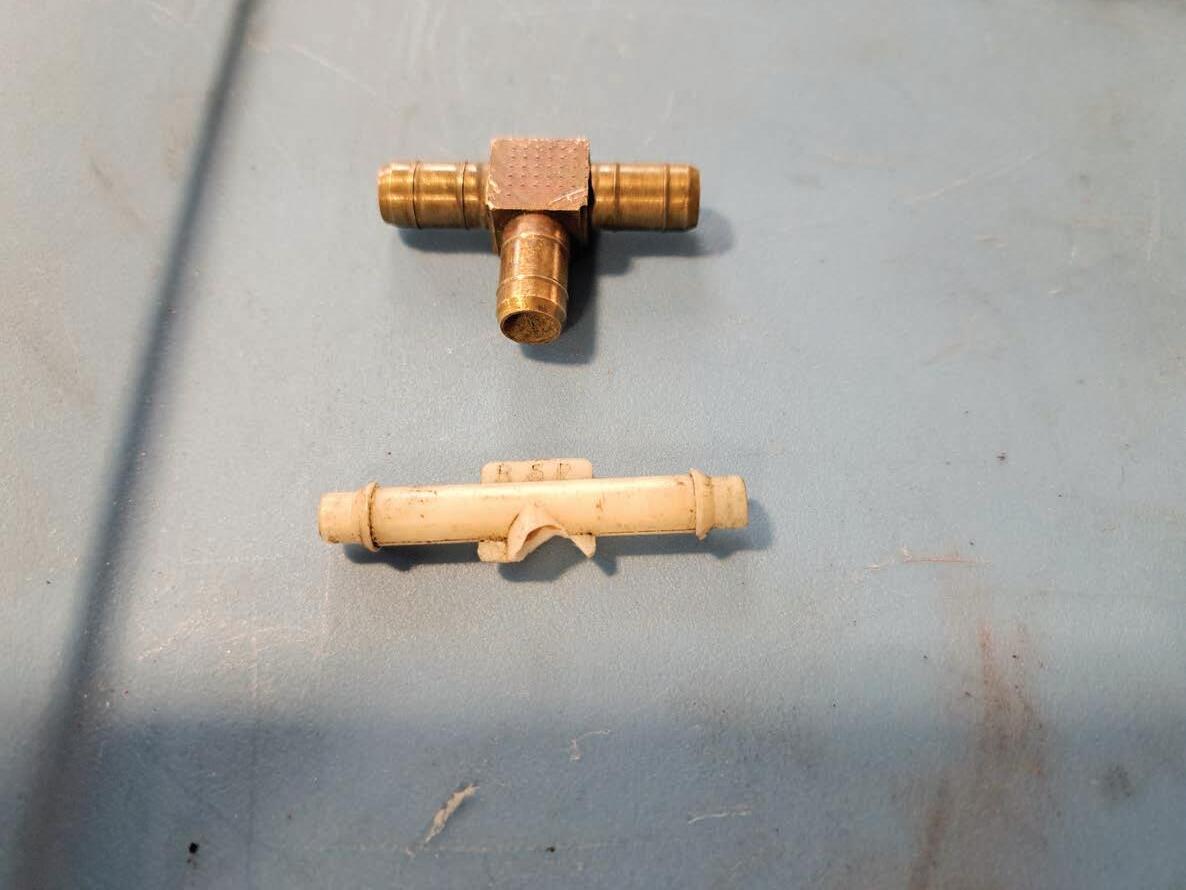 The brass fuel line junction at top will far outlast the spindly plastic version below. Believe us.
The grey/silver fuel line matches the Honda’s paint, but after four years is brittle and starting to crack. Make ours black, please.
Cutesy plastic fuel filter snapped like a Maryland crab leg.
The brass fuel line junction at top will far outlast the spindly plastic version below. Believe us.
The grey/silver fuel line matches the Honda’s paint, but after four years is brittle and starting to crack. Make ours black, please.
Cutesy plastic fuel filter snapped like a Maryland crab leg.


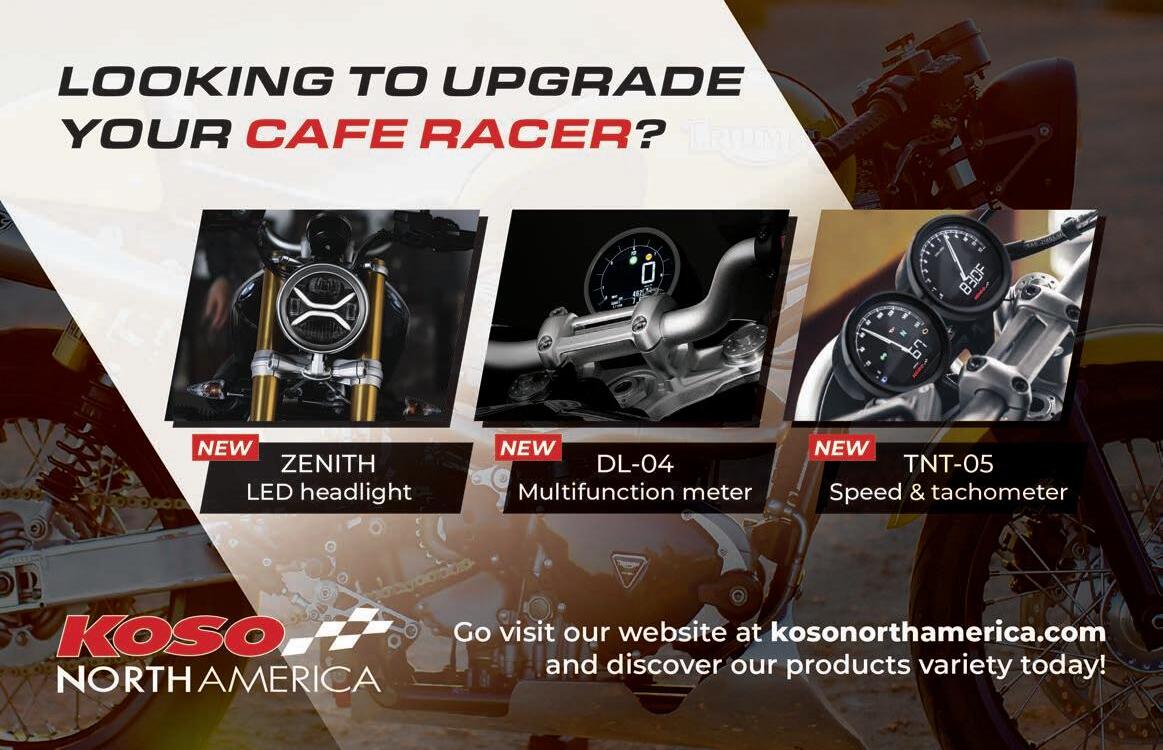
Top Tips For Classic Bike Owners
Story by Mike Seate • Photos CRM Archive

Vintage motorcycle builder Tony Urbanek called us recently, after having been presented with a $5,100 bill to get his “cherry” 1965 Triumph Bonneville 650 back on the road. When Urbanek purchased it, the classic motorcycle had been sitting, unused, in a basement, last ridden in the late 1970s. The owner told Urbanek, as folks in possession of vintage motorcycles often do, that the bike
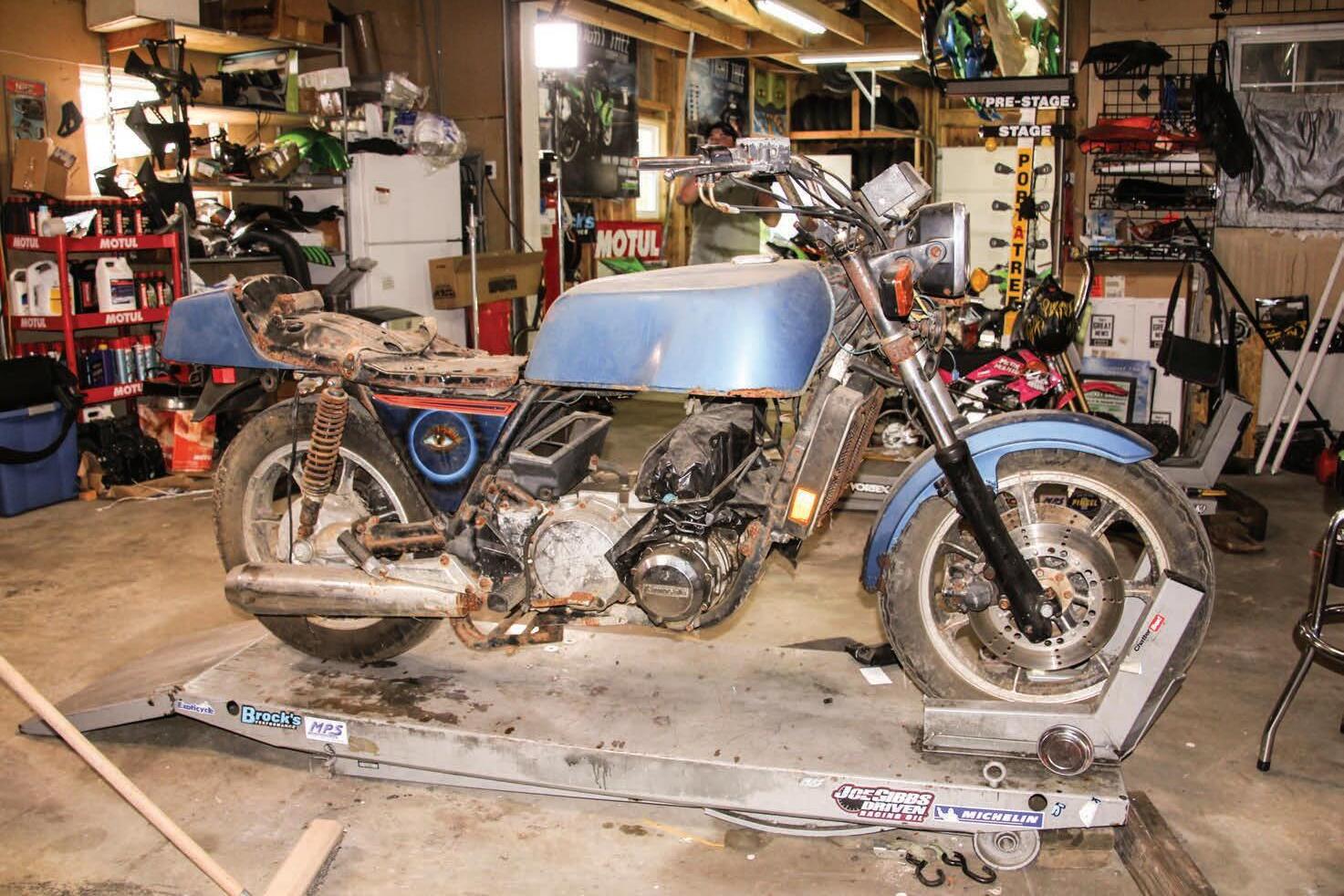
gas will solve everything. Not so, say CRM staffers who are frequently confronted with requests from owners of long-dormant classic bikes to get theirs up and running. Treat a classic bike like a tennis racket or other piece of sporting goods, that is, throw it into a corner of the garage and let it sit for five or ten years, and it will be just about as useful on the road as a tennis racket,” says veteran British bike restorer, Steve Collins, of PA’s Collins Cycle.
sludge and carburetors – particularly Amals and other pre-ethanol fuel atomizers – will become permanently damaged from stagnant petrol.

Here’s a list of our top ten tips when buying a long-idled bike:
Overall Condition: Make an honest assessment of the machine’s condition. Rusty spokes? That means wheels will need replaced or re-laced. Engine won’t turn over?
CR Tech
A long-abandoned motorcycle may look promising, but there's a process to setting things straight.
gas and clean the tank and have it checked for leaks and internal rust. Replace if necessary.
Carburetors: If they haven’t been properly drained, replace or at least professionally clean the existing carbs. Amal carburetors built before 2019 will need ethanol-free floats to work properly on modern petrol.

Brake, oil and fuel lines: These can become brittle and prone to leaks in time, so the re-commissioning of any long-dormant machine will mean inspecting and possibly replacing rubber hoses. Sure, it’s a pain, but so is a fuel leak oil oil tank drain at high speed.
Fresh Tires: Owners of long-dormant motorcycles tend to falsely believe that tires last forever. They don’t. After about eight years, they’ll need replaced. If the sidewalls show any signs of cracking, off they must go.

 After a few years, tires will begin to dry rot making them unsuitable for road use.
Many believe a bike like this will run with fresh gas in the tank. It won’t.
After a few years, tires will begin to dry rot making them unsuitable for road use.
Many believe a bike like this will run with fresh gas in the tank. It won’t.
CR Tech
No Compression? Pulling the engine’s head is the best way to determine if the pistons and/or rings have sealed to the cylinder walls. Check for rust, evidence of rodent infestation (yes, this can happen) and other foreign objects.
Brakes: The pistons inside hydraulic brake calipers will very likely have rusted or seized requiring a complete rebuild or, at worst, replacement. How does the brake fluid in the reservoir(s) smell? If it’s fishy, it will need flushed and replaced at the least.
Electrics: Replace the battery with a modern, sealed unit. Mice or rats may have chosen your bike’s wiring as a favorite late night
Final Drive Chain: A rusty chain can be soaked in oil, but the better choice is to buy a new one. Check the condition of teeth on both sprockets. If your rusty relic is shaftdriven, drain the fluid and replace, checking all seals and gaskets.
Suspension: Fork oil breaks down as does the hydraulic fluid in shocks. Inspect and replace if either end of the bike doesn’t spring back into position when compressed. Replace any leaking fork seals and check steering head bearings.


Want to Avoid All This? Here’s How: Ride Your Classic Bike Often
trical system and prevents oil from wetsumping into the crankcases which helps keep your machine humming.
Do


Some Prep Work
If storing your classic for several weeks or months, be sure to connect a trickle charger to your battery. Drip a small amount of oil into the cylinder bores if planning a longer dormant period, and kick the bike over every week or so.
Get Elevated: Getting both wheels and tires off the ground with a centerstand (or aftermarket prop stand) prevents flat spots and irregular tread wear.
Grease Is Your Pal: Cold or damp storage area? Rust never sleeps as the song says, so try coating all exposed surfaces in a light oil like WD40.

Consider Selling: There are countless classics stored in sheds and barns that owners fool themselves into thinking they will someday ride again. If you have young kids and are waiting until they’re out of college and married off before you plan to ride gain, seriously consider selling the bike. You can always buy a replacement later. CR

82 www.caferacermag.com
A motorcycle stored in damp conditions or outdoors may be hiding an engine that looks like this on the inside.
Unearthed a genuine barn find classic bike? Getting it back on the road is not as simple as you may think
These rusty spokes will need replaced and the rim refinished. Restoring bikes is never cheap.



Gauging The Speed
It took some careful persuading to convince Nick to help mount and wire a new GPS speedometer on the Fat Featherbed Triton. The esteemed Mr. Coumos’s talents lie in mid-century British bikes which ran basic, gear- driven instruments. The current


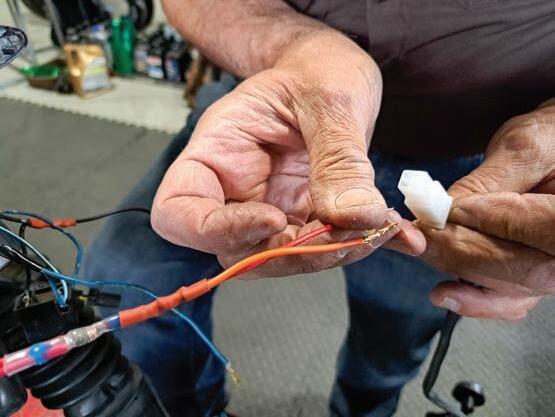
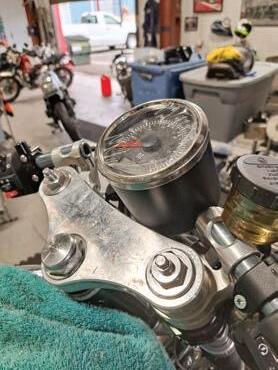

generation of digital age motorcycle gauges, however, are a whole different bag of sensors. Equipped with multi-function displays and capable of gathering all manner of information, the mounting and wiring of such has driven the best mechanics to violent tantrums.


CR Tech
FAT FEATHERBED MODERN TRITON
Nick fishes out the wiring to run the speedometer’s function lights from the headlight shell.
When Nick promised to bring a stripper to the garage this isn’t what I had in mind.
The wires needed extended and small copper tabs soldered onto each before they could be joined together.
84 www.caferacermag.com
The GPS speedo bolted firmly in place to the underside of the Cognito Moto top triple clamp.
Each wire is placed in the white connector block with the speedometer’s color-coordinated wires run into the other half of the block.
A quick snap and they’re connected. This antenna helps power the speedo’s calibration by locking onto a satellite signal.
Story and Photos by Mike Seate and Nick Coumos
To Nick’s credit, he was willing to give the job a try.
“How complicated can it be?” he asked rhetorically. “If it gathers its speed calibration from a satellite, we just need to make sure its electrically sound. We have a soldering gun, lengths of wire and an instruction sheet so let’s do it.” he gamely proclaimed.
The unit is top-shelf as far as GPS speedometers go. We picked ours up from Oregon’s Speed Moto Co and the 5” Max Concepts gauge ($159) included the aforementioned MPH/KPH speedometer, plus a high beam indicator light, turn signal monitors and a nice orange backlight. A sturdy 1/8” powdercoated steel mounting bracket would make attaching the gauge to the Cognito Moto alloy triple clamps a breeze. A small square antenna is connected to the unit via wire and requires mounting somewhere on the motorcycle where it can pick up signals from the satellite.
Lucky for us, the one-sheet instructions (included) detailed seven multicolored wires protruding from the gauge’s back side, each of which connected a single function to the Triumph wiring harness.
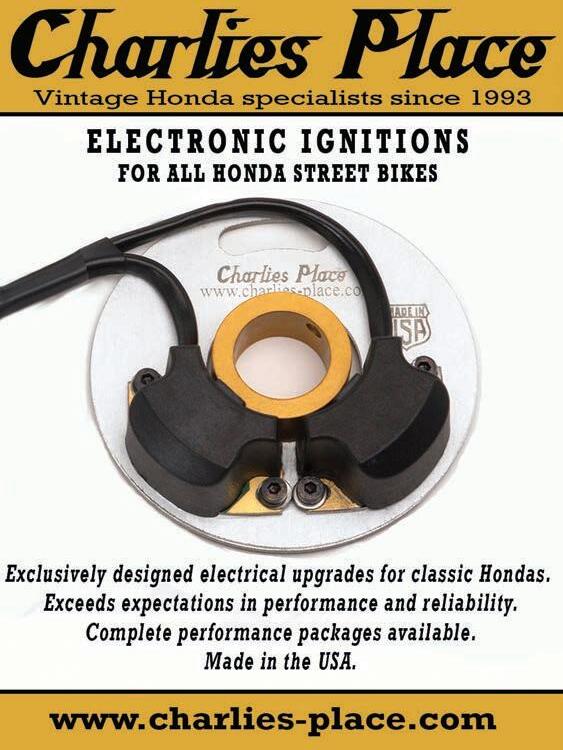
Most of the coordinating wires were stuffed inside the Speed Moto Co. headlight shell, which Nick quickly fished out to examine. A lifetime of wiring the relatively primitive electrics on countless Nortons lent Nick an insight into the task, which he quickly sorted by stripping away the insulation on each end of the wires.
“This seems really complex and intimidating if you haven’t done wiring before, but it’s actually one of the easiest jobs on any motorcycle,“ he said with the studied calm of a Zen master. Having soldered extra length onto each of the seven wires, the time came to connect them.
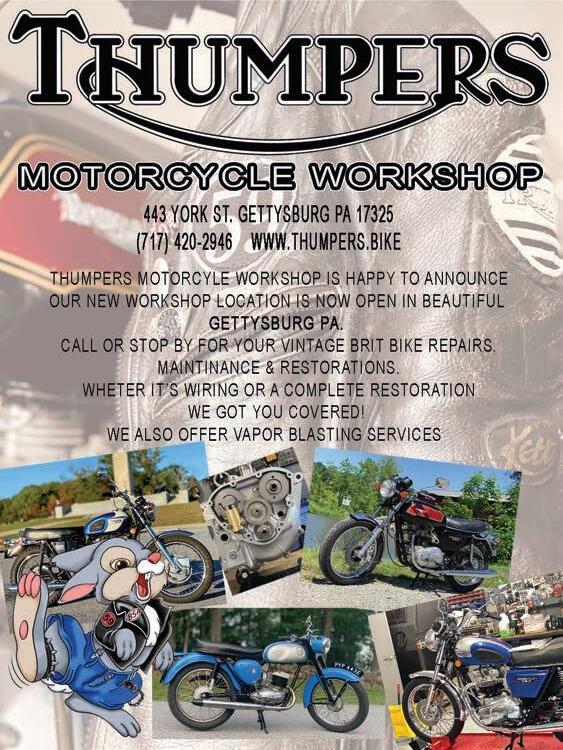
Due the large number of wires to be connected, Nick had brought along a box of plastic connector blocks. These handy do-it-all connectors simplify wiring by allowing several wires to be joined at once. A box of several dozen in two-to-five wire configurations sells for just $19.99 at most hardware stores and they make the job as simple as inserting the ends of each wire into the coordinating spot on the block and snapping the two halves together.
While Nick was busy with wiring, I pulled the top triple clamp and lined up a hole for the speedometer’s mounting arm. We lucked out again as the Cognito team had pre-drilled and tapped a pair of 6mm holes in the clamp’s underside. This made mounting the arm as simple as drilling a hole to position the gauge in our line of sight, and bolting it in.
“You get the not-so-fun job of stuffing all the wires back inside the headlight shell,” Nick laughed once his wiring handiwork was complete. We temporarily mounted the GPS antenna to the frame just below the steering head, a position we hope will make picking up a signal easy-peasy. Next comes a shakedown run to see how well all these recent fixes and mods work together. The Fat Featherbed Triton hasn’t run in several weeks, since we discovered a leak in the fuel tank that’s since been welded shut. Hang in there until next issue. CR
Resources:
www.speedmotoco.com • www.cognitomoto.com
Moto Guzzi V9 Bobber Sport Damn the Rear Dampers
Story and Photos by Paul D. Stanstead
How do you know when you’re getting old as a motorcyclist? For me there are many reminders of my advancing tally of years, but few have proven as consistent as recurring riding pains. You know, the sort of annoying discomforts that weren’t noticeable a few years back, but suddenly make most rides an advert for over-the-counter pain relievers.
It’s easiest to blame said discomforts on whatever motorcycle I happen to be riding, but as of late, I’ve no one else to blame than Moto Guzzi’s otherwise brilliant V9 Bobber Sport.
The transverse V-twin has been a corker of a ride, especially after Italian bike expert Jeremy Haynes remapped the fuel injection program and So Cal’s GT Motorcycles reflashed the ECU. This made the shaft-driven factory bobber more responsive and downright quicker, as did lowering the forks in
head angle. The only soft spot remaining were the Ohlins twin rear shocks which seemed to place a bullseye on my lower back muscles.
I don’t blame Moto Guzzi as much as I do prevailing trends in the motorcycle industry. The V9 Bobber was designed to compete in a very lucrative retro bobber market, one occupied by rapid sellers including Harley-Davidson’s Sportsters, Indian’s Scout and Triumph’s all-conquering Bonneville Bobber. These bikes take existing engine platforms bolted into frames with lower-than-usual rear shocks. The visual effects are popular, but the shortened shocks prove fairly compromised on the road.
Each time I approached uneven pavement on the V9, I winced in anticipation of the juddering jolt that awaited my lower lumbar region. This was totally unexpected as the dual gas-charged Ohlins shocks are considered industry leading. But being a full 3” shorter than the dampers installed on Moto Guzzi’s V7 (which utilizes an identical chassis) the suspension travel just wasn’t up to the job.
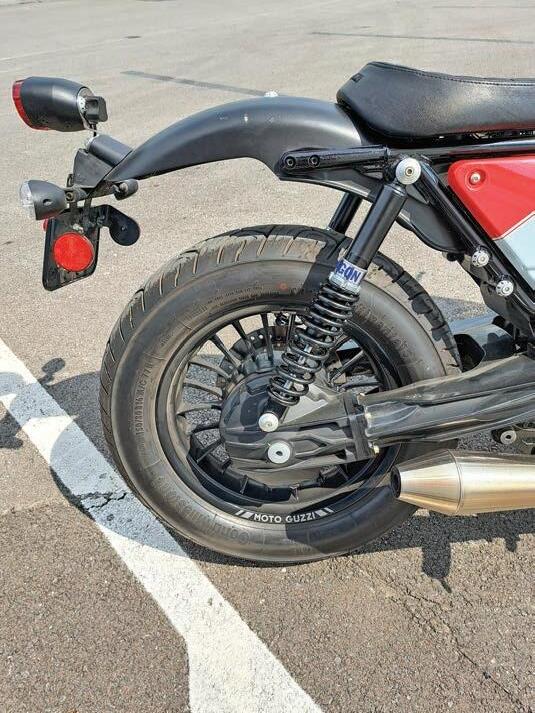
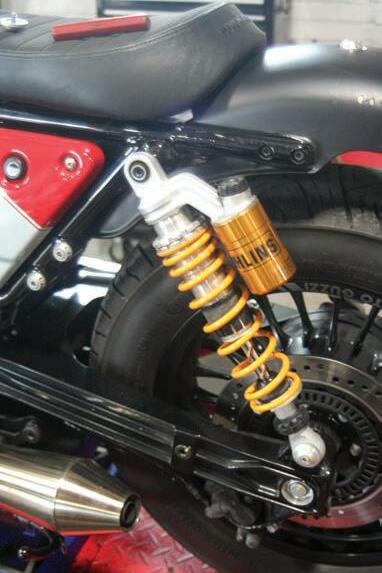
A quick call to Hagon
Shocks in Merry Olde England had a set of fulllength shocks on the way in just over a week. The good folks at Hagon supplied us with a pair of their three-way preload-adjustable 2820 Series shocks that feature circuit compression/rebound damping adjustment via a handy 4mm allen key, included in the package.
Built on black dampers and fitted with a choice of black springs, these 15” tall dampers sell for just $280.62. Chrome versions are just a few bucks more.
We rolled the pavement-hugging Guzzi onto the workstand and quickly jacked up the rear end with our handy flat jack. In moments the shorties were gone, the Hagons bolted into place. The extra length required raising the chassis high enough on the stand to drop the rear swingarm a couple of inches, but that was about it.
Wheels back on the ground, the V9 suddenly adopted a taller, more purposeful stance. The distance between the rear fender and the 16” back tire was now large enough to fit my stack of chiropractor’s bills into. For once, the front end of the Guzzi and the rear appeared to rest on equal footing, meaning the motorcycle should turn faster and offer improved ground clearance.
Next issue, one of us will take a test ride aboard the newly suspendered Italian, which should prove a revelation to say the least. Kidney belts be damned!. CR
CR Tech
Ohlins rear shocks are excellent, but shortened “Bobber” length can be a problem.
www.hagonshocksus.com
These Hagon dampers are 3” longer than stock and offer preload adjustment and made-toorder sporing rates. Who needs kidney belts?
Resource:

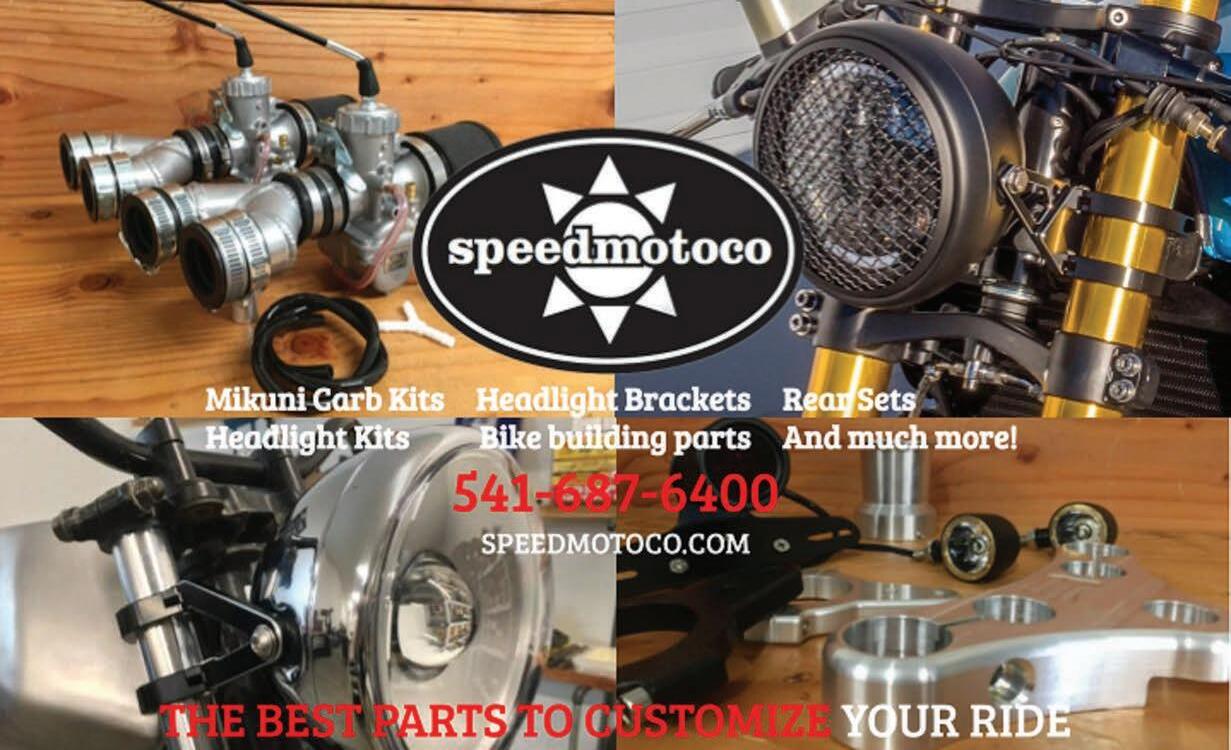
Combination Commando Drawn Back to the Dommie


Asthe owner of dozens of motorcycles over the past 44 years, I’ve followed one standard rule for them all: don’t get hung up. If circumstances force the sale of a bike I was just starting to vibe with, off it goes with no regrets. I’ve always figured there are too many motorcycles I’m still curious about owning and/or building to get all possessive and sentimental about a single machine.
Friends thought I’d lost my way after selling a 2000 Bimota SB8R superbike that I’d long longed for. But in reality, the high-strung Italian race-replica was painful to ride at anything short of ten tenths, and Bimota’s chronic financial problems made parts backup even more of a nightmare than turning the finicky $30,000 bike around in a parking lot.
Likewise, when a major injury to my kickstart foot caused the sell-off of my 1959 Norton Dominator in 2020, I’d learned by then to look forward, not back. Old Nortons aren’t exactly rare and the CRM team was already busy restoring and customizing two more Norton twins as the Dommie went bye-bye.
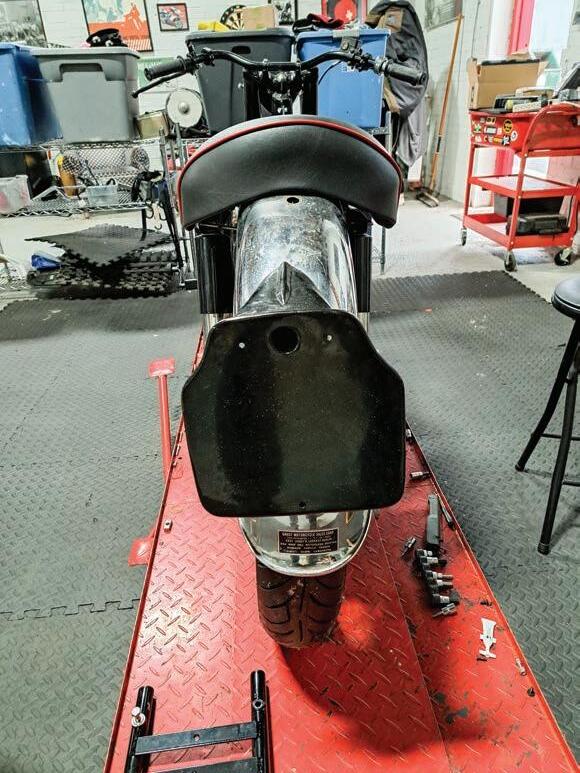
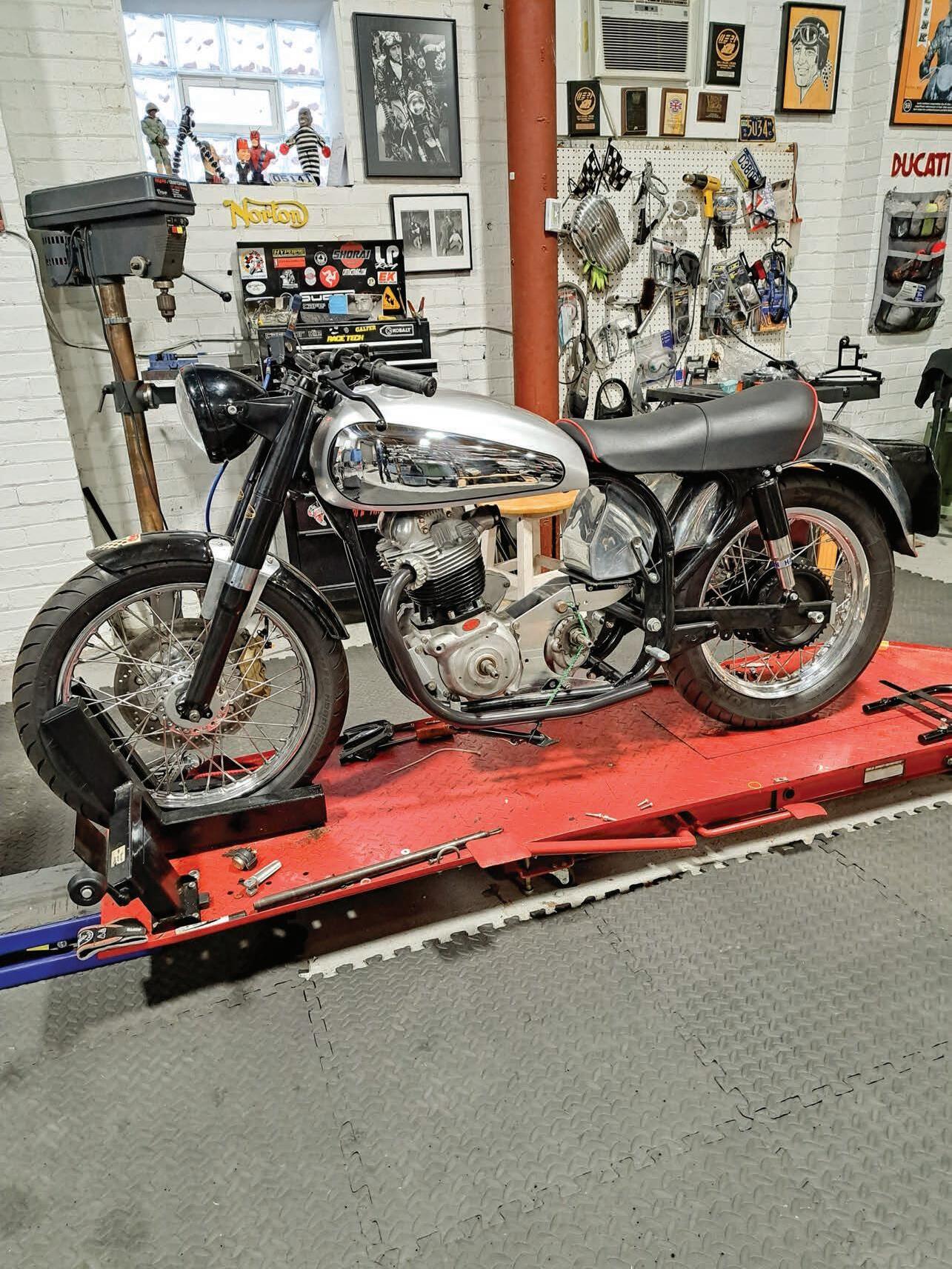 Story by Mike Seate • Photos by Mike Seate and Kim Love
Story by Mike Seate • Photos by Mike Seate and Kim Love
CR
Tech
bugs me.

Maybe it’s because I picked up the basket case 600 for the ridiculous sum of $600. And once Nick Coumos and the crew at Collins Cycle had restored it, the mid-century Norton proved as beautiful, capable and downright fun as any bike I’d ever ridden, new or old. Even Nick, who had owned a 600 Dominator himself back in the 1960s was wowed by the Wideline featherbed’s precise handling and the unexpected pull of the parallel twin engine.
Plus, you’ve got to admit she was quite a looker. That long, low sculpted steel gas tank flowed perfectly into the vast, skirted fenders and the overall package was as graceful as any Jaguar coupe or Spitfire Mk.II ever to capture the British fancy.
Meanwhile, as we toiled away building the bike known as the Combination Commando, which is comprised of a 1967 Nor-


ton Atlas engine’s top end and a 1974 Commando bottom end, it occurred to me that this bike could, indeed, make a suitable replacement for the much-missed Dominator. The impetus for the whole project was to prove a featherbed Norton twin could offer the convenience of electric starting. The only aesthetic difference between this bike and the Dominator was the bodywork.
Yes, this machine is built on the Slimline featherbed chassis, but for those unfamiliar with the intricacies of the British motorcycle industry back in the old days, nearly all of the
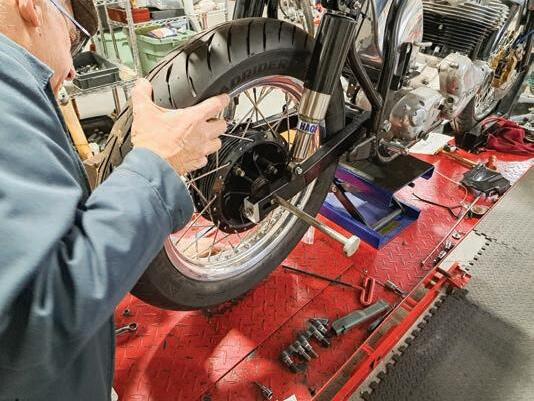

motorcycles built by manufacturers utilized modular design and interchangeable parts.
To prove my point, take a look at the image above: these are Dominator bodywork parts dating back to as early as 1955, bolted to a frame made in 1967. Due to arrogance or a lack of R&D money, everyone from Triumph to BSA to Norton spent most of the 1960s simply mixing and matching components they’d used previously to clever effect. In retrospect, this seems like the business practices of an industry on the brink of collapse. To us, some 60 years later, it makes piecing together the British classic of our dreams a breeze. What Dominator-specific bits we’ll need are on offer from the well-stocked shelves of British Cycle Supply and Classic British Spares, including the fuel tank and seat seen above.
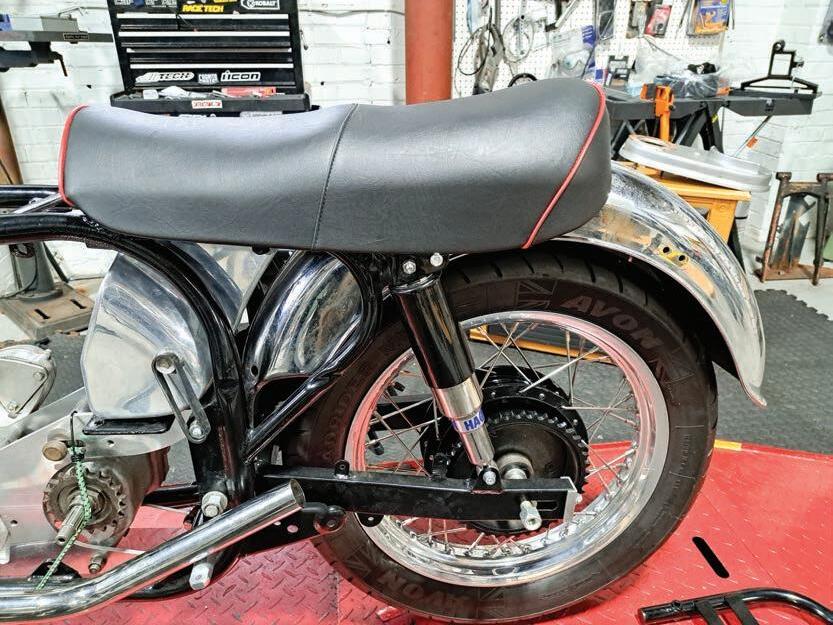
So onwards we’ll proceed with the Combination Commando, only it will emerge not in café racer guise, but as a replica of a 99 Dominator that I hated to let go. This time the twin will be equipped with modern conveniences including push-button starting and a disc front brake front stopper.
Don’t get hung up…unless you can’t help it.

Cafe Racer • AUGUST/SEPTEMBER 2023 89
RESOURCES: www.britishcyclesupply.com • Classicbritishspares.com
Dominator rear fender is an original while the seat is a British Cycle Supply reproduction. Polished center-fill oil tank will have to go as its not very factory Norton.
Indian parts makers serve up just about any classic British bike part including this 1950s taillight holder.
Nick ensures the 130mm rear Avon fits within the Dresda swingarm. Tires are fatter than they used to be!
Hi Matt
My name is Dennis and you helped me with a 1984 Honda V65 Sabre a while back. Since then I’ve added a 1976 Honda GL1000 Gold Wing and I’m looking for replacement carburetor boots. The originals look like they’re in good shape, but the bike idles high and after much research I think it’s a vacuum leak between the carb and cylinder head. Do you have any experience with that? Are there options for fitting new carb boots? As always, thanks for your time and insight.
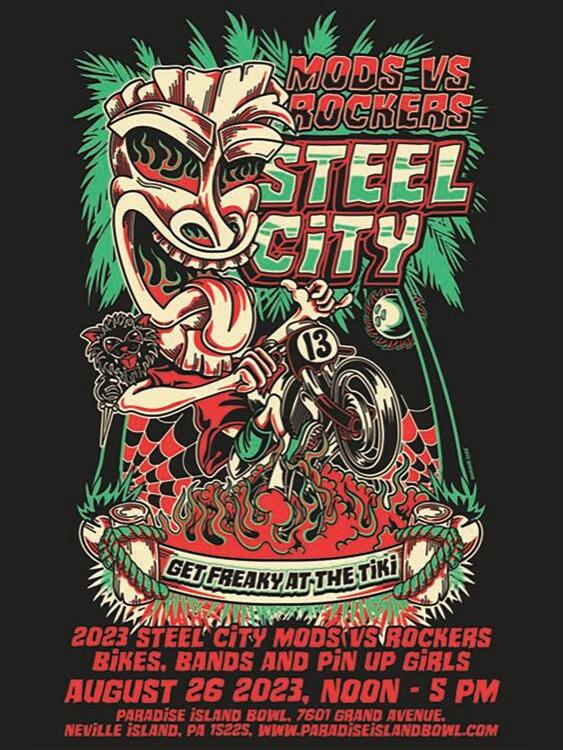
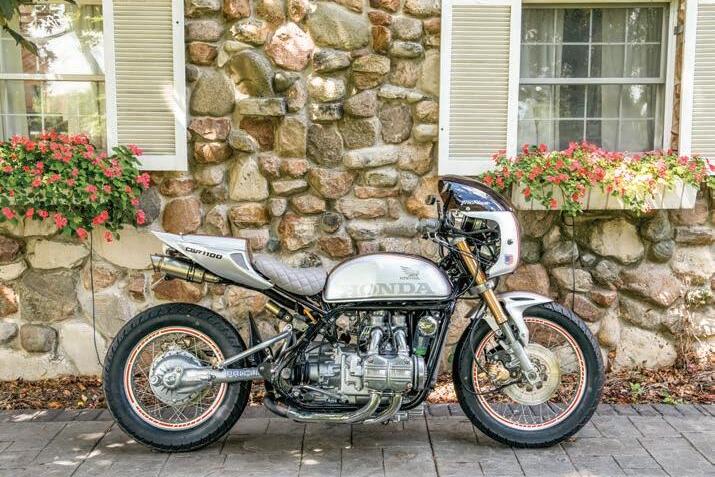
 Dennis
Dennis
Greetings and thanks for checking in with me. I can offer insight, direction and likely save you some time and money chasing this.
With Technical Editor
MATT Wiley
The intake manifolds on GL1000s and GL1200s rarely fail. However, in some cases the rubber at the metal joints will separate or split. The rubber will get hard with age so soaking them with WD40 or silicone spray and warming the boots with a hair dryer or heat gun on a low temperature setting will soften them some. If they’re very hardened there is a recipe on the Internet for rubber repair that involves soaking the boots in a solution of alcohol and wintergreen oil that I’ve been told works.
The air/vacuum leak issue is typically a failure of the O-ring seal between the manifold body at the cylinder head. You can source the OEM Honda O-rings for this or match up from bulk O-rings, or visit your local hardware store. Make sure to clean and dress the sealing surface at both the manifold and cylinder head to make sure the flat surfaces seal properly. Also, the screws for attaching synchronizer fittings on manifolds are prone to leak so replacing both the screws and sealing washers is a good idea. Make sure to check the fuel mixture screw settings. If I recall, three turns out is a good starting point and then fine tune from there.
After these repairs, warm up the engine, then at idle, spray WD40 or carb cleaner at all the junction points. Any change to RPM indicates an air/vacuum leak. Once the air leaks are sealed, check carb synchronization as it may be out if it was previously adjusted when the air/vacuum leaks were present. Installing a new fuel filter is also important for all GL1000 and GL1200 models. Fine tune the fuel mixture screws until the engine has the smoothest, highest idle speed, then re-adjust your bike’s idle as needed.
In the worst case, GL1100 manifolds should work with your GL1000’s carbs or you may want to consider a complete carb swap from the complex GL1000 carbs to better, simpler GL1100 carbs which should be a direct fit. Don’t overlook the ignition timing and upgrading to an electronic ignition and better coils or at very least replacing the 40-year-old plastic plug caps with aftermarket NGK units and trimming the corroded ends of the high tension leads is worthwhile.
Good luck! - Matt Wiley
90 www.caferacermag.com
Dennis-
WORKSHOP FILES
Have a technical issue that needs addressed? Contact Matt directly via motovintagematt@gmail.com

















 By Mark Mederski
By Mark Mederski












 Story by Jay LaRossa and Mike Seate
Photos by Jose Gallina
Story by Jay LaRossa and Mike Seate
Photos by Jose Gallina





































 Mecum’s
Mecum’s




























 The things I changed were these: electronic ignition, a balanced crank, a front brake drum painted black to contrast with the stainless steel spokes on the Akront shouldered rims.” Oddly, the paint isn’t original, but a different shade of red, which appealed to Vincent’s tastes.
The things I changed were these: electronic ignition, a balanced crank, a front brake drum painted black to contrast with the stainless steel spokes on the Akront shouldered rims.” Oddly, the paint isn’t original, but a different shade of red, which appealed to Vincent’s tastes.















 Story by Mike Seate Photos Courtesy Quarto Publishing
Story by Mike Seate Photos Courtesy Quarto Publishing


















 Story by Nick Coumos and Mike Seate
Story by Nick Coumos and Mike Seate
















 The 1978 Yamaha XS650 engine is well-tuned having been treated to a Hugh’s Hand Built crank conversion, big fin cylinders and open exhausts.
The 1978 Yamaha XS650 engine is well-tuned having been treated to a Hugh’s Hand Built crank conversion, big fin cylinders and open exhausts.



 That’s a mountain bicycle’s shock absorber helping to soak up bumps from the handbuilt girder front end. Clever.
Unrecognizable today, the sleek two-gallon split fuel cell started off as a discarded Yamaha Virago tank.
That’s a mountain bicycle’s shock absorber helping to soak up bumps from the handbuilt girder front end. Clever.
Unrecognizable today, the sleek two-gallon split fuel cell started off as a discarded Yamaha Virago tank.

















 So Cal’s Dustin Kott won third place for his 1971 Triumph Daytona 650 cafe racer. Hidden oil bag and sculpted bodywork did the trick.
So Cal’s Dustin Kott won third place for his 1971 Triumph Daytona 650 cafe racer. Hidden oil bag and sculpted bodywork did the trick.





 Co-winner of the first place prize at Valhalla 2023 was this crazy vintage street tracker from Tully Co,. Featuring torsion bar rear suspension and a 1960 Ironhead Sportster engine.
Bad luck ended Larry Curik’s dreams of claiming $10,000 when his Shovelhead tracker blew a coil during the test ride. He still won a Viking spear to take home.
Co-winner of the first place prize at Valhalla 2023 was this crazy vintage street tracker from Tully Co,. Featuring torsion bar rear suspension and a 1960 Ironhead Sportster engine.
Bad luck ended Larry Curik’s dreams of claiming $10,000 when his Shovelhead tracker blew a coil during the test ride. He still won a Viking spear to take home.



 Blair still trying to get his head around the ease and fun of owning a modern, reliable motorcycle.
Blair still trying to get his head around the ease and fun of owning a modern, reliable motorcycle.







 The brass fuel line junction at top will far outlast the spindly plastic version below. Believe us.
The grey/silver fuel line matches the Honda’s paint, but after four years is brittle and starting to crack. Make ours black, please.
Cutesy plastic fuel filter snapped like a Maryland crab leg.
The brass fuel line junction at top will far outlast the spindly plastic version below. Believe us.
The grey/silver fuel line matches the Honda’s paint, but after four years is brittle and starting to crack. Make ours black, please.
Cutesy plastic fuel filter snapped like a Maryland crab leg.
































 Story by Mike Seate • Photos by Mike Seate and Kim Love
Story by Mike Seate • Photos by Mike Seate and Kim Love






 Dennis
Dennis
